Riesenkauz (Strix sp.)
Diese rätselhafte Form ist nur anhand eines einzigen Fossils (USNM 214769) bekannt, einer Unterkiefersymphyse (Symphysis mandibulae) also quasi einem Unterschnabel, der sich einer Eulenart zuordnen lässt.
Das Fossil ähnelt am ehesten dem entsprechenden Knochen in Eulen der Gattung Strix, stammt aber von einer sehr viel größeren Art, viel größer als selbst die größte Art dieser Gattung, dem Bartkauz (Strix nebulosa Forster) und auch größer als jede andere lebende Eulenart; der Vogel mag zu Lebzeiten eine Gesamtlänge von etwas über 1 m erreicht haben! [1]
***
Die ersten Menschen, die im Oberen Pleistozän nach Nordamerika einwanderten, sind sehr wahrscheinlich Augenzeugen dieser riesigen Eulenart geworden. Und tatsächlich existieren Überlieferungen diverser Gruppen nordamerikanischen Unreinwohner, die von riesigen Eulen berichten, die sehr gefährlich gewesen sein- und sogar Jagd auf Kinder gemacht haben sollen.
*********************
Quelle:
[1] Storrs L. Olson: A very large enigmatic owl (Aves: Strigidae) from the Late Pleistocene at Ladds, Georgia. H. H. Genoways & M. R. Dawson: Contributions in Quaternary vertebrate paleontology: A volume in memorial to John E. Guilday. Carnegie Museum of Natural History Special Publication 8: 44-46. 1984
*********************
bearbeitet: 23.04.2025
Category Archives: mysteriöse Vögel
Grünracke
Grünracke (kein wissenschaftlicher Name)
Diese Form, die von irgendwo in Indien stammen soll, ist nur anhand der Beschreibung und der dazugehörigen Darstellung von François Le Vaillant aus dem Jahr 1806 bekannt; die Beschreibung lässt einige Fragen offen und erscheint nicht hundertprozentig mit der Abbildung übereinzustimmen.
“Voici encore une espèce nouvelle, qui paroît se rapprocher beaucoup du rollier vulgaire, mais dont il diffère cependant assez pour former une espèce distincte et séparée. Nous ne connoissons pas le pays natal de cet oiseau , du moins le canton de l’Inde d’où il a été importé en Europe par M. Poivre, ….
Ce rollier, que nous appelons verd, parceque le verd est en effet la couleur dominante de son plumage, a tous les caractères et toutes les formes du rollier vulgaire, dont nous donnons la description dans l’article suivant; mais il est un peu moins fort de taille que lui, comme on le verra en comparant les figures de grandeur naturelle que nous donnons de l’un et de l’autre: il a les plumes du front jusqu’aux yeux, ainsi que celles qui avoisinent la base du bec et la gorge, d’un blanc roussâtre: la tête, le cou, le haut du dos, toutes les plumes scapulaircs, les plumes alaires les plus proches du corps, et généralement toutes leurs couvertures supérieures sont d’un verd aiguë-marine: toutes les plumes du dessous du corps, depuis le blanc roussâtre de la gorge jusqu’au basventre, sont aussi verd aigue-marine, mais d’un ton plus clair, et qui, prenant une nuance blanche vers le bas-ventre , devient enfin d’un blanc légèrement teint du même verd sur les couvertures du dessous de la queue: les six premières grandes pennes alaires sont d’un beau bleu violâtre; les suivantes sont de plus légèrement bordées de verd à leurs pointes: les plumes du croupion et les couvertures du dessus de la queue sont d’un verd bleuâtre, ainsi que les deux plumes intermédiaires de celle-ci, bleues par-tout ailleurs tant en-dessus qu’en-dessous, où ce bleu est cependant un peu plus clair: le bec est noir, et les pieds sont roux.” [1]
Übersetzung:
“Hier ist eine weitere neue Art, die der Blauracke sehr nahe zu sein scheint, von der sie sich aber dennoch so weit unterscheidet, dass sie eine eigene und eigenständige Art bildet. Wir kennen das Heimatland dieses Vogels nicht, zumindest nicht den Kanton in Indien, von wo aus er von Herrn Poivre, … importiert wurde.
Diese Racke, die wir Grün nennen, weil Grün tatsächlich die vorherrschende Farbe ihres Gefieders ist, hat alle Charaktere und alle Formen der gewöhnlichen Racke [Blauracke (Coracias garrulus L.)], die wir im folgenden Artikel beschreiben; aber sie ist etwas kleiner als sie, wie wir sehen werden, wenn wir die natürlichen Größenangaben vergleichen, die wir von beiden geben: die Federn von der Stirn bis zu den Augen sowie die, die die Basis des Schnabels umgeben, sind rötlich weiß: der Kopf, der Hals, der obere Rücken, alle Schulterfedern, die dem Körper am nächsten liegenden Flügelfedern und im Allgemeinen alle ihre oberen Bedeckungen sind von kräftigem Aquamaringrün: alle Federn auf der Unterseite des Körpers, vom rötlichen Weiß der Kehle bis zum Unterbauch, sind ebenfalls aquamaringrün, jedoch von einem helleren Ton, und nehmen zum Unterbauch hin einen weißen Farbton an und werden schließlich weiß, leicht mit demselben Grün gefärbt auf den Decken der Schwanzunterseite: die ersten sechs großen Flügelfedern sind von einem wunderschönen Purpurblau; die folgenden sind an ihren Spitzen heller mit Grün umrandet: die Federn des Bürzels und die Federn an der Oberseite des Schwanzes sind von bläulichem Grün, die beiden Mittelfedern desselben sind überall blau, sonst beide oben als unten, wo dieses Blau allerdings etwas heller ist: Der Schnabel ist schwarz und die Füße sind rot. “

(not in copyright)
Es handelt sich hierbei ziemlich wahrscheinlich um eine der vielen künstlichen Chimären, aus den Einzelteilen verschiedener Vogelarten zusammengebauten Stopfpräparaten, wie sie im frühen 19.Jahrhundert in vielen Sammlungen zu finden waren – je absonderlicher diese ausfielen umso höher waren die Preise zu denen geneigte Sammler sie zu kaufen tatsächlich bereit waren.
*********************
Quelle:
[1] François Le Vaillant: Histoire naturelle des oiseaux de paradis et des rolliers: suivie de celle des toucans et des barbus. Vol. 1. Paris, chez Denné le jeune, Libraire, rue Vivienne, N°, 10. & chez Perlet, Libraire, rue de Tournon 1806
*********************
bearbeitet: 23.04.2024
Dombeys Motmot
Dombeys Motmot (Baryphthengus dombeyi (Lesson))
Diese kaum bekannte Form ist nur anhand der Beschreibung (und Darstellung) von François Le Vaillant aus dem Jahr 1806 bekannt, die offenbar auf zwei Exemplaren beruht, die nicht mehr existieren; diese Beschreibung ist äußerst langatmig, daher werde ich sie hier nicht vollständig wiedergeben.
Der Vogel soll aus Peru stammen und dort in der Umgebung der heutigen Hauptstadt Lima vorgekommen sein.
“Nous n’étendrons pas davantage la description du momot dombé, parceque la figure exacte que nous en avons donnée mettra le lecteur qui le comparera à celui de l’espèce précédente, à même de saisir les rapports et les différences qui existent entre eux. Le houtou se trouve à la Guyane, et le momot dombé habite les forêts des environs de Lima, où le voyageur que j’ai nommé m’a assuré qu’il étoit très commun, et qu’il n’avoit remarqué aucune différence entre beaucoup d’individus qu’il avoit vus de l’espèce et les deux qu’il avoit rapportés, dont l’un fut déposé avec plusieurs autres beaux oiseaux du Pérou au cabinet du roi. Il est fâcheux que cet individu ait été entièrement détruit par les fumigations de soufre et les insectes: quant à l’autre nous ne savons ce qu’il est devenu.” [1]
Übersetzung:
“Wir werden die Beschreibung des Dombeys Motmots nicht weiter ausdehnen, da die genaue Abbildung, die wir wiedergegeben haben, den Leser, der sie mit denen der vorhergehenden Arten vergleicht, in die Lage versetzen wird, die Beziehungen und Unterschiede zwischen ihnen zu verstehen. Der Houtou [Braunscheitelmotmot (Momotus mexicanus Swainson)] kommt in Guyana vor, und Dombeys Motmot bewohnt die Wälder der Umgebung von Lima, wo der Reisende, den ich nannte, mir versicherte, dass er sehr häufig sei und dass er zwischen vielen Individuen, die er gesehen hatte, keinen Unterschied bemerkt habe und von den beiden, die er zurückgebracht hatte, einer zusammen mit mehreren anderen schönen Vögeln Perus im Kabinett des Königs deponiert wurde. Es ist bedauerlich, dass dieses Individuum durch die Begasung mit Schwefel und durch Insekten vollständig zerstört wurde; was den anderen betrifft, wissen wir nicht, was daraus geworden ist.“

(not in copyright)
*********************
Quellen:
[1] François Le Vaillant: Histoire naturelle des oiseaux de paradis et des rolliers: suivie de celle des toucans et des barbus. Vol. 1. Paris, chez Denné le jeune, Libraire, rue Vivienne, N°, 10. & chez Perlet, Libraire, rue de Tournon 1806
[2] Julian P. Hume: Extinct Birds. Bloomsbury Natural History; 2nd edition 2017
*********************
bearbeitet: 23.04.2024
Bensbachs Paradiesvogel
Bensbachs Paradiesvogel (Janthothorax bensbachi Büttikofer)
Diese Form wurde 1895 als neue Art beschrieben und ist bis heute nur anhand eines einzigen Exemplars bekannt, das in den Arfak-Bergen im Nordosten der Vogelkop-Halbinsel im Westen Neuguineas gefunden wurde.
Tatsächlich handelt es sich hierbei um einen Hybrid aus zwei sehr gut bekannten Paradiesvogelarten, nämlich dem Kleinen Paradiesvogel (Paradisaea minor Shaw) und dem Prachtparadiesvogel (Ptiloris magnificus(Viellot)).

(public domain)
*********************
Quellen:
[1] Errol Fuller: The Lost Birds of Paradise. Airlife 1996
[2] Clifford B. Frith; Bruce M. Beehler: The Birds of Paradise: Paradisaeidae. Oxford University Press 1998
*********************
bearbeitet: 23.04.2024
Drüsentaube
Drüsentaube (Columba carunculata Temminck)
Dies ist eine weitere von zahlreichen mysteriösen Vogelarten, die nur anhand von zeitgenössischen Beschreibungen und den dazugehörigen Darstellungen bekannt sind.

(public domain)
Die Originalbeschreibung stammt aus dem Jahr 1809 und ist mir nicht zugänglich, daher greife ich auf eine Beschreibung aus dem Jahr 1839 zurück, die sogar in deutscher Sprache verfasst wurde.:
“Von allen bis jetzt bekannten Tauben verbindet sich nach Temminck keine so enge wie diese mit den eigentlichen Hühnern, sowohl in der äußeren Erscheinung als in Gewohnheiten und Lebensweise, und auffallend dahin deutend ist gleich beim ersten Anblick das fleischige, drüsenartige Gehänge, wie wir solches and unserem Haushahn sehen. Die Drüsentaube ist wieder in Südafrika heimisch; sie wurde von Le Vaillant zuerst in der Gegend von Numaqua [Namibia] entdeckt, und folgenden näheren Bericht hat dieser thätige, gelehrte Naturforscher darüber in seinem schönen Werke: “Ueber die afrikanischen Vögel” ertheilt.
“Ihr Zusammengehören mit den Tauben … erkennt man zuerst an der Form des Schnabels, der genau mit diesen übereinstimmt, dann in den Eigenschaften und der Lage des Gefieders; sehr verschieden ist sie aber durch den rothen, nackten, fleischigen Auswuchs am Halse, dann durch die längeren Füße, einen runden plumpen Leib, durch das abhängige Tragen des Schwanzes, ungefähr wie beim Repphuhne, und endlich durch ihre mehr gerundeten Flügel, alles sonstige Kennzeichen der Hühnerarten, so daß sie am besten zwischen diesen und den Tauben zur Verbindung Beider steht. Sie baut ihr Nest in leichte Gruben auf der Erde aus dünnen Zweigen und dürren Halmen; das Weibchen legt sechs bis acht röthlich weiße Eier, die wechselnd von ihm und dem Männchen gebrütet werden. Die Jungen haben nach dem Auskriechen eine Bekleidung von röthlich grauem Flaume, laufen sogleich den Eltern nach, die sie fortdauernd durch einen sonderbaren Ruf zusammenhalten und mit ausgebreiteten Flügeln vor der kalten Nachtluft schützen. Ihre erste Nahrung besteht aus Ameiseneiern, kleinen Insecten und Würmern, welche von den Eltern ausgesucht und ihnen überlassen werden. Bei zunehmender Größe müssen sie selbst für sich sorgen, dann sind ihnen Getreide, Samenkörner, Beeren und Insecten willkommen. Sie bleiben, wie die Repphühner, in Flügen beisammen und trennen sich nur paarweise um die Brütezeit.”
In der Größe gleicht die Drüsentaube unserer gewöhnlichen Turteltaube, nur ist der Rumpf dicker und runder. Die Basis des Schnabels und der Vorderkopf werden von einer nackten, lebhaft rothen Haut überzogen, und am Halse hängt eine gleichfarbige Substanz, die sich zu beiden Seiten gegen die Ohren zieht. Kopf, Hals und Brust sind purpurgrau, Mantel, Achseln und Flügeldecken bleichgrau die Federn weiß gesäumt. Der Bauch, der hintere und Ober- und Untertheil der Schwanzfedern, so wie die Seiten unter den Flügeln, sind rein weiß. Der Schwanz kurz, abgerundet, die Federn tief rothbraun, mit Ausnahme der ersten Feder auf jeder Seite, deren äußere Fahne weiß ist. Der Schnabel zeigt sich an der Wurzel röthlich, gegen die Spitze schwarz. Die Füße sind purpurroth, mit sechseckigen Schuppen. Die Iris hat einen doppelten, inwendig gelben, auswendig rothen Kreis. Das Weibchen gleicht dem Männchen in der Lage des Gefieders, aber die Färbung desselben ist trüber und der Hals nicht, wie dort, behängt.” [1]
Interessant sind die Hinweise auf die Küken der ‘Art’, die hier als Nestflüchter beschrieben werden, welche gleich nach dem Schlüpfen herumlaufen und von den Erwachsenen mit Insektennahrung versorgt werden – tatsächlich sind sämtliche Taubenarten Nesthocker und werden obendrein vom Weibchen mit so genannter Kropfmilch gefüttert ….

(public domain)
Die Drüsentaube gilt heute als eine der vielen frei erfundenen Vogelarten, die vor allem im frühen- bis mittleren 19. Jahrhundert in der Literatur sowie in Sammlungen seltener (aus Einzelteilen diverser Vögel zusammengebastelter) Vogelpräparate auftauchen.:
“Columba Carunculata Temminck, 1809: 19, pl. 11 is not applicable, artefact.
The name was based on an artefact. Temminck (1809) referred to a single specimen in the collection of Levaillant.” [2]
Übersetzung:
“Columba Carunculata Temminck, 1809: 19, Taf. 11 ist nicht zuordenbar, Artefakt.
Der Name basierte auf einem Artefakt. Temminck (1809) verwies auf ein einziges Exemplar in der Sammlung von Levaillant.“
*********************
Quellen:
[1] Friedrich Treitschke: Naturgeschichte der Tauben, nach Prideaux Selby. Naturgeschichtliches Cabinet des Thierreiches VII. Pesth 1839
[2] Steven D. van der Mije; Pepijn Kamminga; René W. R. J. Dekker: Type specimens of non-passerines in Naturalis Biodiversity Center (Animalia, Aves). Zookeys 1155: 1-311. 2023
*********************
edited: 19.04.2024
Birds unknown – the Spotted Wren-Babbler
Spotted Wren-Babbler (Elachura formosa Walden)
***
The Spotted Wren-Babbler or Spotted Elachura (or just Elachura) is an approximately 10 cm long, inconspicuous bird that inhabits the understory of dense forests in South- and Southeast Asia.
The species was originally described as a wren, later assigned to the timalia family and finally placed in its own monotypic family because it does not appear to be related to any other bird species; however, it has similarly shaped foot soles as the waxwings (Bombycilidae) and goldcrests (Regulidae), which are also taxonomically quite isolated, but no further studies have been carried out on this yet. [1][2]
*********************
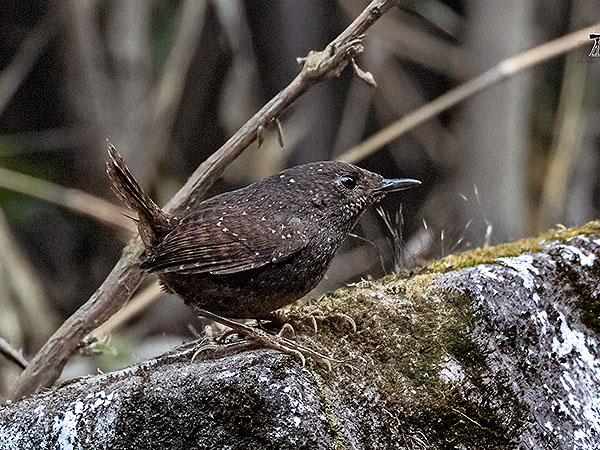
https://www.inaturalist.org/people/udayagashe
https://creativecommons.org/licenses/by-nc/4.0/
*********************
References:
[1] Per Alström; Daniel M. Hooper; Yang Liu; Urban Olsson; Dhananjai Mohan; Magnus Gelang; Hung Le Manh; Jian Zhao; Fumin Lei; Trevor D. Price: Discovery of a relict lineage and monotypic family of passerine birds. Biology Letters 10(3): 1-5. 2014
[2] Jon Fjeldså; Les Christidis; Per G. P. Ericson: The Largest Avian Radiation: The Evolution of Perching Birds, or the Order Passeriformes. Lynx Edicions 2020
*********************
edited: 09.10.2023
Birds unknown – the Grande Comore Blue Vanga
Grande Comore Blue Vanga (Cyanolanius comorensis ssp. bensoni Louette & Herremans)
***
This taxon, described in 1982, is thought to inhabit, or to have inhabited, the island of Grande Comore, Comoros in the Indian Ocean; it is, however, known from only a single somewhat doubtful specimen that was collected as late as 1981.
Here is an excerpt from the original description.:
“In bill length intermediate between C. m. madagascarinus and comorensis; total culmen 18.5 mm as against an average of 17.3 in both sexes of madagascarinus and 20.1 mm in both sexes of comorensis. Bill decidedly more robust than in madagascarinus, although not much longer. In plumage in all respects seemingly nearest to comorensis although there is no similar aged specimen of this race available.“
“Apart from the diagnosis of bensoni, the following is a fuller description of the holotype (not fully adult):- Upperparts lilac blue, crown somewhat darker, with a few bright blue (adult) feathers appearing on crown and mantle. Inner webs of inner secondaries blue, like outer webs (like comorensis, inner webs not black as in madagascarinus). Underparts white, a few buffish feathers on flanks. Black mask just starting to appear. Tail feathers with square tips, not pointed as in very young specimens of Cyanolanius, and with buffish fringes. Iris pale blue. Legs grey-blue. Bill with pale base to both mandibles, tips dark. One may conclude that bensoni agrees well with comorensis in plumage characteristics but has a definitely less robust bill, intermediate in size between the 2 other races. Some doubt may persist as to the bill size in the adult, but I have measurements from 4 immatures of madagascarinus (mounted) in RNL, certainly somewhat younger than the holotype of bensoni, averaging 17.1 (versus 17.3 in the adult, see above) showing that this possible difference is insignificant.”
***
This sole specimen may represent a stray from the nearby island of Mohéli, which is home to the nominate race of the Comoros Blue Vanga (Cyanolanius comorensis (Shelley)), or it may indeed constitute a member of a distinct endemic population. If there indeed ever was a population of Blue Vangas living on Grande Comore, it must now be extinct.
There is also another mystery – why are there no Blue Vangas to be found (at least today) on the islands of Anjouan and Mayotte which in fact lie between Mohéli and Madagascar?
*********************
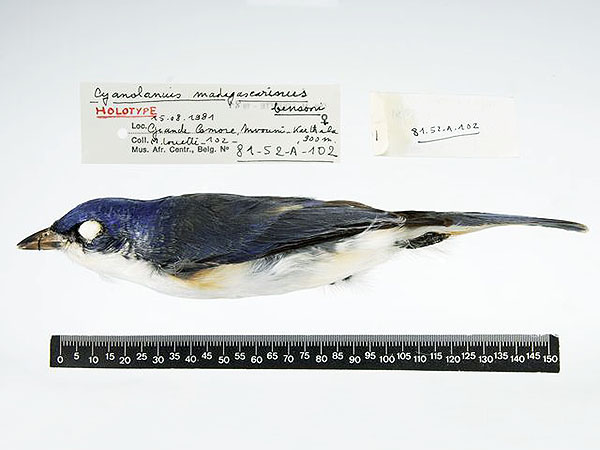
Photo: RMCA, Tervuren
https://creativecommons.org/licenses/by-nc-sa/3.0/
*********************
References:
[1] M. Louette; M. Herremans: The Blue Vanga Cyanolanius madagascarius on Grand Comoro. Bulletin of the British Ornithologists’ Club 102(4): 132-135.1982
*********************
edited: 04.10.2023
Mo’ora-‘ura and toroa – a red duck and a surf duck from Tahiti?
In ancient times, Tahitians believed that several of their Gods and other celestial beings would show themselves to the human eye in form of an animal, a so-called ata and Teuira Henry [see also here] lists some of them, among them also three kinds of ducks.:
“Red-feathered duck (mo‘ora-‘ura), ata of ‘Orovehi‘ura (‘Oro in his manifestation of Red-feather-covered).
Wild duck (mo‘ora-ōviri), ata of “sylvan elves.”
Surf duck (toroa), ata of Hau, god of peace.” [1][3]
The ‘Wild duck’, mentioned here, is the Pacific Black Duck (Anas superciliosa J. F. Gmelin) which is the only duck species known from French Polynesia at all, so what are the other two ‘ducks’?
“The most showy headdress worn officially by the king and princes and high chiefs was the taumi, a superb helmet made of clusters of crimson feathers of the moora ‘ura (red-feathered duck), set upon a light framework and covering the head like a bird, with a glossy terminal behind of outspreading red, black, and white feathers tastily mixed together.” [1][3]
A taumi, however, actually is a gorget decorated with feathers, a feathered helmet was called fau.:
“Henry gives a description of a headdress which has some characteristics of a fau, but which seems to be a mixture of remembered types, further confused by the use of the name taumi, which we know was a gorget:” [4]
The fau was also decorated with several of the elongated tail feathers of tropicbirds (as you can see in the depiction, in which they are from the White-tailed Tropicbird (Phaethon lepturus ssp. dorotheae Daudin)).
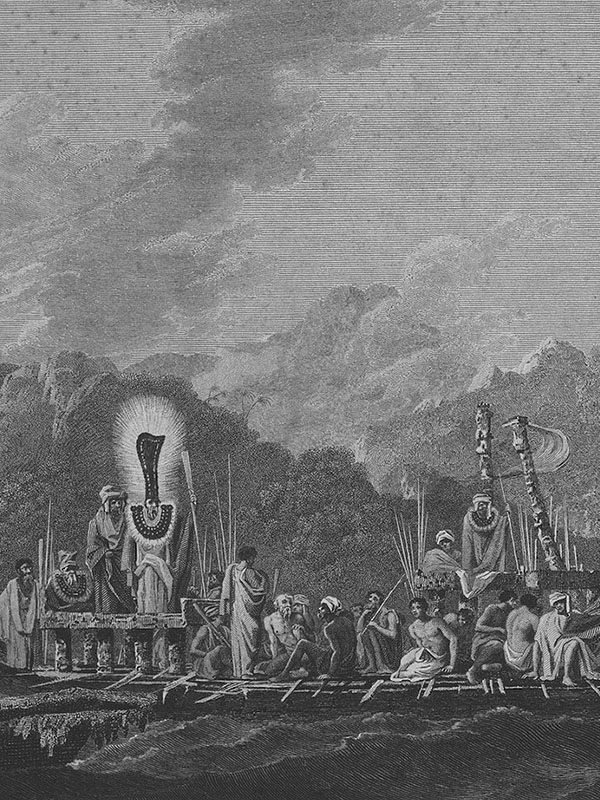
Depiction from: ‘William Hodges: The fleet of Otaheite assembled at Oparee, 1777’
(public domain)
*********************
A little update here:
A “surf duck” apparently is nothing but an albatross (Diomedea spp.), a bird that is well known to the Polynesians, even in the tropical parts of the region. [2]
*********************
References:
[1] Teuira Henry: Ancient Tahiti. Bishop Museum Bulletins 48: 1-651. 1928
[2] Kenneth P. Emory: Tuamotuan bird names. The Journal of the Polynesian Society 56(2): 188-196. 1947
[3] Douglas L. Oliver: Ancient Tahitian Society. The University Press of Hawai’i, Honolulu 1974
[4] Karen Stevenson; Steven Hooper: Tahitian fau – unveiling an enigma. Journal of the Polynesian Society 116(2): 181-212. 2007
*********************
edited: 31.07.2023
Did parakeets once inhabit the Tuamotu Islands?
Parakeets of the genus Cyanoramphus are known to once have existed in French Polynesia, namely on the Austral- and the Society Islands. Is it possible that one or more species of that genus once also have existed on the Tuamotu Archipelago?
Well, actually, it absolutely is, but there is yet no actual indication of it; or maybe there is one …:
In a count of Tuamotuan bird names from the 1940s the name petea is given as coming “from an informant in the western Tuamotus, who said it was like the petea of Tahiti.” [1] and that is probably the name of a parakeet. Maybe this informant just gave that name and told the author that it is given to a long-tailed bird that is also found on Tahiti, who knows?
Well, a short check informs us that petea or rather pete’a is indeed a Tahitian bird name but actually for the White-tailed Tropicbird (Phaethon lepturus ssp. dorotheae Mathews) which in fact is not a parakeet, unfortunately.
***
So, while the former occurrence of parakeets on at least some of the atolls and islands in the giant Tuamotuan Archipelago seems absolutely possible, we have yet no real proof of that … and probably never will.
But we can let our imagination run wild, why not?!
*********************
References:
[1] Kenneth P. Emory: Tuamotuan bird names. The Journal of the Polynesian Society 56(2): 188-196. 1947
*********************
edited: 07.07.2023
Acrocephalus sp. BMNH 1846.7.29.6
The British Museum of Natural History is apparently housing a reed-warbler specimen that is sister to the Leeward Islands Reed-Warbler (Acrocephalus musae (J. R. Forster)) , a now extinct species that occurred with two subspecies on the islands of Huahine and Ra’iatea in the leeward group of the Society Islands.
However, this single specimen appears not to be identical to either of the two known subspecies and was proposed to be classified as “A. musae subsp. (Leeward Islands), with uncertainty regarding the island and subspecies.” [1]; it might indeed represent another, third subspecies that had been collected from another island within the leeward group.
*********************
References:
[1] Alice Cibois; Jean-Claude Thibault; Eric Pasquet: Molecular and morphological analysis of Pacific reed warbler specimens of dubious origin, including Acrocephalus luscinius astrolabii. Bulletin of the British Ornithologist’s Club 131(1): 32-40. 2011
*********************
edited: 05.07.2023
Landbirds of the Brazilian Atlantic islands
In the Atlantic Ocean are three groups of islands that are politically part of Brazil and about which little seems to be known: the Fernando de Noronha Archipelago and the Rocks of Saint Peter and Saint Paul, both located near the equator and Trindade & Martim Vaz near the southern 20th parallel.
Interestingly, as many as four land bird species are known from these archipelagos, of which at least three are truly native and endemic: the Noronha Olive Tyrant (Elaenia ridleyana Sharpe) (Tyrannidae), the extinct Noronha Rail (cf. Rallus sp.) (Rallidae), the Noronha Vireo (Vireo gracilirostris Sharpe) (Vireonidae) and the Noronha Eared Dove (Zenaida auriculata ssp. noronha Sharpe) (Columbidae), all native to the largest archipelago, Fernando de Noronha.
***
There are also two more or less hypothetical forms for the second largest archipelago, Trindade & Martim Vaz: a pigeon form mentioned only by one of the first visitors to Trindade island at the end of the 17th century:
“In 1698 Dr. Halley visited the island, and says he found nothing living but doves and land-crabs.” [1]
And, for the time being, purely hypothetical but very probable, a rail, also for this one island.
***
No serious excavation appears to have taken place on any of the islands, such excavation would almost certainly unearth other bird forms that are now extinct.
*********************
References:
[1] R. Davis: Real Soldiers of Fortune. Charles Scribner’s Sons, New York 1906
[2] Robert Cushman Murphy: The birdlife of Trinidad Islet. The Auk 32(3): 332-348. 1915
[3] S. L. Olson: Natural history of vertebrates on the Brazilian islands of the mid South Atlantic. National Geographic Society Research Reports 13: 481-492. 1981
[4] Ruy José Válka Alves; Nílber Gonçalves da Silva: Três Séculos de História Natural na Ilha da Trindade com Comentários Sobre Sua Conservação. Smashwords 2016
*********************
edited: 05.07.2023
Zealandornis relictus Worthy et al.
Dieser Vogel lebte in Neuseeland vor 19 bis 16 Millionen Jahren, ist bisher aber nur anhand eines Knochenbruchstücks bekannt.
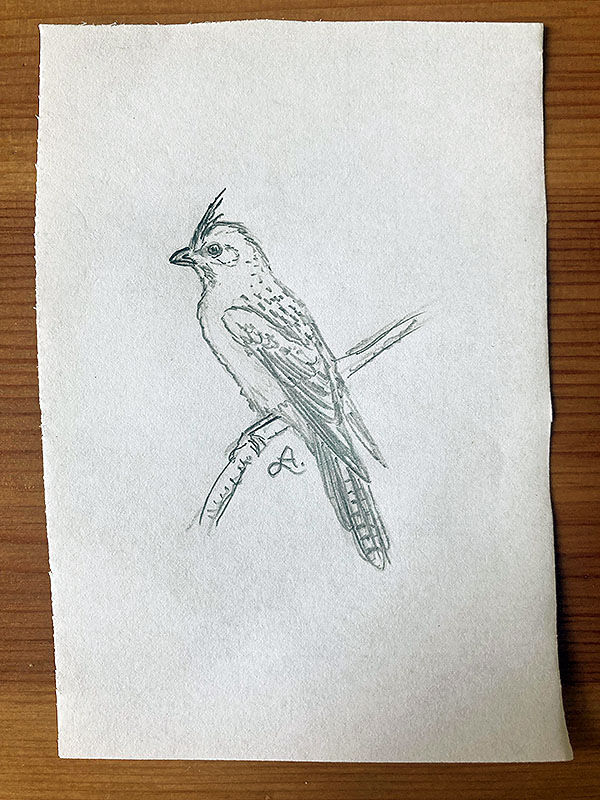
*********************
Quelle:
[1] Trevor H. Worthy; R. Paul Scofield; Steven W. Salisbury; Suzanne J. Hard; Vanesa L. De Pietri; Michael Archer: Two new neoavian taxa with contrasting palaeobiogeographical implications from the early Miocene St Bathans Fauna, New Zealand. Journal of Ornithology http://dx.doi.org/10.1007/s10336-022-01981-6. 2022
*********************
bearbeitet: 08.03.2022
Zealandornithidae – eine neue fossile Familie neuseeländischer Vögel
Es ist eine einigermaßen bekannte Tatsache, dass Neuseeland auch heute noch einige Reliktpopulationen ansonsten längst ausgestorbener Lebensformen beherbergt, dies war aber bereits in der Vergangenheit so.
Die fossile Fauna der St Bathans-Fundstelle hat nun eine weitere solche Reliktlinie hervorgebracht, die Familie der “Zealandia-Vögel”, benannt anhand eines distalen Endstücks eines Humerus eines Vogels, der sich keiner bekannten Familie zuordnen lässt (Zealandornis relictus Worthy et al.). [1]
Dieser Vogel dürfte in etwa die Größe eines durchschnittlichen Finken erreicht haben und könnte mit den Mausvögeln verwandt gewesen sein, ohne dabei zu den Mausvögeln selbst zu gehören. Es ist möglich, dass seine Familie gondwanischen Ursprungs ist und in Neuseeland ihr letztes Refugium gefunden hatte, oder, wie etliche andere neuseeländische Vogelformen auch, ursprünglich aus Australien zugewandert ist. Wie so oft gilt auch hier, es sind weitere Funde notwendig um genauere Angaben zum Aussehen und zu den Verwandtschaftsverhältnissen dieser Art/Familie zu machen. [1]
Eine Rekonstruktion ist derzeit nicht wirklich möglich, bzw. wäre rein spekulativ.
*********************
Quelle:
[1] Trevor H. Worthy; R. Paul Scofield; Steven W. Salisbury; Suzanne J. Hard; Vanesa L. De Pietri; Michael Archer: Two new neoavian taxa with contrasting palaeobiogeographical implications from the early Miocene St Bathans Fauna, New Zealand. Journal of Ornithology http://dx.doi.org/10.1007/s10336-022-01981-6. 2022
*********************
bearbeitet: 08.03.2022
Todus pulcherrimus Sharpe
Schöner Todi (Todus pulcherrimus Sharpe)
Von dieser ‘Art’, beschrieben im Jahr 1874, habe ich gestern überhaupt zum allerersten Mal gehört, sie ist offenbar nur anhand eines einzigen Exemplars bekannt, dessen Herkunft nicht gesichert zu sein scheint.:
“Hab. Jamaica [?]” [1]
Dieses eine Exemplar befindet sich offenbar im British Museum in London, Großbritannien und unterscheidet sich von allen bekannten Todi-Arten durch die eher bläulich als grün gefärbten Oberseite sowie die kräftig gefärbte Unterseite (siehe Darstellung).
***
Bei diesem mysteriösen Vogel soll es sich aber um einen aberrant gefärbten Breitschnabeltodi (Todus subulatus Gray) handeln, einer Art, die von der Insel Hispaniola stammt.
*********************
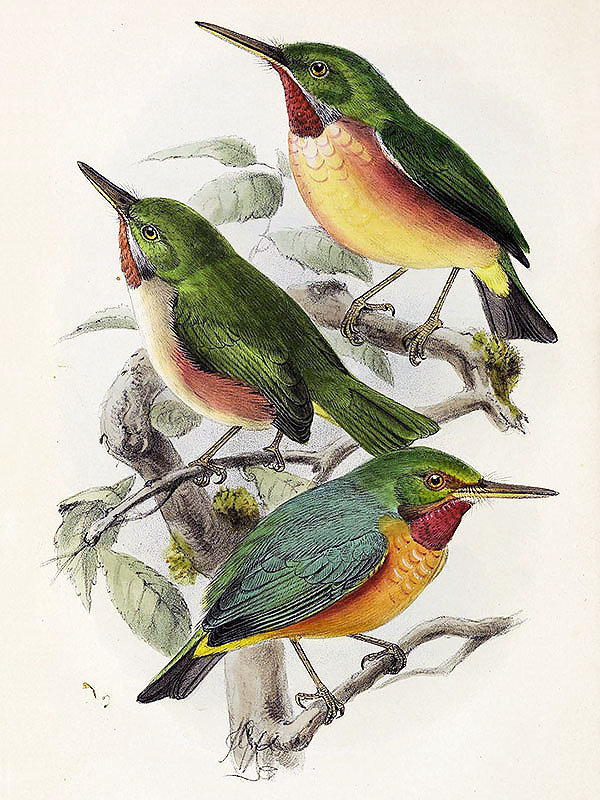
Darstellung aus: ‘R. Bowdler Sharpe: On the genus Todus. The Ibis 3(4): 344-355. 1874’
(public domain)
*********************
Quelle:
[1] R. Bowdler Sharpe: On the genus Todus. The Ibis 3(4): 344-355. 1874
*********************
bearbeitet: 18.02.2022
What is/was Strix parvissima Ellman?
“Little Owl (Ruruwekau), Strix parvissima. A very scarce bird, not larger than a starling. The head is very large. I have never obtained a specimen, but have seen it among the forests. It is an exceedingly shy bird.” [1]
***
“In this division there is a most remarkable little owl, the smallest in the world. It is known to the natives as the ruru wekau; it has an unusually large head, flies by day, is exceedingly shy, and is about half the size of the common ruru. It inhabits dense forests.” [2]
***
“No. 6. – Strix parvissima, Ellman. (Zool., 1861)
Little Owl
Amongst the desiderata of our collections the Little Owl has for some time held a place; many doubt its existence, few have seen it, still fewer have preserved any note or observation concerning it. From the information that has been gleaned about this rare bird, it would appear that its habitat must be the bushes about the Rangitata River [Canterbury Region, South Island].
One correspondent saw it on the bank of a creek at no great distance from Mount Peel Forest, it was between the roots of a large tree; observation was drawn to it by the proceedings of several tuis, who were persecuting it to the best of their ability; it was whilst its attention was engaged by these noisy assailants that the bird was secured. It was about the size of a kingfisher, and its captor felt quite certain of its being an adult specimen; it was carried home to be shown as a curiosity, and was afterwards liberated. Unlike the more-pork, when captured it was exceedingly gentle.
Another specimen was procured by a gentleman in one of the bushes far above the Rangitata Gorge; on being observed on a branch of a tree, it was knocked down and caught during its fall; there was fur on its beak, as though it had not long before devoured a mouse; this bird was also set at liberty.
Two other instances of its occurrence have been communicated, but without further information. It may be mentioned that one of these was again on the Rangitata.
At Shepherd Bush Station, on the Rangitata, opposite Peel Forest, a specimen was observed in the house, greatly resembling A. Novae Zelandiae [ruru (Ninox novaeseelandiae)], except in size, which was about that of a kingfisher; it was most gentle in its habits, remaining quiet during the daytime and sallied forth in the evening, regaining its perch by entering through a broken window. This pretty little visitor thus frequented the house for about a fortnight; it should be added that the house stands close to a small bush composed chiefly of Leptospermum, Griselinia, etc., of which there are many aged specimens.
From these notices it may be safely inferred that the Little Owl is arboreal in its habits, and possibly not so strictly nocturnal as its better known congeners; whether it is to be considered identical with either of the species referred to by Dr. Finsch is, of course, at present unknown; it is certain it is not a tufted species, or such a remarkable form would have been noticed.” [3]
***
What can we make of this little owl that apparently once existed in New Zealand?
Are these accounts referring to an actual owl or rather to some other bird, maybe even to a last surviving population of the New Zealand Owlet-Nightjar (Aegotheles novaezealandiae (Scarlett))?
This nightjar species is known only from subfossil remains that date to 1200 AD and which usually are not found in association with Maori middens, it was also not necessarily a small bird and may have been quite the same size as the ruru and only slightly smaller than the larger whēkau (Ninox albifacies); furthermore it is thought to have been flightless or at least nearly so.
There is, however, a slight chance that these eyewitness accounts indeed refer to a last surviving population of this now extinct creature, we will probably never know for sure.
*********************
References:
[1] J. B. Ellman: Brief Notes on the Birds of New Zealand. The Zoologist 19: 7464-7473. 1861
[2] J. B. Ellman: Correspondence. The Press 3(136): 2. 1863
[3] T. H. Potts: On the birds of New Zealand (Part II.) Transactions and Proceedings of the New Zealand Institute 3: 59-109. 1870
*********************

Depiction: Paul Martinson
under creative commons license (4.0))
https://creativecommons.org/licenses/by-nc-nd/4.0/
*********************
edited: 05.11.2021
The Manumea
There is probably no other bird on this planet that comes more closely to what could be called a cryptid than the Manumea, the Tooth-billed Pigeon (Didunculus strigirostris (Jardine)) of Samoa.
The species is known to inhabit, or at least to have inhabited, the rainforests of the islands of Nu’ulua, Savai’i and ‘Upolu, Western Samoa; in prehistorical times it was even more widespread. Nearly nothing is known about this species: the breeding behavior is still unknown, the same more or less applies to basically all of the bird’s habits.
As far as I know there are only about five or so photos of living individuals of the species, most of them, if not all, show the same bird that was kept in captivity for some time.
The latest sightings were of a juvenile bird in 2013, which also was photographed; than a bird was seen and heard calling in 2020, however, no photo had been taken this time. [1]
***
The Manumea is currently not kept in captivity and the wild population is estimated to be less than 100 – to about 300 birds, that’s not much and the species is in immediate danger of extinction.
Wouldn’t it be phantastic if even only a fraction of the amounts of money that are spend to prove the existence of such phantasy creatures like Bigfoot, Chupacabra or Mokele Mbembe would be used for something useful, for the search for the Manumea, for the rescue of this enigmatic yet indeed existing bird?!
*********************
References:
[1] Sapeer Mayron: Near-extinct manumea spotted in Savai’i. Samoa Observer 25/08/2020
*********************

(public domain)
*********************
edited: 03.11.2021
Are there Maori traditions about the extinct Moa(s)? part: 2
The Maori, the indigenous people of Aotearoa (New Zealand), have a very rich oral tradition that actually dates back to the time when their ancestors first arrived at the shores of the islands!
These traditions, however, have greatly been influenced by Europeans settlers, especially by missionaries, who tried to destroy the Maori by banning everything Maori: traditional clothing, traditional musical instruments, songs, religious beliefs, even the Maori language itself, everything was banned and violations were punished severely.
No one can say how much knowledge was destroyed during these times.
“…
Kotahi tonue tama
Te tiaki whenua,
Ko te kuranui,
Te manu a Rua-kapanga,
Itahuna e to tupuna, e Tamatea
Ki te ahi tawhito,
Ki te ahi tupua,
Ki te ahi na Mahuika.
Na Maui i whakaputa ki te ao
Ka mate i whare huki o Repo-roa,
Ka rere te momo, e tama e!“
This is the end part of a large Maori poem that can be dated back to the 14th century, around the time when the first Maori settlers arrived at the shores of Aotearoa (New Zealand).
The poem mentions the kuranui, the bird of Rua-kapanga, which is said to have been the first person to have spotted the bird; te kuranui might be translated as ‘the large red one’, ‘the large precious one’ or maybe as ‘the most precious one’.
Furthermore it also informs us about the fate of these kuranui(s): “… destroyed by your ancestor, Tamatea, with underground and supernatural fire, the fire of Mahuika (a fire goddess), brought to this world by Maui; they were driven into the swamps and perished …” [1]
*********************
References:
[1] Otto Krösche: Die Moa-Strausse, Neuseelands ausgestorbene Riesenvögel: Die neue Brehm-Bücherei 322. A. Ziemsen Verlag 1963
*********************
edited: 02.11.2021
Pā-Tangaroa – an extinct starling from the island of Mangaia?
Nowadays there is only one single species of starling in central Polynesia, the Rarotonga starling (Aplonis cinereacsens Hartlaub & Finsch), which occurs exclusively on the island of Rarotonga, the largest of the Cook Islands; another form, the Plain Starling (Aplonis mavornata Buller), itself a mystery for over a century, came from another of the Cook Islands, namely Ma’uke.
So, it’s pretty certain that other forms were once found on other islands in this archipelago, right?
I just found a clue in this direction when I was writing down the names from a list of birds compiled in the early 20th century by someone named F. W. Christian; this list is part of a kind of dictionary of the Mangaian dialect, the dialect spoken on the island of Mangaia, the southernmost and second largest of the Cook Islands.
Here a list of the bird names.:
“Pā-Tangaroa. – A speckled bird; somewhat larger than the Kere-a-rako. Frequents coconut palm blossoms.
Tangaa-‘eo. – The native Wood-pecker; blue above, yellow and white below.
Kere-a-rako. – A small yellow and green song-bird much resembling a canary.
Titi. – A bird living in the rocks and crags. Much relished for food. Cf. Maori Titi, the Mutton-bird. Sanskrit and Hindustani, Titti: Tittiri, the Partridge.
Mokora’a. – The Wild Duck, or rather, a small species of teal, found in abundance round Lake Tiriara.
Kauā. – A sea-bird.
Rakoa. – A sea-bird.
Torea. – A sea-bird.
Kotuku. – The Blue Heron.
Kakaia. – A beautiful small white tern or sea-gull.
Kotaa. – The Frigate or Boatswain Bird. Cf. Samoa, A ta fu,; id. Fijian, Kandavu; id. Uleai (W. Carolines) Kataf; id. Sonserol (S. W. Caralises) Gatyava; id. Cf. Sanskrit Gandharva, a celestial messenger: angel.
Tavake. – The Tropic Bird (Phaethon). Called in the Marquesas Tavae-ma-te-ve’o, from its two long red tail-feathers. Used in Polynesian head-ornaments. Cf. Ponape Chaok: Chik; id. Cf. Sanskrit Stabaka, Stavaka a peacock’s feather: tuft: plume.
Kara’ura’u. – A sea-bird.
Kururi: Kuriri. – The Sand-Piper.
Karavi’a. – The Long-tailed Cuckoo.
Kura-mō. – A small Parrakeet (on Atiu).” [1]
The respective scientific names of the birds.:
Pā-Tangaroa. – ?
Tangaa-‘eo. – Todiramphus ruficollaris
Kere-a-rako. – Acrocephalus k. kerearako
Titi. – Pterodroma nigripennis
Mokora’a. – Anas superciliosa
Kauā. – Numenius tahitiensis
Rakoa. – Puffinus lherminieri
Torea. – Pluvialis fulva
Kotuku. – Egretta sacra
Kakaia. – Gygis alba
Kotaa. – Fregata spp.
Tavake. – Phaethon rubricauda
Kara’ura’u. – Procelsterna cerulea
Kururi: Kuriri. – Tringa incana
Karavi’a. – Eudynamis taitensis
Kura-mō. – Vini kuhlii
***
All of these names can be assigned to actually existing bird species, with one exception – the first name.
So which species is hiding behind the name Pā-Tangaroa?
This is actually a rather unusual name for a Polynesian bird, and the reference to Tangaroa, one of the most important Polynesian gods, is very interesting. Perhaps a bird with such a name was also considered God-like or sacred, or at least as being tapu.
The description of this bird: speckled and slightly larger than the Kerearako (i.e. larger than 16 cm), often found on coconut flowers, fits a star of the genus Aplonis quite well, in fact it suits this genus more than any other genus in question.
So there was almost certainly once a star of the genus Aplonis that lived on the island of Mangaia, and its subfossil bones may sooner or later be discovered; the question is, did the species survive long enough that locals could at least remember that it was called Pā-Tangaroa? Given that research into the fauna and flora of the Cook Islands didn’t begin until the early 20th century … it is entirely possible!
***
I should also mention that this listing, which dates back to 1920, already mentions the Cook Island reed warbler (Acrocephalus kerearako Holyoak), which was not officially discovered until 1973 (and described a year later). [2]
*********************
References:
[1] F. W. Christian: List of Mangaia birds. The Journal of the Polynesian Society 29(114): 87. 1920
[2] D. T. Holyoak: Undescribed land birds from the Cook Islands, Pacific Ocean. Bulletin of the British Ornithologists’ Club 94(4): 145-150. 1974
*********************
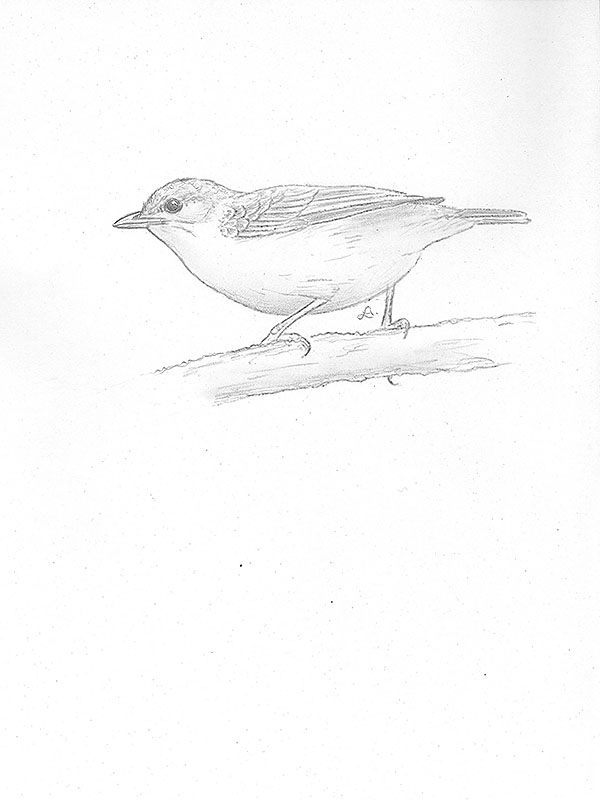
*********************
edited: 01.11.2021
Are there Maori traditions about the extinct Moa(s)?
This is a very interesting question that was asked by many scientists – what does Maori lore tell us about the now extinct megafauna of New Zealand? The results of all previous investigations are rather sobering, all so-called traditional accounts seem to date to the time following the arrival of the Europeans in New Zealand.
I want to mention only one of them here.
The first account dates from the middle of the 19th century.:
“The natives speak of another member of this family, which they name the kiwi papa whenua, a still larger species, which they describe as having been full seven feet high; it likewise had a very long bill, with which it made large holes in the ground, in search after worms. This bird is now extinct, but there are persons living who have seen it. Rauparaha told me he had eaten it in his youth, which might be about seventy years ago [ca. 1785], and when that Chief died, his corpse was said to have been ornamented with some of its feathers.” [1]
***
This second account refers to the first one and was made just ten years later.:
“Kiwi Papa Whenua. Seven feet [ca. 2 m] high. One of the last birds to disappear. There are still men who have hunted it.” [2]
***
The Kiwi papa whenua accounts may indeed refer to one of the smaller or middle-sized moa species, one that was about 2 m tall and that may have survived longer than most of the other moa species, but probably not into the early- or middle 18th century; it might thus be referring to the so-called Upland Moa (Megalapteryx didinus (Owen)), a species that officially died out around 1500 AD.. However, when reading the first account, it is very clear that this description has been mixed with that of a typical kiwi, thus it is quite clear that these accounts are no eyewitness reports.
The term Kiwi papa whenua might be translated as ‘Ground kiwi’ or maybe ‘Kiwi of the land’ which is not very meaningful. It is furthermore rather unlikely that the Maori would have connected the diurnal, rather large, long-necked moa species with the completely distinct kiwi(s), thus it is very unlikely that the term ‘kiwi’ would have been used for any of these species.
Nevertheless, such old accounts remain very interesting, and I will go on posting more of them in the future.
*********************
References:
[1] Richard Taylor: Te Ika a Maui: or, New Zealand and its inhabitants, illustrating the origin, manners, customs, mythology, religion, rites, songs, proverbs, fables, and language of the natives: together with the geology, natural history, productions, and climate of the country; its state as regards Christianity; sketches of the principal chiefs, and their present position; with a map and numerous illustrations. London: Wertheim and Macintosh, 24, Paternoster-Row. 1855
[2] J. B. Ellman: Brief Notes on the Birds of New Zealand. The Zoologist 19: 7464-7473. 1861
*********************
edited: 01.11.2021
Komako – The Mangareva Reed Warbler
The Mangareva Reed Warbler (Acrocephalus astrolabii Holyoak & Thibault), only described in 1978, is one of the many mysterious birds whose cases were solved only quite recently.
The species was restricted to the Gambier Islands, where it was at least found on the biggest of the islands, Mangareva.
The species disappeared sometimes during the early or middle 19th century, but the natives still recalled the former presence of it and were also still using its name.:
“She [the daughter of the Chief of the island of Taravai] has not seen the “Komaku” herself, but her father, the Chief, has. He gave us the name and says he saw them about thirty or forty years ago.” [1]
***
The species apparently died out sometimes around the middle 19th century; it is, however, possible that it survived into the middle of the 20th century …:
“Signalons aussi qu’une fauvette fut observée sur l’îlot Tepapuri en 1971 (Thibault, 1973b). Ce dernier oiseau, blanchâtre dessus et brun dessous, devait être un erratique de la forme habitant, les atolls au nord des Gambier, A. caffer ravus.“ [2]
translation:
“Note also that a warbler was observed on Tepapuri islet in 1971 (Thibault, 1973b). This last bird, whitish above and brown below [I’m quite sure that it should be exactly reversed], must have been an erratic of the form inhabiting the atolls north of the Gambier, A. caffer ravus.”
I somewhat doubt that assumption, and this account may indeed be the very last sighting of a Mangareva Reed Warbler that took place on one of the northernmost motu of the Gambier Island’s fringing reef.
*********************
References:
[1] Whitney South Sea Expedition of the American Museum of Natural History: Voyage of the ‘France’ from Timoe Atoll to the Mangareva Islands; Voyage to Marutea. April 25 – May 14, 1922. Extracts from the Journal of Ernest H. Quayle; Assistant Field Naturalist. Book XXV through Book XXVIII. April 1 – June 24, 1922
[2] D. T. Holyoak; J.-C. Thibault: Contribution à l’étude des oiseaux de Polynésie orientale. Mémoires du Muséum national d’histoire naturelle 127(1): 1-209. 1984
[3] Alice Cibois; Jean-Claude Thibault; Eric Pasquet: Molecular and morphological analysis of Pacific reed warbler specimens of dubious origin, including Acrocephalus luscinius astrolabii. Bulletin on the British Ornitologists’ Club 131(1): 32-40. 2011
*********************
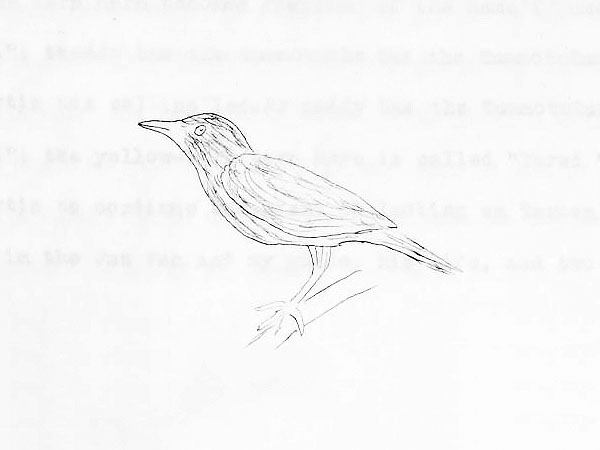
https://creativecommons.org/licenses/by-nc-sa/4.0/
*********************
edited: 08.08.2021
Mangareva Kingfisher
The Mangareva Kingfisher still is one of the most enigmatic birds I am aware of so far.
The species inhabited the Gambier Islands, and another species occurring 1000s of km to the northwest of it, the Niau Kingfisher (Todiramphus gertrudae Murphy), is still officially assigned to this bird as a subspecies.
I have desperately tried to find the original description of this species, and here it is.:
“Il existe, en effet, depuis longtemps dans les galeries du Muséum un Martin- pêcheur qui a été rapporté en 1841 de Mangarewa (archipel Gambier) par l’Astrolabe (Voyage au Pôle Sud) et qui répond exactement à la description et à la figure de l’Halcyon Reichenbachi. Cet oiseau a le sommet de la tête d’un roux qui va en s’éclaircissant et tire au blanc jaunâtre du côté, du front, mais qui est assez intense sur le vertex où se détachent quelques plumes vertes. Sur les oreilles il existe aussi, de chaque côté une tache verte, passant au noirâtre en arrière et tendant à rejoindre une bande noire qui fait le tour de l’occiput. Cette bande foncée limite en dessus un large collier blanc, un peu sali par quelques taches noires, qui se fond sur les côtés dans la teinte blanche qui couvre toutes les parties inférieures du corps, les flancs seuls offrant un peu de roux et encore sur des points cachés entièrement par les ailes. Celles-ci sont d’un vert légèrement bleuâtre, avec des lisérés roux très fins au bord des couvertures alaires. La queue est également d’un vert bleuâtre au milieu, d’un vert mélangé de grisâtre sous lespennes externes, qui sont d’ailleurs incomplètes. Enfin le bec est noir et la mandibule, inférieure blanche ou plutôt jaunâtre dans toute sa portion basilaire. Les pattes sont d’un m brun foncé. La longueur totale de l’oiseau est de 0,170; l’aile mesure 0,090, la queue 0,880, le bec 0,018; le tarse 0,014. Dès 1889, en faisant une revision des Alcédinidés du Muséum en vue de leur instal- lation dans les nouvelles galeries, j’avais désigné ce Martin-pêcheur de Mangarewa sous le nom d” Halcyon Gambieri; mais je n’en avais pas publié la description jusqu’à ce jour.” [1]
translation:
“For a long time, there has been a kingfisher in the galleries of the Museum who was brought back in 1841 from Mangarewa (Gambier Archipelago) by the Astrolabe (Journey to the South Pole) and who exactly corresponds to the description and the figure of Halcyon Reichenbachi. This bird has the top of the head red that brightens to yellowish white on the side of the forehead but is quite intense on the vertex where some green feathers stand out. On the ears there is also, on each side a green patch, passing blackish back and tending to join a black band that goes around the occiput. This dark band has a large white necklace on top, a little dirty with a few black spots, which is melting on the sides into the white hue that covers all the lower parts of the body, only the flanks offering a little russet and are, on some points, hidden entirely by the wings. These are a slightly bluish green, with very fine red rims at the edge of the wing coverts. The tail is also bluish green in the middle, of a green mixed with greyish under the outer feathers, which are also incomplete. Lastly, the beak is black, and the mandible underneath is white or rather yellowish throughout its base portion. The legs are of a dark brown. The total length of the bird is 0,170; the wing measures 0,090, the tail 0,880, the beak 0,018; Tarsus 0,014. As early as 1889, by making a revision of the Alcedinidae of the Museum with a view to their installation in the new galleries, I had designated this kingfisher of Mangarewa under the name of Halcyon Gambieri; but I had not published the description so far.“
***
What I am wondering about most is the fact that the Mangareva – and the Niau Kingfishers still are regarded to as a single species; on the other hand, both forms are rather similar to each other.
Which of the many other Polynesian islands might once have harbored their own kingfisher forms not known to us today?
*********************
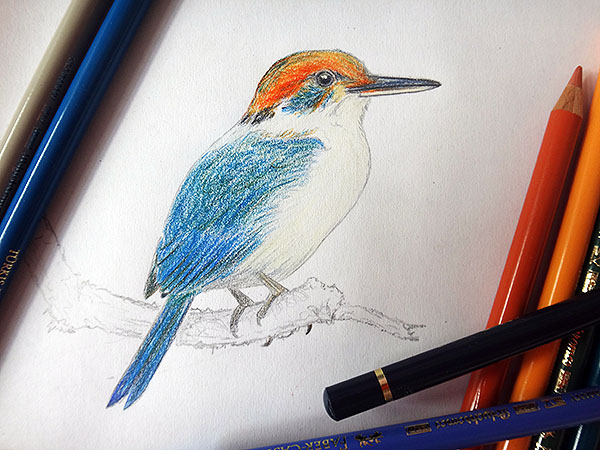
*********************
[1] M. E. Oustalet: Les Mammifères et les oiseaux des iles Mariannes. Nouvelles archives du Muséum d’histoire naturelle 3(7): 141-228. 1895
[2] D. T. Holyoak; J. C. Thibault: Halcyon gambieri gambieri Oustalet, an extinct Kingfisher from Mangareva, South Pacific Ocean. Bulletin of the British Ornithologists’ Club 97(1): 21-23. 1977
*********************
edited: 08.08.2021
Riesentrogon
Riesentrogon (Trogon gigas Vieill.)
Ursprünglich ist diese Form wohl anhand von drei oder vier Exemplaren bekannt, über deren Verbleib offenbar nichts bekannt ist.
“Ganze Oberseite, Kehle und Halsseiten glänzend goldgrün, Brust und Bauch weiss; Schwanz oben goldgrün unten graulich-weiss, Flügelmitte fein schwärzlich grün und weiss quergestreift, Schwingen braunschwarz, Schnabel gelb, Füsse braun.” [2]
Der Vogel soll eine Größe von 18 Inches erreicht haben, das entspricht etwas über 45 cm, wirklich sehr groß für einen Trogon; er soll aus Asien stammen, wobei die genaue Herkunft nicht bekannt ist (entweder Java oder Molukken).
***
Der folgende Text stammt von keinem Geringeren als François Le Vaillant (1753-1824).:
“I have only seen three specimens of this fine species; one in the collection of M. Carbintus at the Hague, a second at Rotterdam in the possession of M. Gevers, and another in the large and splendid collection of my friend M. Temminck at Amsterdam. This individual, from which our figure was taken, was sent along with many other birds from Java. I have seen a fourth specimen in the Paris Museum; but as it was in an imperfect state, it has not as yet been placed in the gallery.” [1]
Übersetzung:
“Ich habe nur drei Exemplare dieser schönen Art gesehen; eine in der Sammlung von M. Carbintus in Den Haag, eine zweite in Rotterdam im Besitz von M. Gevers und eine weitere in der großen und prächtigen Sammlung meines Freundes M. Temminck in Amsterdam. Dieses Individuum, anhand dessen unsere Abbildung angefertigt wurde, wurde zusammen mit vielen anderen Vögeln aus Java geschickt. Ich habe ein viertes Exemplar im Pariser Museum gesehen; aber da es unvollkommen war, wurde es noch nicht in die Galerie aufgenommen.“
***
Es könnte sich natürlich um eine tatsächlich existierende Art handeln, die mittlerweile ausgestorben ist; es ist aber durchaus wahrscheinlicher, dass es sich auch hierbei um eine der künstlich zusammengebauten ‘Arten’ handelt, die in den ornithologischen Abhandlungen des F. Le Vaillant aus dem ausgehenden 18. Jahrhundert offenbar gehäuft auftauchen ….
*********************
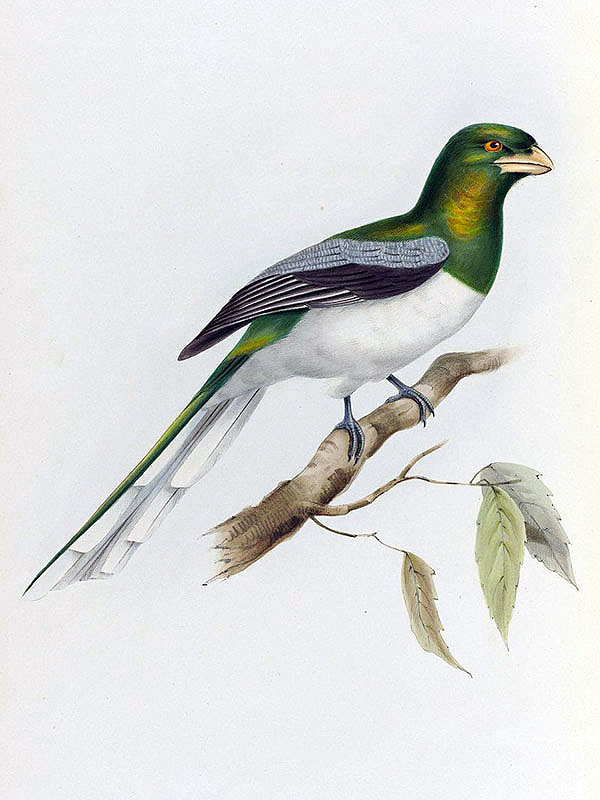
(public domain)
*********************
Quellen:
[1] John Gould: A monograph of the Trogonidae, or family of trogons. London: the author 1835-1838
[2] Jean Louis Cabanis; Ferdinand Heine: Museum Heineanum: Verzeichniss der ornithologischen Sammlung des Oberamtmann Ferdinand Heine, auf Gut St. Burchard vor Halberstadt. Halbertstadt: in Commission bei R. Frantz 1850-1863
*********************
bearbeitet: 01.04.2021
Lady Tavistocks Sittich
Lady Tavistocks Sittich (Barnardius crommelinae Mathews)
Diese eigentlich vollkommen unbekannte ‘Art’ ist nur anhand eines einzigen Exemplars bekannt, eines Weibchens, das offenbar eine Zeitlang im Aviarium des Marquis of Tavistock in Gefangenschaft gehalten und nach dessen Frau benannt wurde. [1]
Es handelt sich hierbei offenbar um einen Barnardsittich (Barnardius barnardi (Vigors & Horsfield)) dem große Teile der gelben Areale fehlen. [2]
*********************
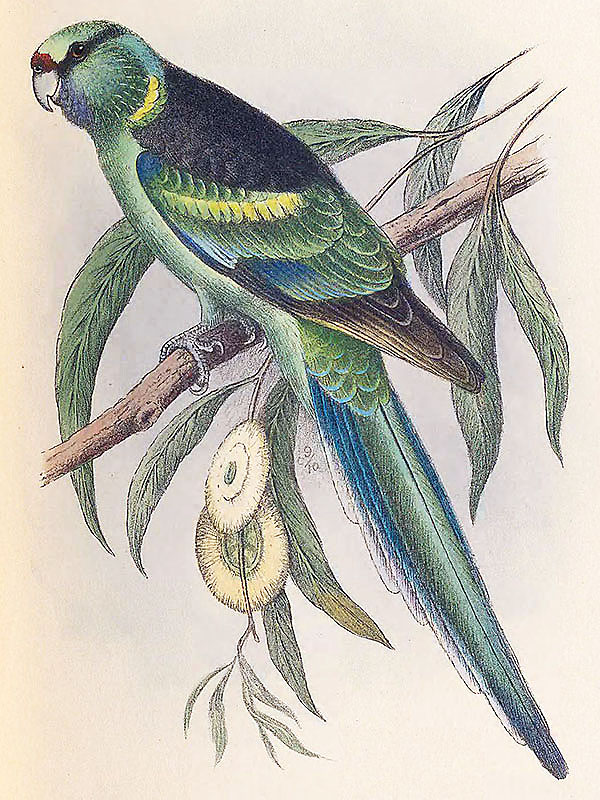
(public domain)
*********************
Quelle:
[1] Gregory M. Mathews: A new form of Barnardius. Bulletin of the British Ornithologists’ Club 46(299): 21. 1925
[2] Julian P. Hume: Extinct Birds. Bloomsbury Natural History; 2nd edition 2017
*********************
bearbeitet: 27.03.2021
Obskurer Papagei
Obskurer Papagei (Psittacus obscurus)
Der so genannte Obskure Papagei, der eigentlich besser Dunkler Papagei heißen sollte wurde ursprünglich im Jahr 1757 durch Fredric Hasselquist bzw. Carl von Linné beschrieben, dies ist die Beschreibung.:
“PSITTACUS (obscurus) niger, vertise cinereonigrescente vario, cauda cinerea.
CAPUT oblongum, lateribus compressum, dorso depressum, respectu corporis satis magnum.
Rostrum totum latum, crassum, obtusissimum, aduncum, capite triplo brevius. Maxilla superior subconvexa, inferius latiuscula, dorsum versus magis contracta, mobilis. Ad basin maxillae superioris infra nares sulcus conspieitur, quasi imbricata esset pergit. Apex maxillae superioris aduncus extra maxillam inferiorem, quo ad quartam sui partem extensus, extremitate obtusiusculus. Lobulus utrinque ad basin apicis, maxillae inferiori dum clauditur os, supra impositum, Maxilla inferior superiore crassior, magis comnvexa, brevior, quantitate apicis superioris, basi subtus gula distans, posterius aequalis; apice obtusa & fere emarginata; sinus semicircularis ad basin apicis. Nares proxime supra rostrum, perfecte circulares, magnitudine pennae gallinaceae.
Oculi vertici quam gulae, naribus etiam quam basi capitis propiores. Iris flava. Pupilla nigra. Area oculorum usque a fine maxillae superioris ad initium verticis latitudine, & a naribus, fere usque ad basin verticis longitudine nuda, rugosa, pilis vix conspicuis obsita.
Aurium apertura oblonga, transversalis, ab oculis aequali spatio, ut oculi a naribus, distans, basi capitis quam vertici multo propior, plumis tenuibus & membrana retractilis tecta.
Remiges circiter 20:1, 2 reliquis longiores; 3, 4, 5, paulo breviores, aequales; 6. 7. 8 ordine decrescentes; reliqui aequales breviores.
CAUDA cuneiformis. Rectrices circiter 10, laterales breviore intermedii longioribus.
PEDES, crura plumosa, usque ad flexuram tarsi.
Digiti 4: antici 2 & postici 2; ex anterioribus internus exteriori tribus articulis brevior est posterioribus, interior exteriori dimidio brevior; omnes digiti squamosi, squamis imbricatis, articulis duobus insimis impositis; reliqua pars pedis tuberculata, tuberculis levibus, circularibus, parum elevatis.
Lingua crassa, apice obtusissima & fere semicirculari, lateribus marginata, marginibus fursum inflexis, unde canaliculata evadit.
Ungues adungi, obtusiusculi.
COLOR: Rostrum nigrum. Area oculorum alba. Vertex ex cinereo & nigrescente variegatus. Colum & Alae supra nigra.
Abdomen & crura cinerea, cum lineis transversalibus canis. Tubercula pedum nigra. Ungues nigri. Cauda tota cinerea.
MAGNITUDO Graculi.” [1]
***
Ich muss gestehen, dass ich meine Übersetzungsversuche hier aufgegeben habe da sie nirgendwohin führten.
Wie dem auch sei, John Latham, der bekannte Autor vieler Vogelbücher des späten 18./frühen 19. Jahrhunderts, führt die Art im 2. Teil seines Werkes “A general history of birds”.:
“SIZE of a Jay. Bill black, the feathers round the base of it black, rough, and beset with hairs; space round the eye white; irides yellow; crown variegated cinereous and black; upper parts of the neck and wings black; belly and thighs cinereous, marked with transverse hoary lines; tail wholly ash-coloured, cuneiform; legs tuberculated, black; toes the same; claws crooked, and black.
Inhabits Africa. The only one who has described this is Hasselquist, from whom Linnaeus had his account; as to that which the latter refers in Brisson, it is quite a different species, and he mentions it as such in his last Mantissa.” [2]
Übersetzung:
“GRÖßE eines Hähers. Schnabel schwarz, die Federn rund um die Basis schwarz, rau und mit Haaren besetzt; Bereich um das Auge weiß; Iriden gelb; Scheitel grau und schwarz variegiert; obere Teile des Halses und Flügel schwarz; Bauch und Oberschenkel grau, markiert mit quer verlaufenden grauen Linien; Schwanz ganz aschfarben, keilförmig; Beine höckerig, schwarz; Zehen gleich; Krallen krumm und schwarz.
Bewohnt Afrika. Der Einzige, der ihn beschrieben hat, ist Hasselquist, von dem Linnaeus seinen Bericht hatte; worauf sich letzterer in Brisson bezieht, so handelt es sich um eine ganz andere Art, und er erwähnt sie in seiner letzten Mantisse als solche.“
***
Der Vogel wird Psittacus genannt und mag mit dem Graupapagei (Psittacus erithacus L.) und dem Timneh-Papagei (Psittacus timneh Fraser) verwandt gewesen sein; aber halt! Nahezu sämtliche Papageien wurden ursprünglich als Psittacus beschrieben, so dass dieser Name ebenfalls nirgendwo hinführt, es ist nicht einmal sicher, dass es sich hier überhaupt um einen Papagei handelt.
*********************
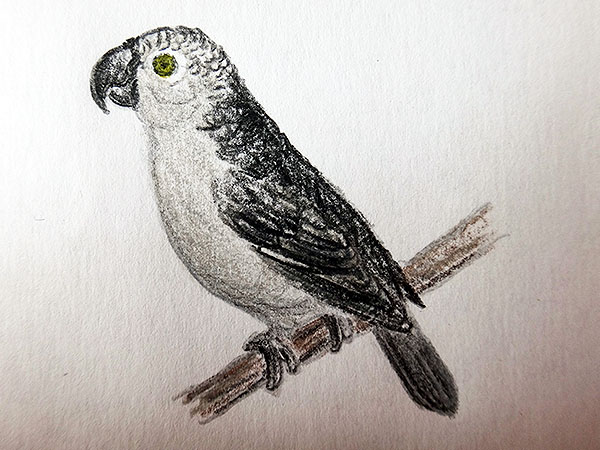
*********************
Quellen:
[1] Fredric Hasselquists: Iter Palæstinum, eller Resa til Heliga Landet, förrättad ifrån år 1749 til 1752, med beskrifningar, rön, anmärkningar, öfver de märkvärdigaste naturalier, på Hennes Kongl. Maj:ts befallning, utgiven af Carl Linnaeus. Stockholm: Trykt på L. Salvii kåstnad 1757
[2] John Latham: A general history of birds. Winchester: printed by Jacob and Johnson, for the author: — sold in London by G. and W. B. Whittaker, Ave-Maria-Lane; John Warren, Bond Street, W. Wood, 428, Strand; and J. Mawman, 39, Ludgate-Street 1821-1828
[3] Julian P. Hume: Extinct Birds. Bloomsbury Natural History; 2nd edition 2017
*********************
edited: 26.03.2021
Purpurnaschvogel
Purpurnaschvogel (Chlorophanes purpurascens Sclater & Salvin)
Diese ‘Art’ wurde im Jahr 1873 beschrieben, es ist nur ein einziges Exemplar bekannt, welches offenbar irgendwo in Venezuela gefunden wurde; einer anderen Quelle zufolge in Trinidad. [1][2]
Es handelt sich hierbei tatsächlich um einen Hybriden mit dem Kappennaschvogel (Chlorophanes spiza (L.)) und dem Türkisnaschvogel (Cyanerpes cyaneus (L.)) als Elternarten. [2]
*********************
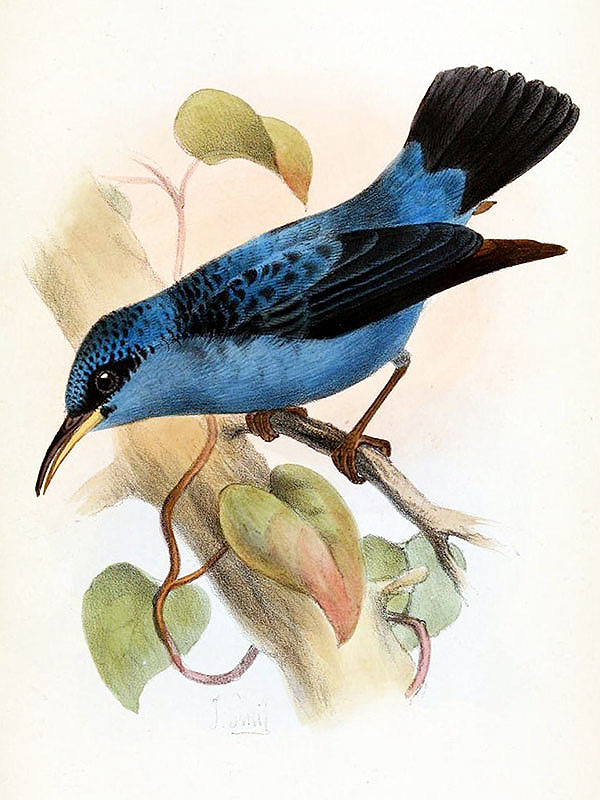
(public domain)
*********************
bearbeitet: 25.03.2021
*********************
Quellen:
[1] Philip Lutley Sclater: Catalogue of the Passeriformes, or perching birds, in the collection of the British Museum. Fringilliformes: part II; containing the families Coerebidae, Tanagridae, and Icteridae. London 1886
[2] Julian P. Hume: Extinct Birds. Bloomsbury Natural History; 2nd edition 2017
Mähnenparadiesvogel
Mähnenparadiesvogel (kein wissenschaftlicher Name)
“LENGTH ten inches. Bill one inch and a quarter long, a trifle bent, and dusky, the base surrounded with velvet-like black feathers, covering the nostrils; top of the head, even with the eye, and to the beginning of the back, deep green, varying to bright green in some lights; the feathers of a plush-like texture; those on the hind part of the neck are long, pointed, and like hackles, but on the chin and throat they are similar to those on the crown, and both appear, in some lights, to be scaly, either indigo or green, and glossy, like metal; on each side of the neck is a stripe of blue, dividing the green above and below, and coming forwards to the breast, where it occupies a broad space; on the middle of the crown arise four bristles, near two inches long, tending backwards; upper part of the back, and wings, greenish black, in some lights appearing quite black; from the breast to the vent deep, dull ash-colour; tail even at the end, and three inches in length, the two middle feathers dull green, pointed at the tips; the others dusky within, and green on the outer webs, and all of them curve a little outwards; legs scaly; claws black, and hooked, though not very stout.
Native place uncertain; in the collection of General Davies.” [1]
Übersetzung:
“LÄNGE zehn Zoll [ca. 25,5 cm]. Schnabel einen Zoll und ein Viertel lang, eine Kleinigkeit gebogen und düster, die Basis von samtartigen schwarzen Federn umgeben, die die Nasenlöcher bedecken; Oberseite des Kopfes, in Augenhöhe, und bis zum Anfang des Rückens, tiefgrün, in bestimmtem Licht bis hellgrün variierend; die Federn von einer plüschartigen Textur; die am hinteren Teil des Halses sind lang, spitz und wie eine Mähne, aber am Kinn und am Hals ähneln sie denen auf dem Scheitel, und beide erscheinen in bestimmtem Licht schuppig, entweder Indigo oder Grün, und glänzend wie Metall; Auf jeder Seite des Halses befindet sich ein blauer Streifen, der das Grün oben und unten teilt und nach vorne zur Brust kommt, wo er einen weiten Raum einnimmt; in der Mitte des Scheitels stehen vier Borsten, die fast zwei Zoll lang sind und nach hinten tendieren; oberer Teil des Rückens und Flügel, grünlich schwarz, in bestimmtem Licht, ziemlich schwarz erscheinend; von der Brust bis zum Rumpf tief, matt aschefarben; Schwanz gerade am Ende und drei Zoll lang, die beiden mittleren Federn mattgrün, spitz; die anderen sind innen dunkel und auf den Außenfahnen grün, und alle krümmen sich ein wenig nach außen; Beine beschuppt; Krallen schwarz und gebogen, wenn auch nicht sehr kräftig.
Heimatort ungewiss; in der Sammlung von General Davies.”
***
Ich muss gestehen, dass ich keinerlei Ahnung habe womit wir es hier zu tun haben könnten, es könnte sich tatsächlich um einen Paradiesvogel(hybriden) handeln oder aber auch um einen vollkommen anderen Vogel, z. B. eine Starenart; am wahrscheinlichsten aber haben wir es hier mit einem der damals offenbar gar nicht so selten anzutreffenden Fälschungen zu tun, die aus allerlei Vogelteilen zusammengebaut und an den meistbietenden Kuriositätensammler verschachert wurden.
*********************

(public domain)
*********************
Quelle:
[1] John Latham: A general history of birds. Winchester: printed by Jacob and Johnson, for the author: — sold in London by G. and W. B. Whittaker, Ave-Maria-Lane; John Warren, Bond-Street, W. Wood, 428; and J. Mawman, 39, Ludgate-Street 1821-1828
*********************
bearbeitet: 25.03.2021
Schöner Hartschnabel
Schöner Hartschnabel (Sparactes superbus (Shaw))
“Von der Größe einer Drossel; der ganze obere Theil des Körpers schwarz, mit Ausnahme des Bürzels und der obern Deckfedern des Schwanzes, welche gelbgrünlich sind. Auf dem Kopfe steht ein vier Zoll langer Federbush aus zerschlissenen Federn bestehend, welche gegen den Schnabel gekehrt sind; die Kehle ist mit steifen Borsten besezt und lebhaft roth, mit einigen gelblichen Flecken nach unten; Brust und Bauch schwarz; über die Brust läuft ein Gürtel von lebhaftem Gelb, mit rothen Streifen, und an den Seiten mit schwarzen Punkten; der Schnabel ist eisengrau, die Füße blaulich und die Nägel schwarz.
Das Vaterland dieses Vogels ist unbekannt, das einzig vorhandene Exemplar wurde von Vaillant beschrieben und bekannt gemacht. Man will aber entdeckt haben, daß es ein künstlich zusammengesetzter Vogel sey, womit dann freilich diese Gattung ganz wegfallen würde.” [1]
***
Wie so viele nicht näher miteinander verwandte Vogelformen wurde auch diese zuerst einmal als eine Art Würger (Laniidae) beschrieben später aber unter anderem den Kuckucksvögeln (Cuculidae) zugeordnet, vielleicht aufgrund der zygodactylen Füße, die in den mir bekannten Abbildungen aber anisodactyl dargestellt wurden.
Bereits zu Beginn das 19. Jahrhunderts wurde dieser Vogel als eine Fälschung erkannt, vermutlich diente ein Senegal-Furchenschnabel (Lybius dubius (Gmelin)) als Ausgangsmaterial, ein Vogel also, der, obwohl er tatsächlich existiert, eigentlich schon absonderlich und unecht genug wirkt.
*********************
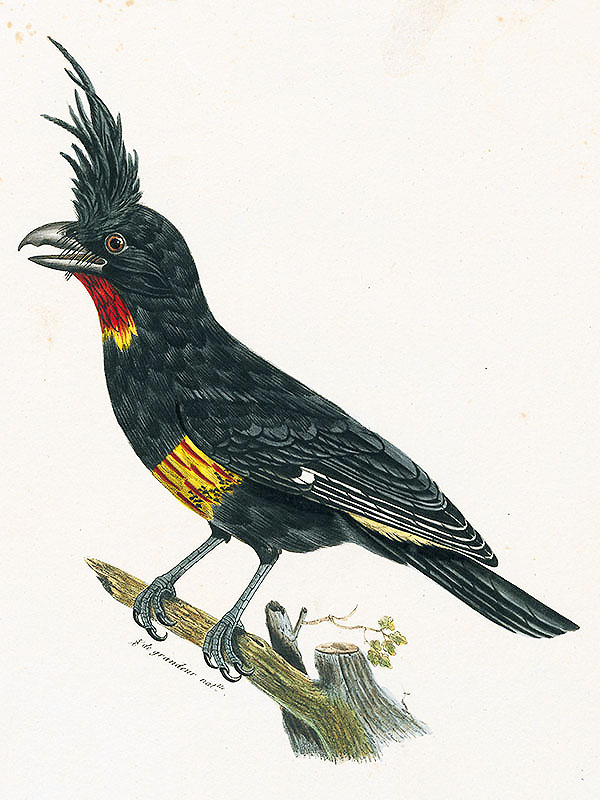
(public domain)
***
Witzigerweise findet die hier gezeigte Abbildung auch auf der Wikipedia-Seite über den Braun-Haubendickkopf (Ornorectes cristatus (Salvadori)) Verwendung, einer Vogelart, die tatsächlich existiert und vollkommen anders aussieht.
*********************
Quelle:
[1] H. R. Schinz; Joseph Brodtmann: Naturgeschichte und Abbildungen der Vögel: nach den neuesten Systemen bearbeitet. Leipzig: Weidmann’sche Buchhandlung 1836
*********************
bearbeitet: 23.03.2021
Karmesintaube
Karmesintaube (Columba rosea Miller & Shaw)
“Unter all dem schönen Hausgeflügel, welches uns Indien geliefert hat, ist die köstliche Karmesintaube gewiss der prächtigste Vogel. Sie ist eine Haustaube, und ohngefähr so gross wie die unsrigen. Ihr Gefieder ist hauptsächlich ein glänzendes Karmesin, welches sich an mehreren Stellen in ein schönes Rosenroth verläuft. Die Kehle, Scheitel, Augenkreise und Spitzen der Flügelfedern sind weiss, die Schwung- und Schwanzfedern aber braun. Die Ostindier halten diese prächtige Taube häufig für ihre schönen Hühnerhöfe.“
Dieser Text stammt aus einem Kinderbuch und behandelt eine der eigenartigsten mysteriösen Vogelformen überhaupt; tatsächlich taucht ihr Name immer einmal wieder in Auflistungen ausgestorbener Vogelarten auf – trotzdem hat sie jedoch wohl nie existiert.
Im 18. Jahrhundert war es keinesfalls selten in diversen wissenschaftlichen Schriften, und zwar nicht nur solchen für Kinder, allerlei ausgedachtes, mehr oder weniger fantastisch anmutendes unterzubringen um die geneigte Leserschaft angemessen zu unterhalten, darunter eben auch komplett ausgedachte Tierarten.
*********************

(public domain)
*********************
Quellen:
[1] F. J. Bertuch: Bilderbuch Für Kinder: enthaltend eine angenehme Sammlung von Thieren, Pflanzen, Blumen, Früchten, Mineralien, Trachten und allerhand andern unterrichtenden Gegenständen aus dem Reiche der Natur, der Künste und Wissenschaften; alle nach den besten Originalen gewählt, gestochen, und mit einer kurzen wissenschaftlichen, und den Verstandes-Kräften eines Kindes angemessenen Erklärung begleitet. Weimar, im Verlage des Industrie-Comptoirs 1802
[2] Pauline Knip: Les pigeons, par Madame Knip, née Pauline de Courcelles, le texte par C. J. Themminck. Paris: chez Mme. Knip 1838-1843
[3] Julian P. Hume: Extinct Birds. Bloomsbury Natural History; 2nd edition 2017
*********************
bearbeitet: 22.03.2021
Colombe a Moustache / San Domingo-Taube
San Domingo-Taube (Columba dominicensis Latham)
“Cette jolie espèce, dont Buffon a donné le premier une figure très exacte, habite, avec l’espèce du précédent article, les contrées méridionales du nouveau continent. Nous ne connoissons de cette Colombe que l’extérieur, dont nous donnerons une description succincte. La longueur totale de la Colombe à Moustache est de onze pouces; la queue est moins longue que dans les espèces dont nous venons de parler; elle est cependant à pennes d’inégale longueur, et présente la forme d’un cône. Le front et la région des yeux sont blancs; la gorge l’est aussi. Cette couleur se dirige sur une partie des côtés du cou, et se joint sur la nuque. Sur le haut de la tête est une large bande transversale noire, qui semble la partager en deux parties. De la base du bec se dirige, en passant sous les yeux, une moustache noire qui s’élargit vers son extrémité, et dont les plumes recouvrent l’orifice des oreilles: un large collier noir entoure le cou vers le milieu de sa longueur. La poitrine est de couleur vineuse; mais vers les parties latérales il y a des plumes pourprées à reflets métalliques: toutes les parties supérieures sont d’un brun-terreux. Sur les plumes scapulaires et les grandes couvertures sont quelques taches noires. Les rémiges sont noirâtres, bordées extérieurement de gris-blanc. Le ventre est brun-cendré; les pennes de la queue sont grises; toutes, excepté les deux du milieu, ont leur extrémité blanche: le bec est noir, et les pieds sont rougeâtres.
On trouve l’espèce à Saint-Domingue, et probablement aussi dans les autres parties de l’Amérique méridionale situées sous le même degré. Nous présumons que l’individu figuré par nous à cet article est le mâle de l’espèce: nous ne saurions cependant raffirmer. Le seul individu que nous ayons eu occasion de voir faisoit autrefois partie du Muséum Leverian, à Londres.” [1]
Übersetzung:
“Diese hübsche Art, von der Buffon als erster eine sehr genaue Abbildung lieferte, lebt zusammen mit der Art im vorherigen Artikel in den südlichen Regionen des neuen Kontinents. Wir kennen von dieser Taube nur das Äußere, von dem wir eine kurze Beschreibung geben werden. Die Gesamtlänge der Schnurrbarttaube beträgt elf Zoll [ca. 28 cm];der Schwanz ist kürzer als bei der gerade erwähnten Art; er besitzt jedoch Federn von ungleicher Länge und hat die Form eines Kegels. Stirn und Augenpartie sind weiß; der Hals auch. Diese Farbe verläuft an einem Teil der Seiten des Halses und verbindet sich im Nacken. Auf der Oberseite des Kopfes befindet sich ein breites schwarzes Querband, das ihn in zwei Teile zu teilen scheint. Von der Basis des Schnabels verläuft unter den Augen ein schwarzer Schnurrbart, der sich zum Ende hin erweitert und dessen Federn die Öffnung der Ohren bedecken: Ein großer schwarzer Kragen umgibt den Hals zur Mitte seiner Länge. Die Brust hat eine weinrote Farbe; aber zu den Seiten hin gibt es lila Federn mit metallischem Schimmer: Alle oberen Teile sind erdbraun. Auf den Schulter- und den größeren Flügeldecken befinden sich einige schwarze Flecken. Die Flugfedern sind schwärzlich und außen grauweiß eingefasst. Der Bauch ist aschbraun, die Schwanzfedern sind grau; Alle außer den beiden in der Mitte haben weiße Spitzen: Der Schnabel ist schwarz und die Füße rötlich.
Die Art kommt in Santo Domingo [Haiti/Hispaniola] und wahrscheinlich auch in anderen Teilen Südamerikas unter dem gleichen Grad vor. Wir gehen davon aus, dass das von uns in diesem Artikel vorgestellte Individuum das Männchen der Art ist. Dies können wir jedoch nicht bestätigen. Das einzige Individuum, das wir sehen konnten, war früher Teil des Leverian Museum in London.“
***
Diese ‘Art’ ist ursprünglich anhand einer Darstellung aus dem Jahr 1771bekannt, die dann wiederum als Vorlage für eine Beschreibung durch John Latham im Jahr 1790 diente und eben offenbar auch der oben wiedergegebenen aus dem 19. Jahrhundert. [2]
Interessant finde ich allerdings die Aussage der Autoren (Temminck und Knip) ein Exemplar gesehen haben zu wollen, das vormals Bestandteil der ehemaligen Leverianischen Sammlung in Leicester House in Westminster, London gewesen sein soll; außerdem fällt beim Lesen der Beschreibung auf, dass sie nicht so ganz zu der dazugehörigen Darstellung passen möchte.
*********************
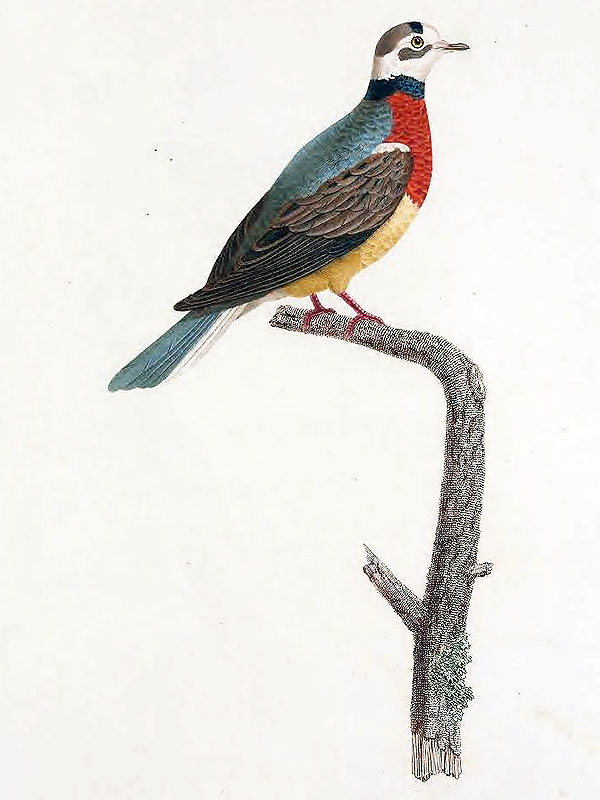
(public domain)
*********************
Quellen:
[1] Pauline Knip: Les pigeons, par Madame Knip, née Pauline de Courcelles, le texte par C. J. Themminck. Paris: chez Mme. Knip 1838-1843
[2] Julian P. Hume: Extinct Birds. Bloomsbury Natural History; 2nd edition 2017
*********************
bearbeitet: 22.03.2021
Columbe Azurée / Azurtaube
Azurtaube (Columba dorsocaerulea Temminck & Knip)
“Toutes les parties supérieures de cette jolie Colombe étant d’une brillante et vive couleur d’azur, nous en avons tiré son signalement spécifique. On nous a assuré que l’espèce habite au Bengale; ce dont nous ne saurions cependant garantir l’authenticité.
La longueur totale de la Colombe azurée est de neuf pouces; ses ailes atteignent à la moitié de la longueur de la queue, qui est arrondie.
Un bleu céleste ou couleur de turquoise orientale est répandu sur les parties supérieures; les joues et la gorge sont d’un blanc pur. On remarque sur le devant du cou et de la poitrine des teintes d’un brun fauve, nuancé d’un ton vineux; le ventre et l’abdomen sont blanchâtres; les pieds et le cercle nu qui enture les yeux sont rouges; la base du bec est rougèatre, mais la ointe est d’un blanc jaunâtre.
Un individu de cette belle espèce faisoit partie du cabinet de M. Holthuysen, à Amsterdam.” [1]
Übersetzung:
“Alle oberen Teile dieser hübschen Taube haben eine brillante und lebendige azurblaue Farbe, wir haben daraus ihre spezifische Beschreibung gezogen. Uns wurde versichert, dass die Art in Bengalen lebt, wir können jedoch die Echtheit nicht garantieren.
Die Gesamtlänge der Azurtaube beträgt 9 Zoll [ca. 23 cm]; ihre Flügel erreichen die halbe Länge des Schwanzes, der abgerundet ist.
Ein himmlisches Blau oder orientalisches Türkis ist auf den oberen Teilen verteilt; die Wangen und der Hals sind rein weiß. Man bemerkt auf der Vorderseite des Halses und auf der Brust ein Rehbraun, nuanciert mit einem weinroten Ton; die Brust und der Bauch sind weißlich; die Füße und der nackte Ring um die Augen sind rot; die Basis des Schnabels ist rötlich, aber die Schnabelspitze ist gelblich weiß.
Ein Individuum dieser schönen Art befand sich im Kabinett von Herrn Holthuysen in Amsterdam.“
Ich kann nicht wirklich sagen, was ich mit diesem Vogel anfangen soll, mit ziemlicher Sicherheit stammt er nicht aus Bengalen (im Nordosten Indiens) und mit ebenso ziemlicher Sicherheit handelt es sich bei dem (einzigen existierenden?) Exemplar im Kabinett des Herrn Holthuysen in Amsterdam um eine der damals nicht unüblichen gefälschten Stopfpräparate, die, wenn sie besonders gelungen waren, für durchaus nicht wenig Geld an interessierte Sammler seltener Schätze gebracht wurden.
Doch, da jenes Originalexemplar nicht mehr existiert, handelte es sich hierbei um eine gewöhnliche, eingefärbte Taube oder um einen vollkommen anderen Vogel, dem ein Taubenköpfchen aufgesetzt wurde? Dies werden wir wahrscheinlich nie erfahren.
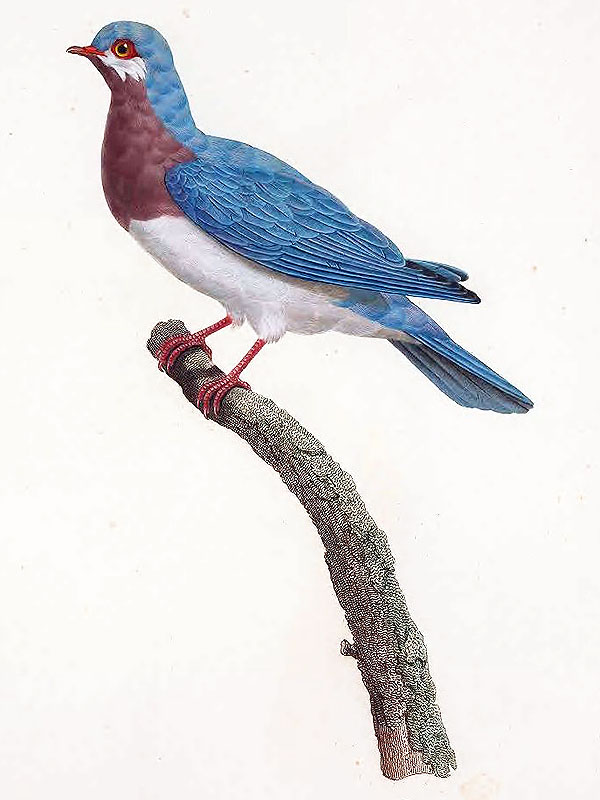
(public domain)
Es existieren auch Versionen dieses Gemäldes auf denen die weinroten Gefiederbereiche komplett grau und die Beine sehr blass, fast weißlich gefärbt sind.
*********************
Quelle:
[1] Pauline Knip: Les pigeons, par Madame Knip, née Pauline de Courcelles, le texte par C. J. Themminck. Paris: chez Mme. Knip 1838-1843
*********************
bearbeitet: 21.03.2021
Earero bauo / Nauru-Ralle
Nauru-Ralle (Gallirallus sp.)
Nauru; die gesamte Insel war einst mit einem Substrat bedeckt, das zu großen Teilen aus Guano bestand, und vollkommen bewaldet.
Heute sieht sie so aus, eine raue und trostlose Karstlandschaft, die nicht natürlichen Ursprungs ist sondern menschgemacht.:
*********************
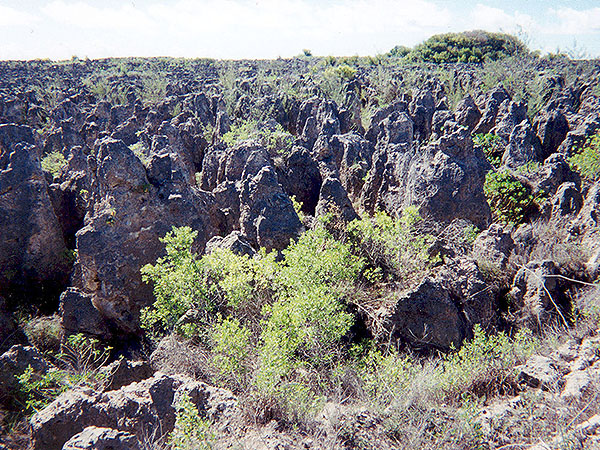
(public domain)
***
“Es gibt auch Vögel auf Nauru, wie Fregattvogel, schwarze Seeschwalbe, weiße Seeschwalbe, Regenpfeifer, Brachvogel, Möve, Schnepfe, Uferläufer, Ralle, Lachmöve und Rohrdrossel.” [1]
“Die Vogelwelt ist nach Zahl und Art reicher. Der Fregattvogel (Tachypetes aquila), itsi, die schwarze Seeschwalbe (Anous), doror, die weiße Seeschwalbe (Gygis), dagiagia, werden als Haustiere gehalten; der erste galt früher als heiliger Vogel, mit den beiden anderen werden Kampfspiele veranstaltet. Am Strande trifft man den Steinwälzer (Strepsilas interpres), dagiduba, den Regenpfeifer (Numenius), den Uferläufer (Tringoides), ibibito, die Schnepfe, ikirer, den Brachvogel ikiuoi, den Strandreiter iuji, die Ralle, earero bauo und zwei Möwenarten (Sterna), igogora und ederakui. Im Busche beobachtet man an den Blüten der Kokospalme den kleinen Honigsauger raigide, die Rohrdrossel (Calamoherpe syrinx), itirir und den Fliegenschnäpper (Rhipidura), temarubi.” [1]
***
Diese beiden knappen Aufzählungen sind alles was von der ehemaligen Existenz einer Rallenart auf der Insel Nauru kündigt, und offiziell wird dieser Bericht denn auch als nicht vertrauenswürdig abgetan [3], dabei ist gerade das ehemalige Vorkommen einer Rallenart auf Nauru geradezu zweifelsfrei sicher.
Die Familie der Rallen ist führend im Besiedeln selbst der entlegensten Inseln, und anhand von archäologischen und paläontologischen Ausgrabungen ist heute bekannt, dass es innerhalb von Mikronesien weitaus mehr Rallenarten gab als die wenigen, die bis ins 20. Jahrhundert überlebt haben (in der Gattung Gallirallus sind dies genau zwei, die Guam-Ralle (Gallirallus owstoni (Rothschild)) und die Wake-Ralle (Gallirallus wakensis (Rothschild))). [2]
Das Vorkommen einer solchen endemischen Form auf Nauru ist daher geradezu absolut sicher.
*********************
Quellen:
[1] Paul Hambruch: Nauru. Ergebnisse der Südsee-Expedition 1908-1910. II. Ethnographie: B. Mikronesien, Band 1.1 Halbband. Hamburg, Friedrichsen 1914
[2] David W. Steadman: Extinction and Biogeography of Tropical Pacific Birds. University of Chicago Press 2006
[3] Donald W. Buden: The birds of Nauru. Notornis 55: 8-19. 2008
*********************
bearbeitet: 20.03.2021
Temarubi / Nauru-Fächerschwanz
Nauru-Fächerschwanz (Rhipidura sp.)
Mikronesien beherbergt heute noch drei Arten von Fächerschwänzen, den Pohnpei-Fächerschwanz (Rhipidura kubaryi Finsch), den Palau-Fächerschwanz (Rhipidura lepida Hartlaub & Finsch) sowie den Fuchsfächerschwanz (Rhipidura rufifrons (Latham)), der mit einigen Unterarten die Marianen bewohnt.
Es mag vormals durchaus mehr Formen gegeben haben ….
Der einzige Hinweis auf des ehemalige Vorkommen einer Fächerschwanzart auf der isolierten Insel Nauru ist der Bericht des Ethnologen Paul Hambruch aus dem Jahr 1910, der wiederum Erzählungen aufgeschrieben hat, die ihm von einem Einheimischen der Insel erzählt wurden.:
“Die Vogelwelt ist nach Zahl und Art reicher. Der Fregattvogel (Tachypetes aquila), itsi, die schwarze Seeschwalbe (Anous), doror, die weiße Seeschwalbe (Gygis), dagiagia, werden als Haustiere gehalten; der erste galt früher als heiliger Vogel, mit den beiden anderen werden Kampfspiele veranstaltet. Am Strande trifft man den Steinwälzer (Strepsilas interpres), dagiduba, den Regenpfeifer (Numenius), den Uferläufer (Tringoides), ibibito, die Schnepfe, ikirer, den Brachvogel ikiuoi, den Strandreiter iuji, die Ralle, earero bauo und zwei Möwenarten (Sterna), igogora und ederakui. Im Busche beobachtet man an den Blüten der Kokospalme den kleinen Honigsauger raigide, die Rohrdrossel (Calamoherpe syrinx), itirir und den Fliegenschnäpper (Rhipidura), temarubi.” [1]
***
Dieser Bericht wird offiziell als unwahrscheinlich abgelehnt [3], was ich persönlich nicht verstehe, denn er erscheint mir durchaus zuverlässig, selbst wenn es die dort aufgezählten Vögel zu der Zeit bereits nicht mehr gegeben haben sollte, so können die Überlieferungen durchaus länger überdauert haben.
Das Foto zeigt den Pohnpei-Fächerschwanz von der gleichnamigen Insel.
***
Es ist erstaunlich, dass auch die Inseln Chuuk und Yap offenbar keine einheimischen Fächerschwanzarten beherbergen – hier geht man für gewöhnlich oft davon aus, dass es solche Arten durchaus vormals gegeben haben dürfte, dass sie aber schon bald nach der Besiedlung durch Menschen ausgestorben sind. [2]
*********************
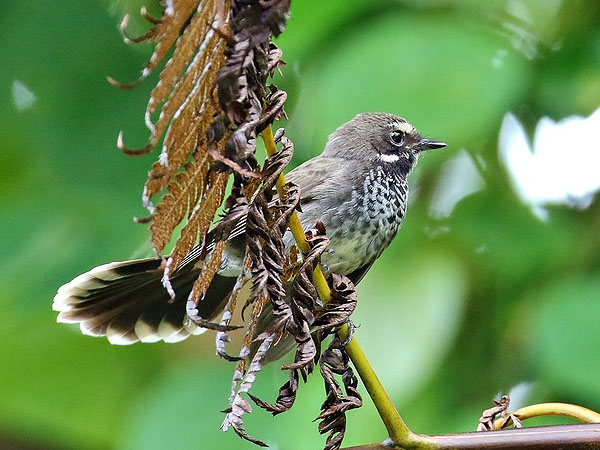
https://www.inaturalist.org/people/thibaudaronson
(under creative commons license (4.0))
https://creativecommons.org/licenses/by-sa/4.0/
*********************
Quellen:
[1] Paul Hambruch: Nauru. Ergebnisse der Südsee-Expedition 1908-1910. II. Ethnographie: B. Mikronesien, Band 1.1 Halbband. Hamburg, Friedrichsen 1914
[2] David W. Steadman: Extinction and Biogeography of Tropical Pacific Birds. University of Chicago Press 2006
[3] Donald W. Buden: The birds of Nauru. Notornis 55: 8-19. 2008
*********************
bearbeitet: 20.03.2021
Raigide / Nauru-Honigfresser
Nauru-Honigfresser (Myzomela sp.)
Diese Art (oder Unterart) mag auf der Insel Nauru vorgekommen sein, sie wird allerdings offenbar in nur einem einzigen Bericht erwähnt, und dabei handelt es sich um Erzählungen aus zweiter Hand.
Paul Hambruch, der Enthnologe der zu Beginn des 20. Jahrhunderts das Leben der Einwohner der Insel Nauru erforschte erwähnt in seinem Bericht Geschichten, die ihm von einem Einheimischen namens Auuiyeda erzählt wurden und in denen unter anderem auch von den einheimischen Vögeln die Rede ist.:
“Die Vogelwelt ist nach Zahl und Art reicher. Der Fregattvogel (Tachypetes aquila), itsi, die schwarze Seeschwalbe (Anous), doror, die weiße Seeschwalbe (Gygis), dagiagia, werden als Haustiere gehalten; der erste galt früher als heiliger Vogel, mit den beiden anderen werden Kampfspiele veranstaltet. Am Strande trifft man den Steinwälzer (Strepsilas interpres), dagiduba, den Regenpfeifer (Numenius), den Uferläufer (Tringoides), ibibito, die Schnepfe, ikirer, den Brachvogel ikiuoi, den Strandreiter iuji, die Ralle, earero bauo und zwei Möwenarten (Sterna), igogora und ederakui. Im Busche beobachtet man an den Blüten der Kokospalme den kleinen Honigsauger raigide, die Rohrdrossel (Calamoherpe syrinx), itirir und den Fliegenschnäpper (Rhipidura), temarubi.” [1]
***
Seltsamerweise gilt der Bericht als unglaubwürdig [2], was ich persönlich überhaupt nicht verstehe, denn die drei hier genannten Vogelformen (eine Ralle, ein Honigfresser und ein Fächerschwanz) sind sehr wohl aus Mikronesien bekannt und kommen bzw. kamen auf etlichen der Inseln vor.
Im Falle dieses Honigfressers mag es sich, der doch recht isolierten Lage Naurus entsprechend, um eine eigenständige Art gehandelt haben oder aber um eine Unterart des Mikronesischen Honigfressers (Myzomela rubratra (Lesson)) (siehe Foto), der in Mikronesien mit vier Unterarten verbreitet und dort eigentlich auch überall recht häufig ist.
Der Nauru-Honigfresser verschwand vermutlich aufgrund von Bejagung (der roten Federn wegen aber auch weil diese Vögel in ihrer Heimat als Delikatesse gelten) sowie in Folge der nahezu kompletten Zerstörung der Vegetation durch den massiven Guano/Phosphat-Abbau, der auf Nauru stattfand.
*********************
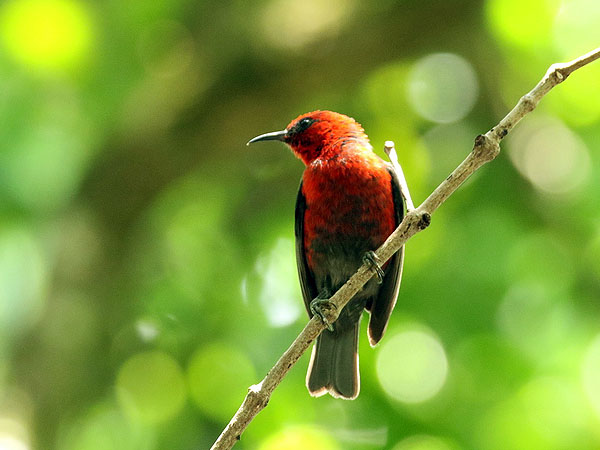
https://www.inaturalist.org/people/thibaudaronson
(under creative commons license (4.0))
https://creativecommons.org/licenses/by-sa/4.0/
*********************
Quellen:
[1] Paul Hambruch: Nauru. Ergebnisse der Südsee-Expedition 1908-1910. II. Ethnographie: B. Mikronesien, Band 1.1 Halbband. Hamburg, Friedrichsen 1914
[2] Donald W. Buden: The birds of Nauru. Notornis 55: 8-19. 2008
*********************
bearbeitet: 20.03.2021
Wilhelmina-Paradiesvogel
Wilhelmina-Paradiesvogel (Lamprothorax wilhelminae Meyer)
Der Wilhelmina-Paradiesvogel ist eine jener Paradiesvogel’arten’, die nach einem Mitglied eines der zahlreichen europäischen Königshäuser benannt wurde – in diesem Fall war dies die damalige niederländische Königin (Wilhelmina Helena Pauline Maria von Oranien-Nassau (Königin Wilhelmina 1880-1962)).
Die ‘Art’ ist nur anhand von drei (männlichen) Exemplaren bekannt, und es ist diese Tatsache, dass nahezu alle jene ‘lost birds of paradise’ [1] nur anhand männlicher Exemplare bekannt sind, die einem zu denken geben sollte. Würde es sich tatsächlich um heute ausgestorbene Arten handeln, so wären sicher einige dazugehörigen Weibchen gefunden wurden, dem ist aber nicht so, in keinem einzigen Fall! (… in den beiden Fällen in denen eine solche Form anhand eines Weibchens bekannt ist, fehlen wiederum die passenden Männchen ….)
***
Es handelt sich auch hier um eine Hybridform, und zwar mit dem Sichelschwanz-Paradiesvogel (Cicinnurus magnificus (J. R. Forst.)) und dem Kragenparadiesvogel (Lophorina superba J. R. Forst) als Elternarten. [2]
*********************
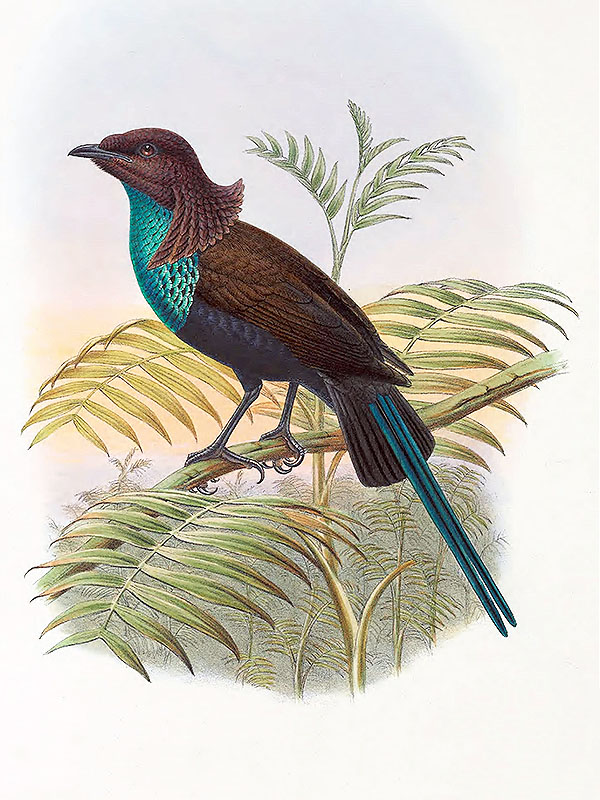
(public domain)
*********************
Quellen:
[1] Errol Fuller: The Lost Birds of Paradise. Airlife 1996
[2] Clifford B. Frith; Bruce M. Beehler: The Birds of Paradise: Paradisaeidae. Oxford University Press 1998
*********************
bearbeitet: 20.03.2021
Rothschilds Lappenschnabel-Paradiesvogel
Rothschilds Lappenschnabel-Paradiesvogel (Loboramphus nobilis Rothschild)
Dieser außerordentlich schöne Vogel wurde im Jahre 1901 als eigenständige Art beschrieben, nur ein einziges Exemplar ist bekannt.
Es handelt sich wohl um eine der außergewöhnlichsten Hybriden überhaupt, eine Kreuzung zweier ungemein unterschiedlicher Arten, nämlich dem Kragenparadiesvogel (Lophorina superba J. R. Forst) und der Langschwanz-Paradigalla (Paradigalla carunculata Lesson); dies ist jedoch nicht hundertprozentig klar. [1]
Einige Ornithologen halten diese Form nach wie vor für eine eigenständige, heute ausgestorbene Art.
*********************

(public domain)
*********************
Quelle:
[1] Clifford B. Frith; Bruce M. Beehler: The Birds of Paradise: Paradisaeidae. Oxford University Press 1998
*********************
bearbeitet: 20.03.2021
Wundervoller Paradiesvogel
Wundervoller Paradiesvogel (Paradisaea mirabilis Reichenow)
Der Wundervolle Paradiesvogel, der ‘Wonderful Bird of Paradise’, ist anhand von ganzen fünf (männlichen) Exemplaren bekannt, es handelt sich hierbei um die ziemlich unwahrscheinliche und trotzdem geschehene Kreuzung zwischen dem Kleinen Paradiesvogel (Paradisaea minor Shaw) und dem Fadenhopf (Seleucidis melanoleuca (Daudin)).
Diese beiden durchaus unterschiedlich aussehenden Arten, ja Gattungen, haben einen prachtvollen Mix aus beiden Elternteilen hervorgebracht, dem die hier gezeigte Darstellung nicht ansatzweise gerecht wird.
*********************

(public domain)
*********************
Quelle:
[1] Clifford B. Frith; Bruce M. Beehler: The Birds of Paradise: Paradisaeidae. Oxford University Press 1998
*********************
bearbeitet: 14.03.2021
Waigiou-Paradiesvogel
Waigiou-Paradiesvogel (Diphyllodes gulielmi III Meyer)
Der Waigiou-Paradiesvogel, sicher besser bekannt unter dem englischen Namen ‘King of Holland’s Bird of Paradise’, ist eine der am häufigsten auftauchenden Hybridformen innerhalb der Familie.
Es war im 19. Jahrhundert Mode neu entdeckte Paradiesvögel nach Mitgliedern diverser europäischer Königshäuser zu benennen, so wurde diese Form nach dem damaligen holländischen König (Wilhelm Alexander Paul Friedrich Ludwig von Oranien-Nassau (König Wilhelm III 1817-1890)) benannt.
Es handelt sich hierbei um eine offenbar häufiger auftretende Kreuzung der äußerlich so verschiedenen und doch nah verwandten Arten Sichelschwanz-Paradiesvogel (Cicinnurus magnificus (J. R. Forst.)) und Königsparadiesvogel (Cicinnurus regius (L.)), offenbar mit anschließender Rückkreuzung mit der ersteren Art.
***
Im Gegensatz zu den meisten anderen Paradiesvogelhybriden kann man diesem hier die beiden Elternarten sehr gut ansehen.
*********************
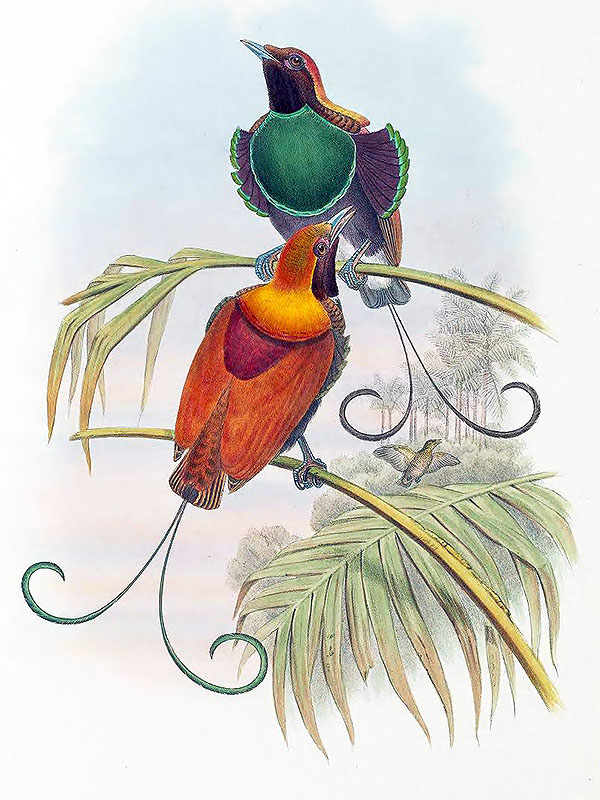
(public domain)
*********************
Quellen:
[1] Clifford B. Frith; Bruce M. Beehler: The Birds of Paradise: Paradisaeidae. Oxford University Press 1998
*********************
bearbeitet: 14.03.2021
Zeitgenössische Berichte über Vögel von den Bermudainseln
Im Moment beschäftige ich mich mit den Bermudas, einer der entlegensten Insel(gruppe)n und auch eine der Regionen über die nicht nur ich nicht viel weiß ….
Die Bermudas waren einst eine einzige, große Insel; durch den immer wieder ansteigenden und abfallenden Meeresspiegel während des Pleistozän ist die Landmasse aber immer wieder mehr oder weniger vollständig überflutet worden, was einerseits zur Entstehung – andererseits aber auch immer wieder zum Aussterben vieler endemischer Arten geführt hat. Vermutlich haben aber viele der einheimischen Vogelarten viel länger überlebt als allgemein gedacht und sind erst zu Beginn des 17. Jahrhunderts nach der Ankunft der ersten menschlichen Siedler ausgerottet worden.
Das kann man den wenigen zeitgenössischen Berichten entnehmen, wenn man diese denn zu entziffern vermag. 🙂
… ja ja, zeitgenössische Beschreibungen … diese hier stammt von Captain John Smith (derselbe, der in der unfassbar verfälschten Geschichte um die Powhatan-‘Häuptlings’tochter Amonute, besser bekannt als Pocahontas, eine zentrale Rolle spielt) und wurde im Jahr 1623 niedergeschrieben.:
“Birds.
Neither hath the aire for her part been wanting with due supplies of many sorts of Fowles, as the gray and white Hearne, the gray and greene Plover, some wilde Ducks and Malards, Coots and Red-shankes, Sea-wigions, Gray-bitterns, Cormorants, numbers of small Birds like Sparrowes and Robins, which have lately beene destroyed by the wilde Cats, Wood-pickars, very many Crowes, which since this Plantation are kild, the rest fled or seldome seene except in the most uninhabited places, from whence they are observed to take their flight about sun set, directing their course towards the North-west, which makes many coniecture there are some more Ilands not far off that way. Sometimes are also seene Falcons & Jar-falcons, Ospraies, a Bird like a Hobby, but because they come seldome, they are held but as passengers; but above all these, most deserving observation and respect are those two sorts of Birds, the one for the tune of his voice, the other for the effect, called the Cahow, and Egge bird, which on the first of May, a day constantly observed, fall a laying infinite store of Eggs neere as big as Hens, upon certaine small sandie baies especially in Coupers Ile; and although men sit downe amongst them when hundreds have bin gathered in a morning, yet there is hath stayed amongst them till they have gathered as many more: they continue this course till Midsummer, and so tame & feareles, you must thrust them off from their Eggs with your hand; then they grow so faint with laying, they suffer them to breed & take infinite numbers of their young to eat, which are very excellent meat.” [1]
Ich habe versucht, dieses etwas kauderwelschige Englisch ins Deutsche zu übertragen, direkt übersetzen lässt sich das leider nicht immer alles.:
“Vögel.
Weder hat die Luft ihrerseits die richtige Versorgung mit vielen Arten von Geflügel verfehlt, wie dem grau-weißen Reiher [?], dem grau-grünen Regenpfeifer, einigen wilden Enten und Stockenten, Blässhühnern und Rotschenkeln, Meerenten [?], Graudommeln, Kormorane, eine Anzahl kleiner Vögel wie Spatzen und Fliegenschnäpper, die in letzter Zeit von den wilden Katzen vernichtet wurden, Spechten und sehr vielen Krähen, die seit der [Anlage der] Plantage getötet wurden, der Rest floh oder wird selten gesehen, außer an den unbewohntesten Plätzen, von wo aus beobachtet wird, dass sie ihren Flug gegen Sonnenuntergang antreten und ihren Kurs in Richtung Nordwesten richten, was viele Vermutungen zulässt, dass es einige weitere Inseln gibt, die nicht weit von diesem Weg entfernt sind. Manchmal werden auch Falken gesehen & Jar-Falken [?],Fischadler, ein Vogel wie ein großer Falke, aber weil sie selten kommen, werden sie nur für Besucher gehalten; vor allem aber verdienen diese beiden Arten von Vögeln Beachtung und Respekt, die eine für die Melodie seiner Stimme, die andere für sein Wirken, genannt [werden sie] Cahow, und Eier-Vogel, die am Ersten des Mai, einem stets beobachteten Tag, einen unendlichen Vorrat an Eiern, fast groß wie Hühner[eier], an bestimmte kleinen Sandküsten legen, besonders auf Coopers Island [seit den 1940ern künstlich mit St David’s Island verbunden]; und obwohl Männer unter ihnen sitzen, wenn sich an einem Morgen Hunderte versammelt haben, so bleiben sie doch unter ihnen, bis sie sich noch viele mehr versammelt haben: Sie setzen dies bis Mittsommer fort, und so zahm und angstlos, Du musst sie mit der Hand von ihren Eiern schieben, dann sind sie so schwach vom Legen, dass sie es nicht schaffen sie auszubrüten & [die Menschen] nehmen unendlich viele ihrer Jungen zum Essen, die sehr gutes Fleisch sind.”
***
Viele der hier aufgezählten Vögel lassen sich identifizieren: der ‘grau-weiße Reiher’ ist vermutlich der Kanada-Reiher (Ardea herodias L.), bei den Enten, Stockenten und Meerenten handelt es sich ziemlich wahrscheinlich um verschiedene Wintergäste, wie sie auch heute noch auftreten, die Blässhühner dürften Amerikanische Blässhühner (Fulica americana Gmelin) sein, die Kormorane sind sicher Ohrenscharben (Phalacrocorax auritus (Lesson)); bei den ‘Fliegenschnäppern’ handelt es sich mit einiger Sicherheit um Bermuda-Weißaugenvireos (Vireo griseus ssp. bermudianus Bangs & Bradlee), die einzige noch existierende endemische Vogelform der Inseln.
Einige, wie der ‘grau-grüne Regenpfeifer’ oder der ‘Rotschenkel’ lassen sich nicht wirklich identifizieren (zumindest aber handelt es sich bei letzterem mit ziemlicher Sicherheit nicht um den eigentlichen Rotschenkel (Tringa totanus (L.))); auch die Falken lassen sich nicht eindeutig identifizieren, da einige Arten immer mal wieder als Zugvögel auf den Bermudas auftauchen.
Mindestens drei der hier augezählten Vögel existieren heute nicht mehr, die ‘Graudommeln’, welche ziemlich sicher Bermuda-Krabbenreiher (Nyctanassa carcinocatactes Olson & Wingate) waren, die ‘Spatzen’, die wohl Bermuda-Grundrötel (Pipilo naufragum Olson & Wingate) waren und die Spechte, die wiederum Bermuda-Goldspechte (Colaptes oceanicus Olson) gewesen sein dürften.
All diese Arten wurden ausschließlich anhand von Knochenfunden beschrieben und zwar 2006, 2006 und 2013. [2][3][4]
***
Das größte Rätsel sind die hier erwähnten sehr vielen Krähen, denn davon gibt es auf den Inseln auch heute noch sehr viele, und zwar Amerikanerkrähen (Corvus brachyrhynchos Brehm), diese gehen jedoch nachgewiesenermaßen auf zwei Vögel zurück, die 1838 als Stubenvögel auf die Inseln gebracht worden waren.
Das bedeutet, dass es auf den Bermudas einst auch eine einheimische Krähenart gegeben haben muss, und dass diese obendrein auch noch sehr zahlreich gewesen sein muss.
Diese Form wurde offenbar von den ersten Siedlern ausgerottet, die die Krähen als Landwirtschaftsschädlinge betrachteten – scheinbar wiederholt sich die Geschichte nun, denn auch die heutzutage auf den Inseln lebenden Amerikanerkrähen werden als Schädlinge angesehen und verfolgt.
*********************
Referenzen:
[1] John Smith: The Generall Historie of Virginia, New-England, and the Summer Isles: with the Names of the Adventurers, Planters, and Governours from their first beginning, An: 1584. to this present 1624. With the Procedings of Those Severall Colonies and the Accidents that befell them in all their Journyes and Discoveries. Also the Maps and Descriptions of all those Countryes, their Commodities, people, Government, Customes, and Religion yet knowne. Divided into Sixe Bookes. By Captaine Iohn Smith, sometymes Governour in those Countryes & Admirall of New England. London: printed by I. D. and I. H. for Michael Sparkes 1624
[2] Storrs L. Olson; D. B. Wingate: A New Species of Night-heron (Ardeidae: Nyctanassa) from Quaternary Deposits on Bermuda. Proceedings of the Biological Society of Washington 119(2): 326-337. 2006
[3] Storrs L. Olson; David B. Wingate: A new species of towhee (Aves: Emberizidae: Pipilo) from Quaternary deposits on Bermuda. Proceedings of the Biological Society of Washington 125(1): 85–96. 2012
[4] Storrs L. Olson: Fossil woodpeckers from Bermuda with the description of a new species of Colaptes (Aves: Picidae). Proceedings of the Biological Society of Washington 126(1): 17–24. 2013
*********************
bearbeitet: 05.11.2020
Todiramphus ‘divinus’ – The ‘Divine’ Kingfisher
“Two species of Kingfishers were common on Bora-Bora (Halcyon veneratus and Todiramphus tutus), ….“
and
“HALCYON VENERATUS. (Ruru.)
This species is fairly common, especially on the island of Bora-Bora.
TODIRAMPHUS TUTUS.
Common throughout the Tahiti group.” [2]
***
These two rather cursory marginal notes from 1907 are an indication of the former existence of a bird species that no longer exists today and of which (almost) no trace can be found today.
***
The Society Islands are one of the very few places where two kingfisher species coexist, at least on the islands of Mo’orea and Tahiti in the eastern part of the archipelago; here you will find the widespread Chattering Kingfisher (Todiramphus tutus (Gmelin)), which occurs throughout the archipelago, as well as the Tahiti Kingfisher (Todiramphus veneratus (Gmelin)) and Moorea Kingfisher (Todiramphus youngi Sharpe), both restricted to a single island each.
However, the two references to the island of Bora Bora indicate that this was apparently also the case on other of the islands.
In fact, the mysterious kingfisher is not only known from small marginal notes but from at least two specimens that were collected at the beginning of the 19th century, one of which apparently still exists. This sole surviving specimen was examined in 2008 and compared to the Tahiti- and Moorea Kingfisher.
The authors concluded that this is an incompletely colored juvenile of the Tahitian species, but also note some differences, including a much shorter beak and some differences in plumage pattern, and conclude that it may also be an extinct subspecies. [3]
The species has also been depicted at least once (see below). [1]
***
Between Bora Bora in the northwestern part of the archipelago and Mo’orea and Tahiti in the eastern part are four other islands, namely Huahine, Mai’ao, Ra’iatea and Taha’a, each of which, at least today, is inhabited only by the Chattering Kingfisher.
If the island of Bora Bora was indeed once home to two species of kingfishers, then this bird must not have been a subspecies of the Tahitian Kingfisher, but a separate species; and, the other islands between Bora Bora and Mo’orea and Tahiti must most likely also have harbored now extinct and unknown distinct species.
***
In my humble opinion, however, the location of Bora Bora is simply an error, and the two birds collected there are more likely to be from the island of Tahiti. … but who knows ….
*********************

Depiction from: ‘M. Lesson: Description du genre Todiramphe et de deux espèces d’oiseaux; qui le compossent. Mémoires de la Société d’Histoire naturelle de Paris 2(3): 419-422. 1827’
(public domain)
*********************
References:
[1] M. L. I. Duperrey: Voyage autour du monde: Exécuté par Ordre du Roi, Sur la Corvette de Sa Majesté, La Coquille, pendant les années 1822, 1823, 1824, et 1825, par M. L. I. Duperrey; Zoologie, par Mm. Lesson et Garnot. Paris: Arthus Bertrand 1828
[2] S. B. Wilson: Notes on birds of Tahiti and the Society group. Ibis Ser. 9(1): 373-379. 1907
[3] Claire Voisin; Jean-François Voisin: List of type specimens of birds in the collections of the Muséum national d’Histoire naturelle (Paris, France). 18. Coraciiformes. Journal of the National Museum (Prague), Natural History Series 177(1): 1-25. 2008
[4] Justin J. F. J. Jansen & Roland E. van der Vliet: The chequered history of the Chattering Kingfisher Todiramphus on Tahiti: I: type specimens. Bulletin of the British Ornithologists’ Club 135(2): 108-120. 2015
[5] Justin J. F. J. Jansen & Roland E. van der Vliet: The chequered history of the Chattering Kingfisher Todiramphus on Tahiti: II: review of status. Bulletin of the British Ornithologists’ Club 135(2): 121-130. 2015
[6] Michael Lee & David T. Holyoak: The chequered history of Chattering Kingfisher Todiramphus tutus on Tahiti: a response. Bulletin of the British Ornithologists’ Club 137(3): 211-217. 2017
[7] Roland E. van der Vliet & Justin J. F. J. Jansen: Reply to Lee & Holyoak: how definite are 20th-cetury reports of Chattering Kingfisher Todiramphus tutus from Tahiti? Bulletin of the British Ornithologists’ Club 137(3): 218-225. 2017
*********************
edited: 06.07.2023
Saca, Sasa and Yasaca
P. H. Bahr in the year 1912 quotes a Dr. B. Glanvill Corney, at that time Chief Medical Officer in the Fiji Islands.:
“There is, or was until eight or ten years ago, a bird in the interior and northern coast of Vitilevu called the ‘Sasa’; described as having speckled plumage and running along the ground among reeds, cane-brakes, and undergrowth. … The Sasa did not fly, and seems to have been a mound-builder. I once met with some dogs in a remote mountain village that the natives had specially trained to hunt the Sasa, which they described as Koli dankata sasa, i. e. Sasa-catching dogs; but I never succeeded in seeing a Sasa, nor did my friend Mr. Frank R. S. Baxendale, who, as Assistant Resident Commissioner in the hill districts, lived for more than a year in the Sasa country. His successor, Mr. Georgius Wright, however, had several living specimens in his possession for some time, and told me that he considered they were Megapodes of the same or of an allied species to those met with in the island of Ninafou [Niuafo’ou] (Boscawen Island) and in Samoa. Some natives linkened them to Guinea-fowl, but said they were not so large as the latter, and that they laid a single egg. Between the years 1876 and 1905 they were still comparatively common and well known in the locality mentioned (where there are only a very few Europeans).” [1]
***
What follows is an account by Rollo H. Beck, an American ornithologist, who quotes some notes that he received by a Mr. G. T. Barker on June 5, 1925, during a stay on the island of Viti Levu, Fiji.:
“Saca Megapode
On the Tova Estate (Viti Levu Bay) one day, as I was riding toward the Wainibaka River, I heard a zooming noise on the rocks at my right. I dismounted to ascertain, if possible, what it was, as the place which had no trees, ws such an unusual one for a pigeon. The note, too, was different, having a more vibrant tone.
Grawling twenty feet along a runway but keeping myself hidden I came upon an abandoned clearing covered with short grass. The bird was about tne yards away. It ws slightly smaller than an English game rooster, had an aggressive head with yellow beak, and a stumpy tail. The coloring which was the same on the head as on the body was a mixed yellow, approaching red, and dingy black.
The bird continued its calling for a few minutes, and was answered from the far end of the clearing. Suddenly it took alarm, and as it flew out of the clearing I saw that under the rudimentary wings there were no yellow feathers. The wings had no long feathers made a whirring sound when the birds flew. I also noticed that its legs were stout, of yellow color, and that the foot had three toes. On questioning the natives, I was told that about sixty years ago there was a great area of grass country in that part, owing probably to a denser population, and also to the fact that the people were more industrious. At that time they used to hunt the bird with dogs and would secure up to fifty in a day. Even up to the coming of the mongoose, hese birds were still hunted, but owing to the spreading of the reeds over the country the catch became small.
The birds nested, generally, under the shelter of the dead leaves of the tree fern, never out in the open, and the birds used to take turns sitting on the nest. The natives described the eggs as being white, quite round, generally one, but on rare occasions, two in a nest. They used to hunt for the eggs, and when all hands were out, as many as a hundred a day would be secured. The eggs were hatched under hens in the village, but the saca always went back to the grass and would not remain in the town.
About two years after I had seen the bird, a dependable native who had hunted the birds in his youth, told me that he had seen a pair about two miles away from The place where I had observed them. Twenty was the largest number that had been observed in one flock.
The natives said that the flesh of the saca was dark, and always lean. Its wings seem to have been of some use for the bird is called in that part “the bird that lands on eight hillocks before being cought.”
The annual rainfall in that region averages ninety inches.” [2]
In my humble opinion this whole description, except for the nesting behaviour, sounds a lot like the description of a species of megapode (Megapodius sp.).
“Yasaca
This bird I have never seen, but from all accounts it differs from the saca. First it was called “Nasataudrau”, literally, “in hundreds”, meaning that a flock would be of about one hundred. It was said of them hat they buried their eggs for the sun to hatch out.
Personally, I am doubtful if this bird ever existed in Fiji. I remember of asking a Sabeto Chief in the year 1890 if he had ever seen one – Sabeto, to the Segatoka River, being the region where the ordinary “saca” was most plentiful. This chief was then a man over sixty years old; now add on the thirty-five years since that time – ninety five years ago, and he had never seen yasaca. He had only heard the trdition in his youth.
I am inclined to believe that the natives of this region brought the tale whith them from the Solomon Islands, where megapodes still are found. See, “A Naturalist Amongst the Head Hunters” by Woodward. Mr. A. Barker has a copy of this book. There is a remarkable similarity of language between that part of the Solomons and Fiji, hence the tradition.” [2][4]
***
It is now well known that the Fiji Islands indeed were inhabited by at least two species of megapode, the Consumed Scrubfowl (Megapodius alimentum Steadman) and the Viti Levu Megapodius (Megapodius amissus Worthy). [3]
It is not really known when exactly these species disappeared; the abovementioned accounts, however, show that at least one of the species survived well into quite modern times.
*********************
References:
[1] P. H. Bahr: On a Journey to the Fiji Islands, with Notes on the present Status of their Avifauna, made during a Year’s Stay in the Group, 1910-1911. The Ibis 9(6): 282-313. 1912
[2] Whitney South Sea Expedition of the American Museum of Natural History. Extracts from the journal of Rollo H. Beck. Vol. 2, Dec. 1923 – Aug. 1925
[3] T. H. Worthy: The fossil megapodes (Aves: Megapodiidae) of Fiji with descriptions of a new genus and two new species. Journal of the Royal Society of New Zealand 30(4): 337-364. 2000
[4] Danke Hr. Antonius, für den Hinweis, damit liegen Sie natürlich vollkommen richtig! 🙂
*********************
edited: 31.01.2022
Ground Doves in the Gilbert Islands?
The Polynesian Ground-Dove (Pampusana erythroptera (Gmelin)) and the Friendly Ground-Dove (Pampusana stairi (Gray)) are mentioned in several enumerations of birds that are thought to inhabit the Gilbert Islands in the Micronesian part of Kiribati.
So, I did a little search to find out something more ….:
The first thing I found was that D. H. R. Spennemann and H. Benjamin name these two species as inhabitants of the Marshall Islands, which apparently is an error since they use A. B. Amerson’s account as their source, in which they are clearly named as inhabiting the Gilbert – but not the Marshall Islands. [2][4].
This is the abovementioned account by A. B. Amerson Jr..:
“Gallicolumba erythroptera* Ground Dove
Status — Introduced breeder in the Gilbert Islands.
Marshall-Gilbert Distribution Records — Breeding: Gilberts – Abemama, Nonouti.
Pacific Distribution — Native to the Society and Tuamotu Islands (Baker, 1951).
*Remarks — I am using the species designation given by Child (1960), who says this species was reported to have been introduced into the Gilberts from Nauru about 1940. Pearson (1962) did not find any doves at Nauru in 1961.” [2]
The Gilbertese name of this bird is given here as bitin, more about that later.
“Gallicolumba stairi* Friendly Ground Dove
Status — Introduced, possible breeder in the Gilbert Islands.
Marshall-Gilbert Distribution Records — Gilberts – Abemama.
Pacific Distribution — Present only at Fiji, Tonga, and Samoa Islands (Peters, 1934)
*Remarks — I am using the species designation given by Child (1960) who says this species was probably introduced from Fiji.” [2]
Here the author states “Child (1960)” as his source, so let’s see where that leads me to.
I could trace all accounts back to the following one, which appears to be the first that mentiones these two dove species, it is from a Peter Child who worked for about one year as an radio operator in the Coastwatching Organisation during WWII and who visited nearly all the islands in the ‘colony’ within a time of three years from 1953 to 1956.
He was an amateur bird-watcher, as he called himself, but his accounts are in fact reliable, in my opinion.
Here they are.:
“24. Gallicolumba erythroptera: Ground Dove.
Lupe palangi. Bitin (Taobe)
While Ducula is a native in the Ellice, being referred to in many old songs and legends, the ground doves are undoubtedly recent introductions of the present century, probably mainly from Fiji. At Abemama they are reported to have been introduced from Nauru about 20 years ago [ca. 1936 because this account was originally puplished in 1956], and have multiplied considerably so that there is now a fair number in a wild state. A few pairs have also been taken from Abemama to some other Gilbert Islands as pets, but in most of the Colony they are unknown. A pair taken to Nanouti had four offspring, and in June two females had nests about ten feet of the ground in an old deserted house; the nests were of grass and stra and built inside old boxes; each contained two eggs, oval in shape and creamy-white in colour. At Abemama they are said to nest in coconut crowns, often high above the ground. They feed mainly on the ground; when disturbed they fly up into the palms and their call, a soft “coo”, may then be heard.
The colouring is typically darkish greys and white; the head, neck, back and upper breats are grey with a purplish and greenish sheen or irridescence; the secondary wing feathers are mainly dark grey and the primaries and tail feathers mainly white; the abdomen is white, often speckled with grey, and he under tail-coverts white. The short bill is dark grey with a small whitish operculum at the base; the legs and feet are coral red, or purplish red. Some birds have less white than others, and hardly any two are exactly alike.” [1]
The name Bitin apparently is the local variation of the English word pigeon, while the name Taobeundoubtedly is the local variation of the German word Taube which means nothing but dove/pigeon; both these names suggest that the birds were imported from somewhere else.
The name Lupe palangi is the Tuvaluan name given to this bird, it can be translated as foreign pigeon (!).
It also appears to me that he did see this species with his own eyes.
He goes on with the second dove species.:
“25. Gallicolumba stairii. Friendly Ground Dove.
There are few individuals in a semi-wild state at Abemama, probably of this species, and probably introduced from Fiji where it is common. The habits are similar to those of G. erythroptera, and there is no distinction in vernacular names of the two species.
The colouring is mainly brown with a little white on the wings and lower breast; the upperparts have a greenish sheen in some lights. The bill is dark and the feet deep red or purplish red.“
*********************
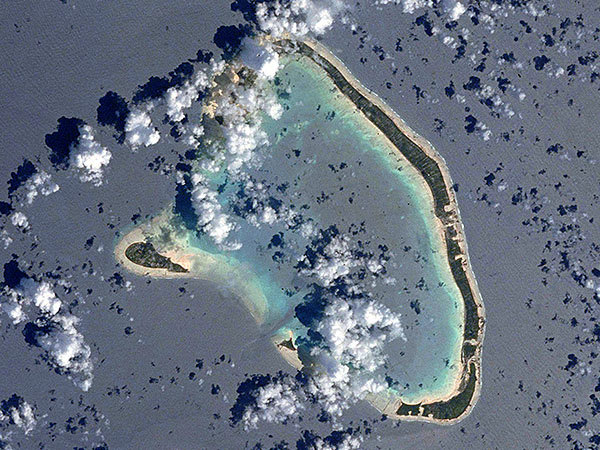
STS-61A mission crew
https://eol.jsc.nasa.gov
(public domain)
All in all it appears to me that both, the Polynesian- as well as the Friendly Ground Doves, indeed had been introduced sometimes during the middle 1930s, during WWII to at least the Abemama atoll, it appears not to be known by whom, and it also appears not to be known if they still exist there.
Interesting is the statement that at least one of them had been brought from Nauru, where no groud dove species is known to have existed – and if one has existed it might rather have been a distinct, endemic one, but not the Polynesian Ground Dove.
Maybe someone with an interest in birds will be able to make a visit to the Abemama atoll some day and clarify these questions.
*********************
References:
[1] P. Child: Birds of the Gilbert and Ellice Islands colony. Atoll Research Bulletin 74:1-38. 1960
[2] A. B. Amerson Jr.: Ornithology of the Marshall and Gilbert Islands. Atoll Research Bulletin 127: 1-348. 1969
[3] Robert P. Owen: A checklist of the birds of Micronesia. Micronesica 13(1): 65-81. 1977
[4] Dirk H. R. Spennemann; Hemley Benjamin: Notes on the Avifauna of Ebon Atoll, Republic of the Marshall Islands. Historic Preservation Office 1992
*********************
edited: 30.07.2020
Lanius gambieranus – what is that?
When you’re dealing with extirpated/extinct birds, you will sooner or later come across species that raise more questions than others.
Such a species is the Mangareva-yes-what-actually?:
“Lanius gambieranus Lesson, 1844, Écho du Monde Savant, p. 232 (cf. Ménegaux, p. 180). IlesGambier. Type perdu depuis longtemps.
Connue seulement par la description du spécimen qui était autrefois dans la collection du Docteur Abeillé de Bordeaux. Lesson précise qu’une peinture fut préparée par M. Charles Thélot de Rochefort, mais nous n’avons pas retrouvé cette peinture, ni d’ailleurs le spécimen.
[RÉPARTITION ET STATUT]. – Selon Lesson, le spécimen décrit provenait des îles Gambier. Ces îles furent visitées par plusieurs expéditions maritimes françaises avant 1840, et le spécimen fut probablement rapporté par le frère de Lesson, le Docteur Adolphe Lesson, qui voyagea durant quatre années dans les mers du Sud comme «Chirurgien» à bord d’un bateau. Le spécimen était autrefois dans la collection Lesson à Rochefort.
Les seules autres mentions de passereaux aux îles Gambier sont données par Garrett qui trouva des fauvettes durant la seconde moitié du xix* siècle (Wiglesworth, 1891b) et par Buck (1938) qui note KOMAKO – «Reed Warbler». Signalons aussi qu’une fauvette fut observée sur l’îlot Tepapuri en 1971 (Thibault, 1973b). Ce dernier oiseau, blanchâtre dessus et brun dessous, devait être un erratique de la forme habitant les atolls au nord des Gambier, A. caffer ravus. Deux spécimens M.N.H.N ont été considerés comme des oiseaux pouvant provenir des îles Gambier (Lacan et Mougin, 1974b), mais il s’agit vraisemblabIement d’une forme éteinte d’ A. luscinia provenant de Micronésie (Holyoak et Thibault, 1978b). L’expédition Whitney ne trouva pas de fauvette en visitant les îles Gambier, en dépit de nombreuses recherches en 1922 (Beck et Quayle, ms).
[DISCUSSION], – L’oiseau décrit par Lesson ne correspond à aucune forme de spécimens connus. Il est douteux qu’il s’agisse d’une pie-grièche (Laniidae), comme l’avait pensé Lesson. Il est également peu probable que se soit un siffleur (Pachycephala), comme certains auteurs l’ont suggéré (Lacan et Mougin, 1974b; Thibault, 1973b).
La taille, la forme et la coloration font plutôt penser à une fauvette, voisine des formes habitant les îles Cook. Cette hypothèse serait d’autant plus vraisemblable qu’il serait étonnant que des îles volcaniques de la taille des Gambier n’aient pas eu de fauvettes. Sans doute, Lesson avait déjà décrit en 1820 la Fauvette de Tahiti comme appartenant au genre Tatare, mais il n’est pas étonnant qu’il n’ait pas établi de relation entre cette fauvette et l’oiseau des Gambier, en raison de leurs différences morphologiques importantes.
De nombreuses interrogations subsistent au sujet de cet oiseau et il n’est pas évident qu’il ait été véritablement collecté aux Gambier, bien que les autres descriptions de Lesson ne présentent pas d erreurs de localité. “
translation:
“Lanius gambieranus Lesson, 1844, Écho du Monde Savant, p. 232 (cf. Ménegaux, p. 180). Gambier Islands. Type long lost.
Known only by the description of the specimen that was once in the collection of Doctor Abeillé de Bordeaux. Lesson specifies that a painting was prepared by Mr. Charles Thélot de Rochefort, but we have not found this painting, nor indeed the specimen.
[DIVISION AND STATUS]. – According to Lesson, the described specimen came from the Gambier Islands. These islands were visited by several French maritime expeditions before 1840, and the specimen was probably brought back by Lesson’s brother, Doctor Adolphe Lesson, who traveled for four years in the South Seas as a “surgeon” aboard a boat. The specimen was formerly in the Lesson collection in Rochefort.
The only other records of passerines in the Gambier Islands are given by Garrett who found warblers in the second half of the nineteenth century (Wiglesworth, 1891b) and by Buck (1938) who noted KOMAKO – “Reed Warbler”. It should also be noted that a warbler was observed on Tepapuri islet in 1971 (Thibault, 1973b). This last bird, whitish above and brown below [shouldn’t it be vice versa?], must have been an erratic of the form inhabiting the atolls north of the Gambiers, A. caffer ravus. Two M.N.H.N specimens have been considered as birds that may have originated from the Gambier Islands (Lacan and Mougin, 1974b), but they are probably an extinct form of A. luscinia from Micronesia (Holyoak and Thibault, 1978b). [they are now known to indeed be specimens of a species formerly inhabiting the island of Mangareva] The Whitney expedition did not find a warbler when visiting the Gambier Islands, despite extensive research in 1922 (Beck and Quayle, ms).
[DISCUSSION], – The bird described by Lesson does not correspond to any form of known specimens. It is doubtful that it is a shrike (Laniidae), as Lesson had thought. It is also unlikely to be a whistler (Pachycephala), as some authors have suggested (Lacan and Mougin, 1974b; Thibault, 1973b).
The size, shape and coloring are more like a warbler, similar to the forms found in the Cook Islands. This assumption would be all the more likely since it would be astonishing if volcanic islands the size of Gambier did not have warblers. No doubt Lesson had already described the Tahitian Warbler in 1820 as belonging to the genus Tatare, but it is not surprising that he did not establish a relationship between this warbler and the Gambier bird, because of their significant morphological differences.
Many questions remain about this bird and it is not obvious that it was really collected in Gambier, although the other descriptions of Lesson do not present errors of locality.” [3]
Today, most ornithologists think that the description fits best with the extinct Mangarevan Reed-Warbler, a bird that is known to have indeed existed. Yet, there are in fact two surviving specimens of this species, Acrocephalus astrolabii Holyoak & Thibault, which, however, are still often referred to as having been collected somewhere in Micronesia, an assumption that is now obsoleted. [4]
However, the reed-warbler was much larger than 14 cm, and it lacks the yellow underside that our enigmatic bird is said to have had; but let’s just take a look on the original description, it is in French and reads as follows:
„Cette pie-grièche est fort voisine du Lanius tabuensis de Latham. Comme elle, on la trouve dans le mer du Sud, et c’est aux îles Gambier qu’elle vit.
Cette espèce a les formes courtes et trapues. Elle mesure 14 centimètres. Ses ailes sont presque aussi longues que laqueue; son bec est peu crochu, bien que denté; il est noiràtre ainsi que les tarses; tout le plumage en dessus, les ailes et la queue sont d’un brun olivàtre uniforme; le devant du cou, à partir du menton jusqu’au haut de la poitrine, est olivàtre foncé; tout le dessous du corps, depuis le haut du thorax jusqu’aux couvertures inférieures, est du jaune le plus vif et le plus égal; les plumes tibiales sont brunes, mais cerclées d’une sorte de jarretiere jaune à d’articulation le dedans des ailes est varié de jaune et de blanc, ce qui forme un rebord étroit, blanc dessous du fouet de l’aile; la queue est légèrement échancrée, et le sommet des rectrices présente un point jaune.” [1]
Here is my translation:
“This shrike is very close to Lanius tabuensis [Aplonis tabuensis (Gmelin)] of Latham. Like this, it is found in the South Sea, and it lives in the Gambier Islands.
This species has a short, squat form. It measures 14 centimeters. Its wings are almost as long as the tail; the beak is slightly hooked, but dentate; it is black as well as the tarsi; all the plumage above, the wings and the tail are uniformly olive brown; the front of the neck, from the chin to the top of the breast, is dark olive; the whole lower part of the body, from the top of the thorax to the lower coverts, is the liveliest and most even yellow; the tibial feathers are brown, but circled in a sort of yellow, hinged garter, the underside of the wings is varied with yellow and white, forming a narrow, white rim beneath the whip of the wing; the tail is slightly forked, and the top of the rectrices are dotted yellow.”
You see, the species was described as a shrike (Laniidae) and as being very closely related to Lanius tabuensis.
Well, shrikes, of course, do not exist in Oceania at all, and Lanius tabuensis is called Aplonis tabuensis today and is a starling (Sturnidae), the South Sea Starling. You must know that in the 19th century still no one really had any idea of biogeography, and the same applies to the relationships between the different bird species.
Not a shrike, but what about a starling – Aplonis gambieranus?
Hm, according to the description rather not, the size (14 cm) seems a bit too small (my gut feeling), and the colors do not fit to any other Polynesian starling.
Not a starling, but what about a robin – Eopsaltria gambierana?
“EOPSALTRIA GAMBIERANA.
Lanius gambieranus, Less. Echo de M. S. 1844, p. 232.
Eopsaltria gambierana, Hartl. Wiegm. Arch. für Naturg. 1852, p. 133.
Low or Paumotu Islands (Gambier’s Islands or Mangarewa).” [2]
This genus does not occur in Polynesia, but the closely related genus Petroica does indeed (both genera belong to the family Petroicidae), however, both genera, in my eyes, can be excluded for biogeographic reasons.
Not a robin, but what about a whistler – Pachycephala gambierana?
The bird was for some time also thought to may have been a whistler and the genus Pachycephala indeed is occuring in Polynesia, yet only in the western part, namely in Fiji, Samoa and Tonga but not further east, so, no.
Not a whistler, but what about a monarch – Monarcha gambierana?
Personally, I think that the mysterious bird from the island of Mangareva most likely was a monarch species (Monarchidae), namely one of the genus Monarcha (formerly Pomarea). The size indication fits very well, as well as the specified colors, these fit quite well with the young birds of the surviving species of this genus. Apart from that, this genus also fits very well for biogeographical reasons, the distance between the Society Islands and the Gambier Archipelago is only slightly larger than that between the Society Islands and the Marquesas (where the genus still occurs today).
***
Lastly, I would like to mention that this species is officially no longer regarded as having existed at all, not just as dead/extinct, but as ‘having never existed’!
But why?
Because the type does not exist anymore? – this applies also to other species!
Because there was a picture that is now lost as well? – who actually is screwing up something like that, and … this too applies also to other species!
Because no one can say what kind of bird it actually could have been?
In my humble opinion this enigmatic bird, which might very well have existed, most likely was either an somewhat aberrant starling or a member of the monarch family.
*********************
References:
[1] R.-P. Lesson: Catalogue descriptif des oiseaux nouveaux, rares ou peu connus, de la collection Abeillé. L’Écho du monde savant et l’Hermès: journal analytique des nouvelles et des cours scientifiques. 1844 pt. 2: 232
[2] George Robert Gray: Catalogue of the birds of the tropical islands of the Pacific Ocean in the collection of the British Museum. London: printed by order of the Trustees 1859
[3] D. T. Holyoak; J.-C. Thibault: Contribution à l’étude des oiseaux de Polynésie orientale. Mémoires du Muséum national d’histoire naturelle 127(1): 1-209. 1984
[4] Alice Cibois; Jon S. Beadell; Gary R. Graves; Eric Pasquet; Beth Slikas; Sarah A. Sonsthagen; Jean-Claude Thibault; Robert C. Fleischer: Charting the course of reed-warblers across the Pacific islands. Journal of Biogeography 38(10): 1963-1975. 2011
*********************
edited: 29.07.2020
A Fijian quail?
Was there formerly a quail species living on the Fijian Islands?
Well, here is an account by Rollo H. Beck, an American ornithologist, who quotes some notes that he received by a Mr. G. T. Barker on June 5, 1925, during a stay on the island of Viti Levu, Fiji.:
“Moa (Quail)
It is commonly said, by whites, that quail are the offspring of imported birds, but this cannot be so for I have tales that run back for hundreds of years mentioning this bird. A Mr. Coster who was one of the first white settlers on the Island of Koro said that quail were present in great numbers when he arrived there and this was many years back.” [1]
Indeed, there was a quail species living on the Fijian Islands, and it still does, because this account clearly refers to the Brown Quail (Synoicus ypsilophorus ssp. australis (Latham)) (see photo), an Australian species that was introduced to the Fijian Islands sometimes in the early 1900s.
The species is commonly called moa on the islands, it was introduced at least to the islands of Makogai, Vanua Levu, and Viti Levu; it is, however, now apparently restricted to the (artificial) grasslands of Vanua- and Viti Levu. [2]
*********************
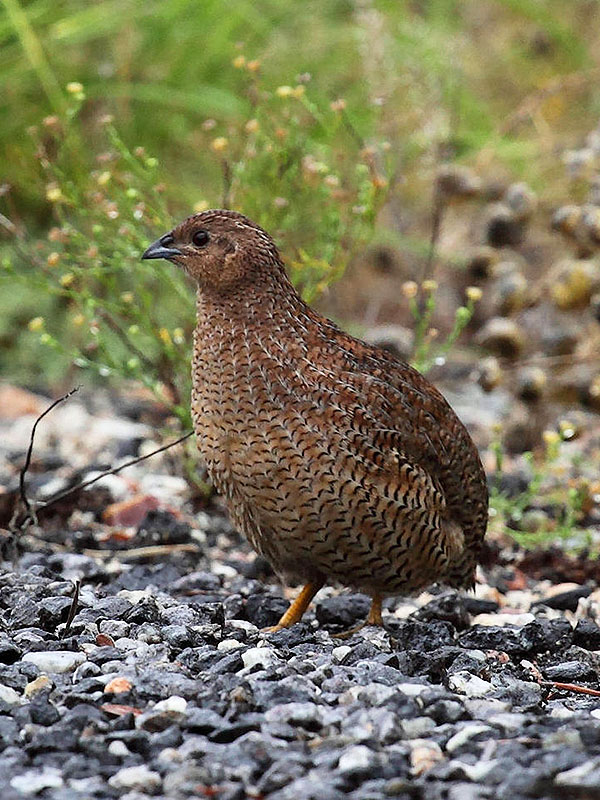
(under creative commons license (3.0))
http://creativecommons.org/licenses/by-sa/3.0
*********************
References:
[1] Whitney South Sea Expedition of the American Museum of Natural History. Extracts from the journal of Rollo H. Beck. Vol. 2, Dec. 1923 – Aug. 1925
[2] Edward Narayan: Troublesome birds of Fiji Islands. Lulu, Inc. 2014
*********************
edited: 29.07.2020
The ‘Blue Parrotfinch’ of Micronesia
The ‘Blue Parrotfinch’ of Micronesia is actually not really a mysterious bird, it is just the Blue-faced Parrotfinch (Erythrura trichroa (Kittlitz)).
This species inhabits northern Australia, New Guinea, the Maluku Islands, parts of Melanesia and, not least, the Micronesian islands, where it is found today on Chuuk, Kosrae, Palau, and Pohnpei; it very likely was once more widespread and did also inhabit the atolls surrounding these islands, especially those between Chuuk and Pohnpei, which share the same subspecies (ssp. clara Taka-Tsukasa & Yamashina).
The following sentence was taken from an account by J. D. E. Schmeltz and R. Krause from 1881 and apparently refers to the Satawan atoll (unfortunately I couldn’t get my hands on the original).:
“Ein verschlagenes Exemplar der Erythrura trichroa schoss K. [Kubary] einmal hier.” [1][2]
translation:
“K. shoot a stray specimen of the Erythrura trichroa here once.”
***
This species is now mainly found in the higher parts of the abovementioned islands, but very likely was more widespread once, and it is absloutely possible, I guess, that it also inhabited at least some of the atolls between the islands, like so many other Micronesian land birds do.
***
The name ‘Blue Parrotfinch’ refers to a specimen that was collected on Pohnpei and was kept in spirit for some years, thus it lost its green color and its plumage turned into a plain blue; this specimen was later described in 1876 as a distinct species, Erythrura glauca Finsch (see photo).
*********************
References:
[1] J. D. E. Schmeltz; R. Krause: Ein Beitrag zur Kunde der Südsee-Völker. Die Ethnographisch- Anthropologische Abtheilung des Museum Godeffroy in Hamburg. L. Friederichsen & Co., Hamburg 1881
[2] Donald W. Buden: The birds of Satawan Atoll and the Mortlock Islands, Chuuk, including the first record of Tree Martin Hirundo nigricans in Micronesia. Bulletin of the British Ornithologists’ Club 126(2): 137-152. 2006
*********************
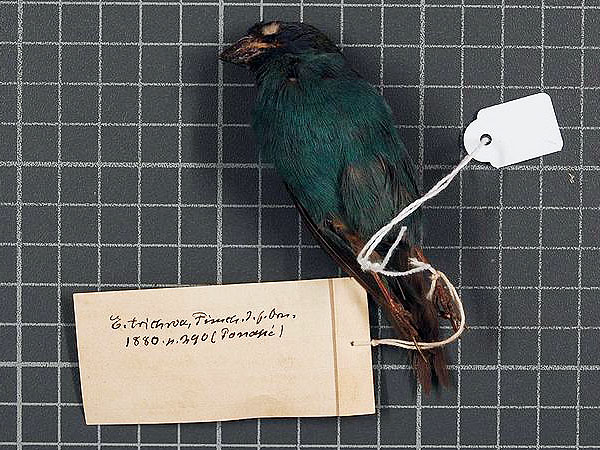
Photo: Naturalis Biodiversity Center
(no copyright)
*********************
edited: 29.07.2020
Miller’s Rail
Miller’s Rail is one of the more commonly known so-called mysterious birds.
This species is actually known exclusively from a single drawing made by Georg Forster sometimes between 1772 and 75 during the second voyage of James Cook [and a copy of it made by John Frederick Miller, who described the bird as a new species in 1784]. The annotation just states that it is a Rallus minutus, [a small rail], [called] Maho, [and coming from] Taheitee, [Tahiti].
The drawing is rather a crude one, not „fieldguide-suitable“ and shows a small bird, clearly identifiable as a crake, with rather dark, almost black feathers, sitting on its red legs.
The bird could very well just be a Spotless Crake (Zapornia tabuensis (Gmelin)), which today is still [patchily these days] distributed all over Polynesia, and of course was even more so 250 years ago!
***
There is yet another quite detailed description supposed to be of this species, made by John Latham in 1785 from the actual type, that is now lost.:
„Otaheite R[ail].
LENGTH six inches. Bill three quarters of an inch, black: the head, neck, and all the under parts of the body, dark ash-colour: palest on the chin: the upper parts, and wing coverts, deep red brown: quills dusky, edged with white: edge of the wing, and the first quill feather, white: tail an inch and a half long, rounded in shape, and black: legs dusky yellow. Claws black.
Inhabits Otaheite, and the Friendly Isles. Sir Joseph Banks.“ [2]
***
The same book contains the description of a variety of the Tabuan rail [now Spottless Crake (Zapornia tabuensis)] from the island of Tanna in the Solomon Islands chain which is often regarded to as being the description of the actual type specimen of Miller’s Rail, however, the description differs quite significantly from G. Forster’s depiction.:
“This varies in having the plumage more inclined to brown: the vent white, transversely barred with black lines: legs red.
Inhabits the island of Tanna. Sir Joseph Banks.” [1]
The island of Tanna, mentioned here as place of origin of this bird, was just one of several islands that were visited by Cook and his entourage in the middle of the 18th century, and the place names given by J. Latham are very often completely wrong, however, the descriptions on the other hand are rather complete and trustworthy.
It has to be taken into account that such old books most often lack any kind of register and that they mostly just use common names but lack scientific ones, searching inside them is a long-term venture.
***
It is now quite well known that in former times probably all of the islands in the tropical Pacific Ocean were inhabited by endemic rails, with several islands being known to have been inhabited by more than one species, and in many cases these were congeneric species, meaning species from one and the same genus – something that today is extremely rare, which, however, is a relict situation, left behind by human-induced extinctions. [5]
***
In ancient Tahiti, the meho too was thought to represent a deity, namely Tu (in his manifestation of moonlit sky), the meho‘s cry is given as having been a “ho”, which is also thought to be the characteristic sound made by Tu himself. [3][4]
This little sentence is yet another prove for the former existence of another rail species on Tahiti beside the Red-billed Rail (Gallirallus pacificus (Gmelin)), which is also mentioned in this short enumeration of birds representincg gods in ancient Tahiti.
*********************
References:
[1] John Latham: A General Synopsis of Birds 3(1): 235. Leigh & Sotheby, London 1785
[2] John Latham: A General Synopsis of Birds 3(1): 236. Leigh & Sotheby, London 1785
[3] Teuira Henry: Ancient Tahiti. Bishop Museum Bulletins 48: 1-651. 1928
[4] Douglas L. Oliver: Ancient Tahitian Society. The University Press of Hawai’i, Honolulu 1974
[5] David W. Steadman: Extinction and Biogeography of Tropical Pacific Birds. University of Chicago Press 2006
*********************

(public domain)
*********************
edited: 28.07.2020
Der Harlequinkolibri – eine Art die nie existiert hat … oder doch?
Diese heute wohl kaum mehr bekannte ‘Art’ wurde im Jahr 1788 anhand eines einzelnen Exemplars sowie einer Beschreibung von John Latham [1] als Trochilus multicolor Gmelin beschrieben.
Der Harlequinkolibri erreichte laut Beschreibung eine Größe von insgesamt 12,7 cm, hatte einen relativ langen Schnabel und war recht auffällig gefärbt.
Es sind einige Abbildungen dieser ‘Art’ überliefert, im Ganzen existieren allerdings eigentlich nur zwei verschiedene Darstellungen, die wieder und wieder von verschiedenen Künstlern kopiert wurden. [2]
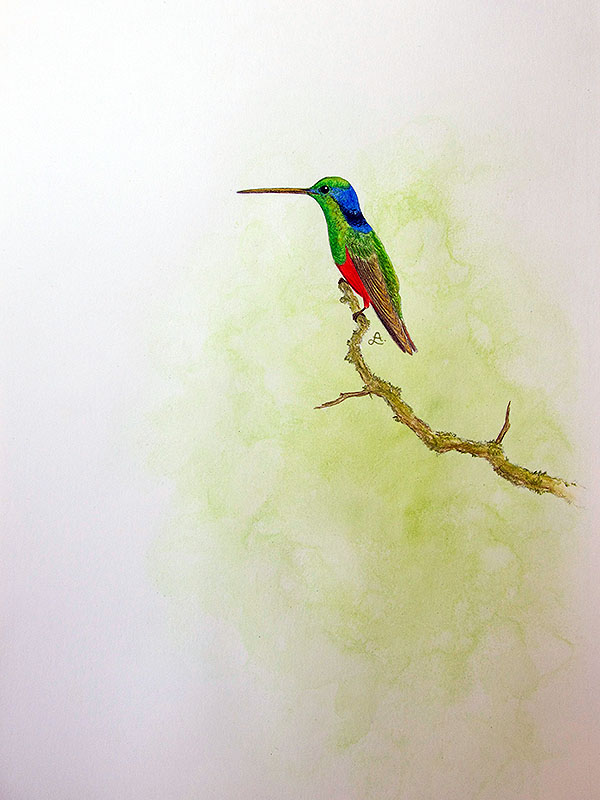
Das einzige bekannte Harlequinkolibri-Exemplar wurde 1819 (?) als Fälschung erkannt und letzlich weggeworfen, so dass es nicht mehr für weitere Untersuchungen zur Verfügung steht. [2]
*********************
Referenzen:
[1] John Latham: Supplement to the General synopsis of birds. London: printed for Leigh & Sotheby 1787
[2] Robert Prŷs-Jones; Rick Wright: Rise and fall of the Harlequin Hummingird ‘Trochilus multicolor’: a species that never was. Bulletin of the British Ornithologists’ Club 139(3): 215-227. 2019
*********************
bearbeitet: 17.05.2020
Levaillant’s Pie-Grièche Rouge A Plastron Blanc
Levaillant’s Pie-Grièche Rouge A Plastron Blanc, the White Shrike with the Red Breastplate, is one of several enigmatic species of birds that were described in the early 1800s based on stuffed specimens that were actually just fakes composed by some business-minded taxidermist from the parts of several other birds, a practise that was quite common in former times.
The more unusual such a specimen the higher probably was its price ….

(not in copyright)
Here is a part of the description, which mentions the supposed origin of this ‘species’ as having been the islands of the South Seas, which actually could be anywhere …:
“Cette belle espèce appartient, à ce qu’on m’a assuré, aux îles de la mer du Sud. De quatre individus que j’ai vus, deux avoient la barre de l’aîle blanche au lieu d’être rouge; celles-ci seroient- elles des femelles? C’est ce que j’ignore, n’ ayant euà leur égard aucun renseignement quelconque, et n’ayant vu que les peaux rembourrées de ces oiseaux.“
translation:
“This beautiful species belongs, as I have been assured, to the islands of the South Sea. Of the four individuals I saw, two had the bar of the wing white instead of being red; would these be females? This is what I do not know, having had no information whatsoever about them, and having only seen the padded skins of these birds.“
***
However, the fake was uncovered 60 years later.:
“Note. – The Lanius mystaceus, Lath. Ind. Orn. Suppl. p. xix; Levaill. Ois. d’Afr. t. 65 (Laniarius mystaceus, G. R. Gray, Gen. of B. i. p. 299), has been stated by Levaillant to be from an isle in the South Seas. It is, however, a made-up bird, being composed of a portion of the Lanius ferrugineus, Gm., with the feathers on the belly and tail from a species of red Psittacus, while the breast and vent are those from a species of Malaconotus.” [2]
The Lanius ferrugineus, Gm., mentioned here, is the Southern Boubou (Laniarius ferrugineus (J. F. Gmelin)) a bird without red feathers, so I personally think that the original body was ‘borrowed’ from another species, possibly from the Crimson-breasted Gonolek (Laniarius atrococcineus (Burchell)), which then got decorated with the red tail feathers of another bird, which might well have been some species of parrot.
*********************
References:
[1] François Le Vaillant: Histoire naturelle des oiseaux d’Afrique. Paris, chez J. J. Fuchs, libraire, Rue des Mathurins, Hôtel de Cluny: de l’imprimerie de Perroneau, Rue des Grands Augustins 1799
[2] George Robert Gray: Catalogue of the birds of the tropical islands of the Pacific Ocean in the collection of the British Museum. London: printed by order of the Trustees 1859
*********************
edited: 21.03.2020
The less popular case of Columba R. forsteri
A pigeon collected during one of J. Cook’s journeys in the middle of the 18th century on the island of Tahiti, Society Islands, was described and named Columba R. forsteri in 1829 by J. G. Wagler, this is the original description.:
“C. R. Forsteri. Habitus et magnitudo C. globicerae; capite et cervice prorsus nigris; dorso, uropygio, remigibus et rectricibus coeruleo et viridi nitentibus; gula, jugulo, pectore, abdomine femoribusque fuliginosis; crisso ferrugineo; capistro albo; cera prorsus non globosa.
Columba globicera var.? Reinh. Forster in Manuscr.
Rostrum nigrum; pedes rubri. Habitat in insula Otaheite, ab incolis Aroobu appeliate.” [1]
(my humble) translation:
“C. R. Forsteri. Shape and size of C. globicera; head and neck completely black; on the back, from the rump, and the rectrices shining blue and green; throat, neck, breast, belly (hips?) sooty; undertail coverts ferruginous; lores white; cere absolutely not globose.
Columba globicera var.? Reinh. Forster in Manuscr.
Beak black; feet red. Inhabits the island of Otaheite, named by the islanders Aroobu.“
***
According to S. L. Olson and D. W. Steadman this description fits very well with the Nuku Hiva Imperial Pigeon (Ducula galeata (Bonaparte)), which is now restricted to the island of Nuku Hiva, Marquesas, but which indeed is known to have been much more widespread in former times. [2]
However, this species is much larger than the Polynesian Imperial Pigeon (Ducula aurora Peale) from Tahiti, named Columba globicera in the description, and not of the same size, and its head and neck are slate-colored and not black as the description says; anyway, neither the adult nor the juvenile Polynesian Imperial Pigeon have ferruginous undertail coverts while the Nuku Hiva Imperial Pigeon again has.

Photo: Samuel Etienne
http://creativecommons.org/licenses/by-sa/3.0
So, after all, this little description may indeed be the only historical record of the Nuku Hiva Imperial Pigeon outside the island of Nuku Hiva, it disappeared sometimes during the 18th century. Subfossils assigned to this large bird are now known from Mangaia, Cook Islands; Hiva Oa, Tahuata and Ua Huka, Marquesas; as well as from Huahine, Society Islands. [3]
However, I personally still have some doubts about the identity of these large imperial pigeon forms outside of the Marquesas, in my humble opinion they should rather be considered distinct forms.
*********************
References:
[1] J. G. Wagler: Beiträge und Bemerkungen zu dem ersten Bande seines Sytsema Avium. (Fortsetzung III.) Isis von Oken 7: 735-762. 1829
[2] S. L. Olson; D. W. Steadman: Comments on the proposed suppression of Rallus nigra Miller, 1784 and Columba R. Forsteri Wagler, 1829 (Aves) .Bulletin of Zoological Nomenclature 44, 126-127. 1987
[3] David W. Steadman; Dominique S. Pahlavan: Extinction and biogeography of birds on Huahine, Society Islands, French Polynesia. Geoarchaeology 7(5): 449-483. 1992
*********************
edited: 18.03.2020
A ground dove from Karoraina?
The genus Pampusana, formerly Gallicolumba and then Alopecoenas, apparently did once occur also as far northeast as to the Line Islands of Kiribati, as can be taken from an account from 1840 by Frederick Debell Bennett about a stay on Caroline Island, now named Karoraina.:
“At night, on the 22nd of April, many shoal-birds came about the ship, greeting us with their hoarse cries, so prophetic of the vicinity of land; and at daybreak on the following morning, Caroline Island was seen from the mast-head, bearing N.W., distant 10 miles.
…
The inland thickets contained a great number of small pigeons, with white head and neck, and the rest of their plumage of a rich brown colour.” [1]
This account might refer to a population of the Polynesian Ground Dove (Pampusana erythroptera (Gmelin)) as suggested by David W. Steadman & Dominique S. Pahlavan or, given the extreme distance between the northernmost Tuamotuan atolls and the island of Karoraina, may perhaps rather refer to a distinct, now extinct species. [2]
*********************
References:
[1] F. D. Bennett: Narrative of a Whaling Voyage round the Globe, from the year 1833 to 1836. London: Richard Bentley 1840
[2] David W. Steadman; Dominique S. Pahlavan: Extinction and biogeography of birds on Huahine, Society Islands, French Polynesia. Geoarchaeology 7(5): 449-483. 1992
*********************
edited: 17.03.2020
A reed-warbler from Rurutu?
I found another interesting account that I had overlooked previously in ‘Te Manu: Bulletin de la Société d’Ornithologie de Polynésie. Nr 25. December 1998’.:
“De notre correspondant Yves GENTILLOMME à Rurutu
Lors du passage de Jean-Yves Meyer sur l’île de Rurutu, Yves Gentillomme lui a signalé avoir entendu le chant facilement reconnaissable d’une fauvette (Acrocephalus sp.). Il n’y a pas de description de fauvettes à Rurutu dans la littérature mais on en trouve une sur l’île voisine de Rimatara: Acrocephalus rimitarae (autrefois considérée comme une sous espèce de Acrocephalus vaughani de Pitcairn) – cf TE MANU n°23. Il s’agit peut être d’un oiseaux en provenance de cette île. Il existe une autre observation de fauvette aux Australes sur l’île de Raivavae. Cette observation ancienne n’a jamais été renouvelée.” [1]
translation:
“From our correspondent Yves GENTILLOMME in Rurutu
During Jean-Yves Meyer’s visit to Rurutu Island, Yves Gentillomme told him that he heard the easily recognizable song of a warbler (Acrocephalus sp.). There is no description of warblers in Rurutu in the literature but there is one on the neighboring island of Rimatara: Acrocephalus rimitarae (formerly considered as a subspecies of Acrocephalus vaughani from Pitcairn) – see TE MANU n°23. It may be a bird from this island. There is another sighting of a warbler in the Austral Islands on Raivavae Island. This ancient observation has never been repeated.“
***
Today the island of Rurutu does not harbor an endemic reed-warbler species but it may well have done so in former times; the neighboring island of Rimatara, however, still is home to an endemic form of reed-warbler, the Rimatara Reed-Warbler (Acrocephalus rimitarae (Murphy and Mathews)), and the bird heard singing on Rurutu in the late 1990s might indeed have been such a bird.
The Rimatara Reed-Warbler may be in the state of expanding its distributional area, or there may just be some stray birds appearing on neigboring islands from time to time.
There is, however, a very little possibility that there is an endemic Rurutu Reed-Warbler that has survived into the late 1990s.
*********************
References:
[1] Te Manu: Bulletin de la Société d’Ornithologie de Polynésie. Nr 25. December 1998
*********************
edited: 17.03.2020
A sandpiper from the Manua’e Atoll, Society Islands?
“The quail spoken of by an early writer as occurring on Christmas [Kiritimati] and possibly other islands was probably the native sandpiper, as it resembles a quail when running on the ground and a merchant here told me the other day of quail on Scilly Islands [Manua’e] which he is putting into coconuts.” [1]
***
This rather incidental and somewhat strange side note is the only reference to the past existence of a species of sandpiper (Prosobonia sp.) on the ‘Leeward Islands’ in the Society Islands group, a species of the same genus known to have inhabited the islands in the past islands of Mo’orea and Tahiti in the southeast of the same archipelago.
The only island in this group on which a fossil site has been discovered so far is Huahine, from where there are, at least so far, no finds of this genus.
The form from the Manua’e Atoll, if it really existed – and I think it might well have existed – might have been identical to that known from subfossil remains found on the island of Mangaia in the Cook Archipelago [2], or it may have been a distinct form; but it was certainly not identical with the birds of the islands of Mo’orea and Tahiti, and it was certainly not identical with the Tuamotu Sandpiper (Prosobonia parvirostris (Peale)), since the Manua’e Atoll is much closer to the Cook Archipelago than to the Tuamotu Archipelago.
Interestingly, the report cited above appears to date from the early 20th century, indicating that various Polynesian bird forms might have survived much longer than is often assumed.
*********************

Photo: NASA
https://eol.jsc.nasa.gov
(public domain)
*********************
References:
[1] Whitney South Sea Expedition of the American Museum of Natural History. Extracts from the journal of Rollo H. Beck. Vol. 1, Sept 1920 – June 1923
[2] D. W. Steadman: Extinction and Biogeography of Tropical Pacific Birds. University of Chicago Press 2006
*********************
edited: 05.07.2023
A Fijian hummingbird?
Rollo H. Beck, an American ornithologist, quotes some notes that he recieved by a Mr. G. T. Barker on June 5, 1925, during a stay on the island of Viti Levu, Fiji: ‘Notes by Mr. G. T. Barker, Suva, Fiji. June 5, 1925’.
One of these notes is about an alleged Fijian hummingbird.:
“Humming bird
One evening as I was sitting on the steps, I saw what I took to be a night moth settle on a hibiscus flower. …
The supposed moth kept its wings in rapid motion, while poised before the flower sucking the honey with its long slender bill.
I struck the “moth” with a fly switch which I had in my hand, and on picking it up, found that I had killed a small bird. I had seen only the pictures of humming birds but I concluded that this was one. Its slightly curved bill was black, as was the slender, pointed tail; the fine feathers on the breast were a bright red; the shoulders and patch under the tail were of darker tone.
Herewith is a sketch drawn to scale, which I made the next morning, after I found that the rats had eaten the bird from the wall where I pinned it.
1921“
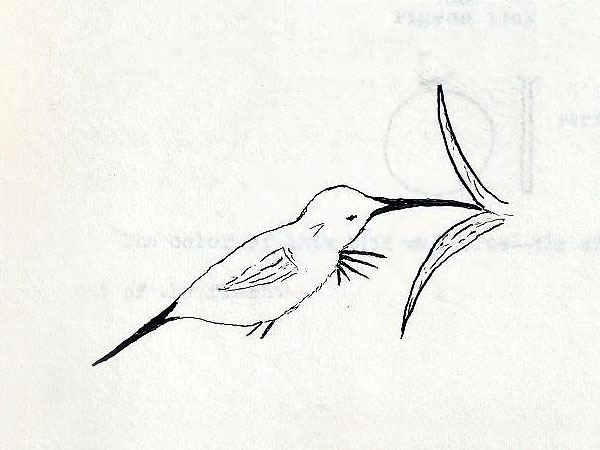
(public domain)
“Feathers, fine as the fur of flying fox
Wings, very small
Body, red
Head and back, darker than breast
Bill and legs, black” [1]
Of course, hummingbirds are not found outside of the Americas, and this anecdote is
supposed to have taken place on the island of Viti Levu, Fiji.
But what kind of bird is involved in this story then?
I have to confess that I have no real idea, the most likely candidate is the orange-breasted Myzomela (Myzomela jugularis Peale), however, this species hasn’t a red body.
***
I personally think that this account is a very bad eyewithness records, made by someone not really interested in the natural world.
*********************
References:
[1] Whitney South Sea Expedition of the American Museum of Natural History. Extracts from the journal of Rollo H. Beck. Vol. 2, Dec. 1923 – Aug. 1925
*********************
edited: 14.03.2020
Was there once a Giant Kingfisher living on the Fiji Islands?
The Collared Kingfisher (Todiramphus chloris (Boddaert)) has a extremely wide distribution and occurs from parts of Arabia well into western Polynesia; it is the only kingfisher living on the Fiji Islands (with three endemic subspecies) – yet, may there once have been another kingfisher species?
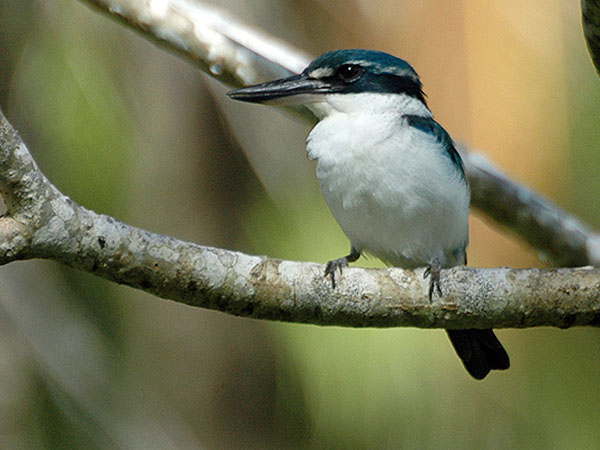
Photo: Tom Tarrant
http://creativecommons.org/licenses/by-sa/3.0
Rollo H. Beck, an American ornithologist, quotes some notes that he received by a Mr. G. T. Barker on June 5, 1925, during a stay on the island of Viti Levu, Fiji: ‘Notes by Mr. G. T. Barker, Suva, Fiji. June 5, 1925’.:
“Giant Kingfisher
I saw this bird, or a single bird at least, on two occasions and it rose, both times, from nearly the same place. On the last occasion, I was on the lookout for it and it passed within twenty feet in front of me so that I had a good opportunity to see it clearly. I was riding down from the village of Navuniwi, Viti Levu Bay, toward the beach and it was from a patch of swampy ground on my left that the bird arose.
The kingfisher was fully eleven inches long, with the same colored plumage as the small kind only more dingy. The blue was not so bright, and the white feathers on the wings were discolored. The back was nearly black. Its flight was heavy-much slower than that of the small species, and as it flew in a straight line toward the mangrove swamp on my right, I noticed that it held its head in a line with the shoulders.
Natives told me that these giant kingfishers were plentiful in the early days, but as the bird nested in the low mangrove, it has practically disappeared since the advent of the mongoose which is a vertitable beach comber, haunting the swamps and beaches. About twenty-five years previously I had seen one of them back of Ovalau, but was told that it was only stray in that part.
On the second occasion of my seeing the giant flycatcher [indeed, he writes flycatcher here instead of kingfisher], I dismounted from my horse and went into the swampy patch, finding that the bird had been eating the native sila (Job’s tears) [Coix lacryma-jobi (L.) Lam.].
Ordinary Flycatcher [?]
It is generally supposed that this bird is an insect eater, and does not eat fish, but this is not invariably so. As I was coming out of the Wainidoi River, ten miles below Suva, I saw a belo [Pacific Reef Heron (Egretta sacra (Gmelin))] fishing in shallow water, and getting close up, noticed that it had a kingfisher in company. Three times I saw the kingfisher dive into the shallow water after shrimps, then fly onto a rock to eat them.” [1]
So, what’s this somewhat strange account about?
There is indeed a possibility that the large Fijian Islands once harbored more than one kingfisher species, however, this particular account here pretty sure refers to the Collared Kingfisher, with the small species mentioned being the European Kingfisher (Alcedo atthis (L.)).
The whole account is expressed a bit unhappily, and this Mr. G. T. Barker very likely wasn’t a naturalist at all, that becomes very clear when he later also descibes a hummingbird that he had killed on the Fijian Island, and which in fact has been a honeyeater (Myzomela jugularis Peale) (his description, however, does not fully match that species, but that is another story ….).
*********************
References:
[1] Whitney South Sea Expedition of the American Museum of Natural History. Extracts from the journal of Rollo H. Beck. Vol. 2, Dec. 1923 – Aug. 1925
*********************
edited: 13.03.2020
Astrapia-Paradieshopf
Astrapia-Paradieshopf (Epimachus astrapioides Rothschild)
Der überaus schöne Astrapia-Paradieshopf ist anhand genau eines einzigen männlichen Exemplars bekannt.
Die Form, auch als Grünbrüstiger Reifelvogel bekannt, wurde 1897 als eigenständige Art beschrieben. Es handelt sich jedoch um einen Hybriden zwischen der Fächerparadieselster (Astrapia nigra (Gmelin)) und dem Breitschwanz-Paradieshopf (Epimachus fastuosus (Hermann)).
Es ist etwas seltsam, dass dieselben Arten die Eltern einer vollkommen anders aussehenden Form, nämlich Elliots Paradiesvogel (Epimachus elliotti Ward) sein sollen.
********************
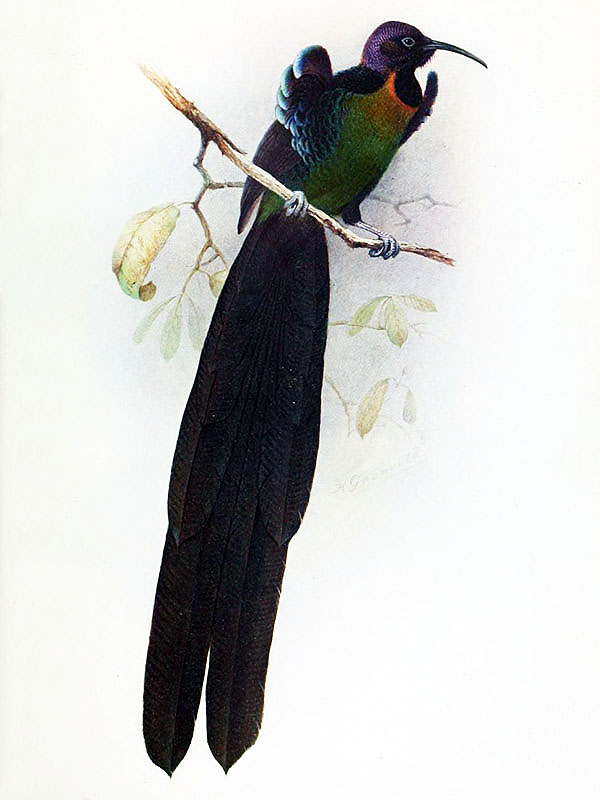
(public domain)
********************
Quelle:
[1] Clifford B. Frith; Bruce M. Beehler: The Birds of Paradise: Paradisaeidae. Oxford University Press 1998
********************
bearbeitet: 14.03.2021
Ari-manou – an extinct parrot from Bora Bora?
While checking old papers regarding the enigmatic Divine Kingfisher from the island of Bora Bora, I found that the same paper mentions the existence of a lorikeet on the same island, well actually even two species of lorikeets, one being the Blue Lorikeet (Vini peruviana (Statius Müller)) and the other one being Kuhl’s Lorikeet (Vini kuhlii (Vigors)).
Or was it something else?
***
Well here are the original text passages.:
“On nous donna á Borabora une espèce vivante de perruche très-voisine du phigy de Levaillant …, peut-être encore plus voisine de la perruche fringillaire …, et que M. Vigors a décrite récemment … sous le nom de psittacula Kuhlii.
Cet oiseau, sur lequel nous fournirons de nouveaux détails dans la partie descriptive des espèces, a la langue terminée par un petit cercle de papilles nerveuses; ses habitudes sont vives et colériques, et son naturel sauvage.”
translated:
“We were given on Borabora a living species of parrot very close to the phigy of Levaillant …, perhaps even closer to the parakeet that Mr. Vigors has recently described … under the name of psittacula Kuhlii.
This bird, on which we will furnish new details in the descriptive part of the species, has the tongue terminated by a small circle of nerve papillae; his habits are lively and angry, and his temper is wild.”
and the second part:
“Cet oiseau a les narines en scissure et la langue terminée par un cercle de papilles longues, qu’on retrouve chez l’ Ari-manou. Il se nourrit de bananes, et son caractère est extrêmement colérique. Nous nous le sommes procuré dans l’île de Borabora.
Cette petite perruche à queue pointue a de longueur totale six pouces. Son bec et ses tarses sont orangés; le front est vert; les plumes de la tête et de l’occiput sont longues, étroites, d’un bleu céleste au sentre et frangées de noir sur les bords; les joues, le devant de la gorge et du cou, jusqu’au haut du ventre, sont d’un rouge vermillon mat: le milieu du ventre est aussi de ce même rouge, mais la région anale et les plumes des cuisses sont dún bleu pourpré. Le plumage est en entier d’un vert lustré clair, plus foncé et teint roussatre sur le manteau; la queue est jaune en-dessous et verte et jaune en-dessus. Les rémiges sont noires et vertes.”
translated:
“This bird has cracked nostrils and the tongue ends with a circle of long taste buds, found in the Ari-manou [?]. It feeds on bananas, and its character is extremely choleric. We obtained it on the island of Borabora.
This small parrot with a pointed tail has a total length of six inches [ca. 15,3 cm]. Its beak and tarsi are orange; the forehead is green; the feathers of the head and of the occiput are long, narrow, of a heavenly blue in the center, and fringed with black on the edges; the cheeks, the front of the throat and the neck, up to the upper part of the belly, are of a matt vermilion red: the middle of the belly is also of this same red, but the anal region and the feathers of the thighs are of a blue purple. The plumage is entirely lighter green, darker and reddish on the mantle; the tail is yellow below and green and yellow above. The flight feathers are black and green.”
***
Well, the description mostly fits with Kuhl’s Lorikeet, except for the color of the mantle (said to be darker and reddish; but is yellowish green in V. kuhlii), and the tail (said to be yellow below and green and yellow above; but is yellowish green and red in V. kuhlii).
So what do we have here?
Kuhl’s Lorikeet was once more widely distributed, this is a fact that is known, the bird inhabited mostly all of the Austral- and the Cook Islands, but what about the Society Islands?
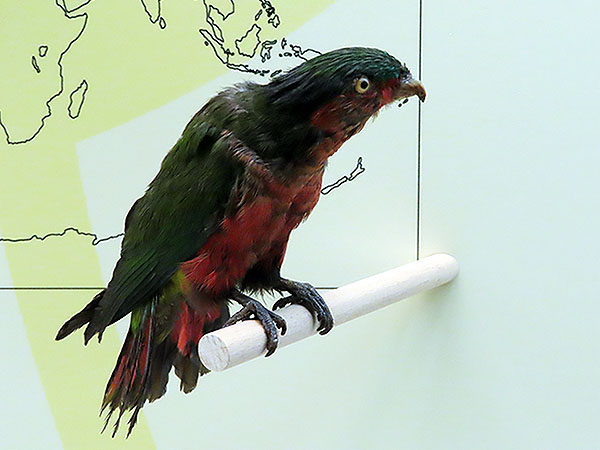
There are also some old oral traditions from the Society Island published in 1928, mentioning at least seven different kinds of parrots, some can be identified as well-known species, others can’t.
***
My guess is, the likeliest possibility is that this parrot from Bora Bora may represent a now extinct subspecies of Kuhl’s Lorikeet from the Society Islands.
***
There’s a little update here as well:
The following small account is found in G. R. Gray’s ‘ Catalogue of the birds of the tropical islands of the Pacific Ocean in the collection of the British Museum’.:
“CORIPHILUS KUHLII
…
‘Ari-manou’ of the natives of the Society Islands.
Society Islands (Borabora); Sandwich Islands.” [2]
I thus changed the name of the supposed bird in the headline.
*********************
References:
[1] Teuira Henry: Ancient Tahiti. Bishop Museum Bulletins 48: 1-651. 1928 [2] M. L. I. Duperrey: Voyage autour du monde: Exécuté par Ordre du Roi, Sur la Corvette de Sa Majesté, La Coquille, pendant les années 1822, 1823, 1824, et 1825, par M. L. I. Duperrey; Zoologie, par Mm. Lesson et Garnot. Paris: Arthus Bertrand 1828
[2] George Robert Gray: Catalogue of the birds of the tropical islands of the Pacific Ocean in the collection of the British Museum. London: printed by order of the Trustees 1859
*********************
edited: 05.01.2023
A swamphen from Ra’iatea?
Swamphens (genus Porphyrio) are distributed worldwide (except of course Antarctica), five species are currently officially recognized. In my opinion there are actually more species, 11 to be exact, namely if the Purple Swamphen (species complex) is split into the distinct species which it actually consists of.
And then there are the extinct members including five described species and seven not-yet-described ones.
***
And … then there are the hypothetical ones … two so far, one of which I have already written about here:
The Tahitian Mountain Goose
The other one is way less mysterious and on the other hand much more mysterious, it is a swamphen from Ra’iatea, Society Islands.
The island of Ra’iatea lies 50 km east of Huahine, the home island of McNab’s Swamphen (Porphyrio mcnabiKirchman & Steadman), one of 12 the extinct swamphen forms known on the basis of subfossil bones only.
***
What do we actually known about the mysterious bird of today’s post?
Not much. There is a little note among a big listing of Polynesian (including Melanesian and Micronesian) birds, which says the following.:
„319.* Porphyrio sp.
Porphyrio sp. (Schmeltz), Cat. Mus. Godef. 1874 V, p. XVI; Garrett, 1. C. note.
Island of Raiatea, Society Is. (Garrett).
This species is known from two young specimens only.“ [1]
***
And that’s it.
I could not find out anything else.
But … the Australian Swamphen is known to be a trampy species and has colonized new Zealand only quite recently, maybe only after the colonization of the islands by the first Polynesians. The same species has also colonized parts of Oceania, where the ssp. pelewensis Hartlaub & Finsch has evolved in Palau and the ssp. samoensis Peale (including. ssp. vitiensis Peale) in western Polynesia.
So, the two Ra’iatean birds may in fact not have been collected on Ra’iatea at all but on another island, or they may have been taken there but may have originated from another place, maybe from Samoa, the closest place where swamphens still exist today.
… or the Ra’iatean birds were indeed a distinct subspecies or perhaps rather species that survived into the 19th century.
***
Here is a little update for this enigmatic bird.:
“Porphyrio porphyrio (L.), Talève poule-sultane.
La seule citation de l’espèce en Polynésie orientale est due à Wiglesworth (1891b) qui mentionne «Porphyrio species» à Raiatea d’apres deux spécimens immatures collectés par Andrew Garrett. Il semble que les spécimens aient disparu. Il est douteux qu’il s’agisse d’une erreur d’étiquetage car Garrett ne visita certainement pas les Samoa, ni d’autres îles de ‘ouest du Pacifique. Ces oiseaux étaient donc, soit des visiteurs de Samoa, soit les représentants d’une population vivant autrefois à Raiatea et éteinte depuis longtemps.” [2]
translation:
“Porphyrio porphyrio (L.), Purple Swamphen.
The only quotation of the species in Eastern Polynesia is due to Wiglesworth (1891b) which mentions «Porphyrio species» in Raiatea according to two immature specimens collected by Andrew Garrett. The specimens appear to have disappeared. It is doubtful that this was a labeling error because Garrett certainly did not visit Samoa or other islands in the western Pacific. These birds were therefore either visitors from Samoa or representatives of a population formerly living in Raiatea and extinct for a long time.“
*********************
[1] Lionel K. Wiglesworth: Aves polynesiae: a catalogue of the birds of the Polynesian subregion (not including the Sandwich Islands). Berlin: R. Friedlaender & Sohn 1891 In: Abhandlungen und Berichte des Königl. Zoologischen und Anthropologisch-Etnographischen Museums zu Dresden Bd. 3: 1-84. 1890/91. herausgegeben von Hofrath Dr. A. B. Meyer, Director des Museums
[2] D. T. Holyoak; J.-C. Thibault: Contribution à l’étude des oiseaux de Polynésie orientale. Mémoires du Muséum national d’histoire naturelle 127(1): 1-209. 1984
*********************
edited: 10.03.2020
Ohrentaube
Ohrentaube (Columba auricularis Temminck & Knip)
Erst kürzlich, also heute (10.03.2020), habe ich zum ersten Mal von dieser Taube gehört, was ist über diesen Vogel bekannt?
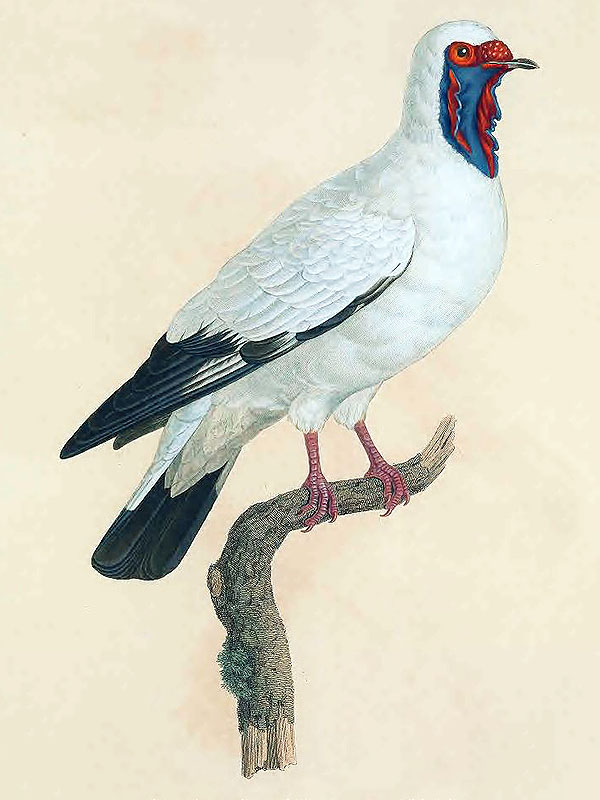
(public domain)
Nun, lesen wir (einen Teil) der Beschreibung.:
“Nous avons vu une variété entièrement blanche qui n’avoit du noir que sur la queue; d autres avoient le plumage plus ou moins marqué de taches grises et noires : ces derniers nous ont paru être de jeunes oiseaux. Les pieds sont constamment d’un beau rouge, et le bec est noir.
Nous présumons que l’Oricou habite les îles de la mer Pacifique, c’est du moins par des vaisseaux venant de ces parages que quelques individus ont été rapportés en Angleterre. Le Pigeon qui a servi de modèle à notre planche coloriée est déposé dans le cabinet de M. Raye de Breukelerwaert à Amsterdam. Cet amateur possède aussi la variété de cette espèce, dont les ailes sont entièrement blanches.” [1]
Übersetzung:
“Wir sahen eine völlig weiße Form, die nur am Schwanz schwarz war; andere hatten ein mehr oder weniger ausgeprägtes Gefieder mit grauen und schwarzen Flecken: Dies schienen uns junge Vögel zu sein. Die Füße sind durchgehend schön rot und der Schnabel ist schwarz.
Wir gehen davon aus, dass der Oricou auf den Inseln des Pazifischen Ozeans lebt, es wurden jedoch weniger Exemplare von Schiffen aus diesen Gebieten als in England gemeldet. Die Taube, die als Modell für unsere Farbtafel diente, befindet sich im Kabinett von Herrn Raye de Breukelerwaert in Amsterdam. Dieser Amateur hat auch eine Variante dieser Art, deren Flügel völlig weiß sind.“
Die Beschreibung basiert eindeutig auf einem ausgestopften Exemplar, und der erste und der letzte Satz sind besonders interessant … aus Gründen …
***
Der Vogel wird auch in einem anderen Werk erwähnt.:
“Note. – The Columba auricularis, Temm. Pig. t. 20,
…
is said to inhabit some of the islands of the Pacific Ocean; and others have more particularly given the Friendly Islands [Tonga] as the abode of this bird; but it is only an artificial production of some ingenious bird-preserver.” [2]
Übersetzung:
“Anmerkung. – Die Columba auricularis, Temm. Pig. t. 20,
…
soll einige der Inseln des Pazifischen Ozeans bewohnen; und andere haben insbesondere die Freundschaftsinseln [Tonga] als Wohnsitz dieses Vogels angegeben; aber es ist nur ein Kunstwerk eines genialen Präperators.“ [2]
Ah, da ist es: Das Colombe Oricou war offenbar eine der vielen erfundenen Tierarten, die in Museums- und Privatsammlungen auf der ganzen Welt aufbewahrt, von äußerst talentierten Präparatoren hergestellt und als äußerst seltene Exemplare zu höchsten Preisen verkauft wurden – eine Praxis die früher durchaus üblich war.
***
Bleibt nur noch die Frage: Um welche Vögel handelt es sich hier? Der Körper könnte der einer gewöhnlichen Wildtaube gewesen sein, und die nackten Teile könnten tatsächlich nur gerupft und nachträglich bemalt worden sein.
Das ist auch schon alles.
***
Ein kleines Update hierzu.:
Und … zum Beweis, dass es von dieser frei erfundenen Vogelarten tatsächlich mindestens ein Präparat gegeben hat ….:

https://www.naturalis.nl
https://creativecommons.org/licenses/by-sa/3.0/
*********************
Quellen:
[1] Pauline Knip: Les pigeons, par Madame Knip, née Pauline de Courcelles, le texte par C. J. Themminck. Paris: chez Mme. Knip 1838-1843
[2] George Robert Gray: Catalogue of the birds of the tropical islands of the Pacific Ocean in the collection of the British Museum. London: printed by order of the Trustees 1859
*********************
edited: 19.04.2024
A reed-warbler from Raivavae?
Hi there!
While reading some stuff in my ‘reed warbler book’ [3] last night, I suddenly remembered that there was a sighting or rather a ‘hearing’ of a reed-warbler on an island where no such reed-warbler was known to exist, and I was quite sure that this was one of the Cook Islands but could not find any mention of it.
But then i found it and it was one of the Austral Islands, namely Raivavae, where a reed warbler was recorded in 1968, and it was apparently indeed not seen but heard only, but it was at least identified as being a reed-warbler.
The island of Raivavae has no surviving endemic land bird species today, but of course did have some of them in the past, among them very, very, veeery likely also a reed-warbler species, and in my humble opinion this appears to have survived until the mid 20th century at least.
***
So, I’ve checked my ‘usual suspects’ and found some furter informations, but not really that much, unfortunately.
Te Manu: Bulletin de la Société d’Ornithologie de Polynésie. Nr 24. September 1998:
“Une espèce non identifiée d’Acrocephalus a été notée à Raivavae en 1968 mais n’a pas été retrouvé en 1990 (Seitre et Seitre 1991) et pouvait donc être un oiseau erratique.“
translation:
“An unidentified species of Acrocephalus was recorded at Raivavae in 1968 but was not found in 1990 (Seitre and Seitre 1991) and could therefore be an erratic bird.“
This record obviously is mentioned by D. T. Holyoak and J.-C. Thibault in 1984 [1] but I was not able to read it myself, however, I’m rather convinced that the ‘erratic bird’ more likely is meant to be what in German is called a “Irrgast”, a migratory bird that appeared on the island inadvertently while flying from one point to another.
But are there migratory reed warblers flying over the Austral Islands? No, because if they fly from north to south or back, they just do not cross the middle of the Pacific Ocean since the migratory reed-warbler species only inhabit the continents of the ‘Old World’ and those inhabiting the Polynesian islands do not migrate, as far as I know.
***
In chapter 7 of David W. Steadman’s ‘Extinction and Biogeography of Tropical Pacific birds’ from 2006 [2] it is mentioned as Acrocephalus vaughani and as a ‘M, modern record’ from Raivavae. How could I actually miss that until today?
****
I personally are rather sure that this single record from the island of Raivavae is indeed the last record of a former existing population of native, probably endemic, Raivavae Reed-Warblers which now join the ever-growing list of extinct taxa.
***
Here is a little update, in the meantime I was able to finde the original work by D. T. Holyoak and J.-C. Thibault from 1984.:
“A. v. sous-espèce ?
Raevavae: des fauvettes furent entendues par Lacan (J.-L. Mougin, comm. pers.) en mai 1968.” [1]
translation:
“A. v. subspecies?
Raevavae: warblers were heard by Lacan (J.-L. Mougin, pers. comm.) in May 1968.“
*********************
References:
[1] D. T. Holyoak; J.-C. Thibault: Contribution à l’étude des oiseaux de Polynésie orientale. Mémoires du Muséum national d’histoire naturelle 127(1): 1-209. 1984
[2] David W. Steadman: Extinction and Biogeography of Tropical Pacific Birds. University of Chicago Press 2006
[3] David Pearson; Peter Kennerly: Reed and Bush Warblers. Christopher Helm 2009
*********************
edited: 10.03.2020
Ospreys on the Tongan Islands – when did they disappear?
The Osprey (Pandion haliaetus (L.)) is a highly specialized bird of prey that is distributed almost around the whole world except for Antarctica, and it was once even more widespread and occurred as far east as western Polynesia.:
The Osprey still ocurs on New Caledonia, but not further east, however, it formerly did and it is known to have occurred on the Tongan Islands on the basis of subfossil bones of adult and juvenile birds that were found in several archaeological sites on the islands of Ha’ano and ‘Uiha in the Ha’apai Islands group in the middle of the Tongan Islands chain. [2]
***
“PANDION HALIAETUS (?).
Falco haliaetus, Forst. Descr.* &c. p. 257.
Isle of Pines (Island of Spruce Trees); Tonga Islands (Tongatabu or Tonga Island).” [1]
Is it possible that this Tongan form has survived into the early 19th century?
*********************
References:
[1] George Robert Gray: Catalogue of the birds of the tropical islands of the Pacific Ocean in the collection of the British Museum. London: printed by order of the Trustees 1859
[2] David W. Steadman: Extinction and Biogeography of Tropical Pacific Birds. University of Chicago Press 2006
*********************
edited: 10.03.2020
The enigmatic Washington Island Gadwall
“The most mysterious of all the Pacific waterfowl is Coues’ Gadwall, Anas strepera couesi, only two specimens of which have ever been found, on Washington Island, more than six hundred miles south of Hawaii. The two specimens, the male type and a female, collected in 1874, are now in the U.S. National Museum in Washington. In appearance these birds are simply Gadwalls reduced to about two-thirds normal size. The plumage too is rather dull and somewhat unfinished-looking. Washington Island is a marshy place only a few miles long, with a small brackich lake near the centre and a fringe of palms. Since he original pair of birds were discovered, several expeditions have stopped at the island, but no one has ever seen Coues’ Gadwall again. Speculation is perhaps unprofitable, but sometimes it is irresistible. I often like to wonder how these birds ever came to Washington Island. It is my guess, for what it is worth, that these two specimens represent the last of a very small inbred breeding population of true Gadwalls which by an accident of migration had become established on the island. I suspect that their size and coloration are due to environment and inbreeding rather than to any genetic change.“ [4]
This account summarizes quite well what’s known about this bird.
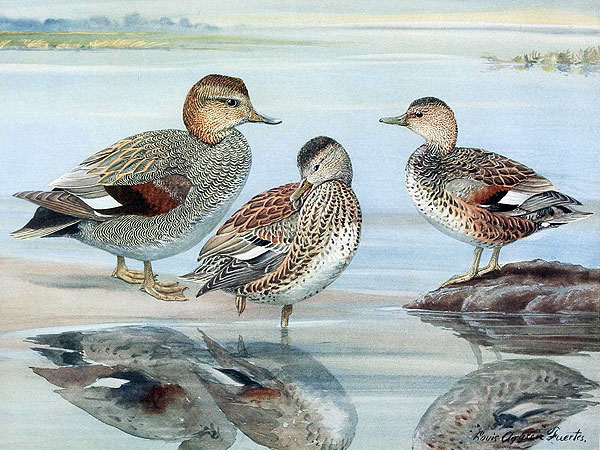
Depiction from: ‘John C. Phillips: A Natural History of the Ducks. Boston; Houghton Mifflin Company; 1922-1926’
(public domain)
***
Then there are some strange accounts, or rather misinterpretations of accounts, let’s start with one that is rather less known, and speaks of the occurence of a form of gadwall on the Society Islands.:
“Forster met with a species of Gadwall on the Society Islands and identified it with A. strepera Linn. It is much more likely that is was C. couesi, for the range of that species doubtless extends beyond Washington Island, the only locality as yet known for it.” [2]
I read this original account by J. R. Forster, which is completely in Latin, and which merely is a enumeration of species, the duck is mentioned here just as “Anatem streperam“, that’s all, and this account almost for sure refers to the Pacific Black Duck (Anas superciliosa Gmelin), which occurs on the Society Islands, and which is not separately mentioned here … and in fact, Forster mentiones “Anas strepera” again in an enumeration of birds he describes from New Zealand, this also clearly refers to the Pacific Black Duck! [1]
***
Then there’s another account in a German book, which again is refering to an account in James C. Greenway’S “Extinct and vanishing birds of the world” from the 1960s.:
“Interessant ist eine weitere Bemerkung desselben Autors, wonach nach Angaben von Ripley ein auf den Tuamotu-Inseln gefundenes Entenkücken sich bei Erreichen der Geschlechtsreife als Schnatterente herausstellte.”
translation:
“Interesting is another comment of the same author [J. C. Greenway], based on which according to Ripley a duckling found on the Tuamotu islands, when reaching maturity, turned out to be a gadwall.” [6]
***
Okay … after purchasing J. C. Greenway’s book, which took me ages again, I can now proudly present you this abovementioned account by the ominous Ripley.:
“But, on the other hand, Dr. S. Dillon Ripley tells me that a duckling taken on the Tuamotu Islands was raised by Charles Nordhoff at Tahiti. When it reached maturity it turned out to be a gadwall.” [5]
That’s all, we actually deal with hearsay, an account of an account of someone who claimes to have caught a duckling on one of the Tuamotu Islands (these are actually the largest island group in the world consisting of no less than 76 atolls, just by the way ….) without naming the island in question.
However, given the geographic position of Washington Island/Teraina, a former occurence of this bird on the Tuamotu Archipelago makes much more sense than on the Society Islands.
***
But now let’s take a look on what these two persons, Dr. S. Dillon Ripley and Charles Nordhoff, have to tell; we start with Mr. Ripley …:
“It sometimes happens that migrating Ducks plummet down on to isolated islands in the Pacific. Mr. Charles Nordhoff told me once that a schooner captain inbound to Tahiti from Flint island, an isolated rock pinnacle three hundred miles or more north towards Hawaii from the Society Islands, brought him a duckling which he had picked up on the island. Mr. Nordhoff was able to raise the bird, and found that it was a Pintail, presumably from wild parents. If Pintails can fly so far south of Hawaii where they are in the habit of wintering, there seems no reason why Gadwalls should not be able to do the same thing.” [4]
… and go on with Mr. Nordhoff.:
“In his article in the Waterfowl number of the AVICULTURAL MAGAZINE, Dillon Ripley mentions a duckling I received some years ago from Flint Island, which when reared proved to be a fine male Pintail. I believe that a good many stray Ducks from the Northern Hemisphere land on the Pacific Islands, and occasionally, as Ripley suggests in the case of Coues’ Gadwall, give rise to a sedentary and eventually inbred race. I have reliable information that Shovelers in winter plumage have vistited both the Marquesas and the Tuamotu on several occasions, and that Pintail have been seen on Atiu in the Cook Group, south-west of Tahiti.” [3]
Well, well, so the Tuamotu Islands suddenly has changed into Flint Island, which in fact is not a part of the Tuamotu Archipelago but of Kiribati – and – the duckling that was supposed to turn out being a Gadwall was in fact a Pintail (Anas acuta L.), a completely different species of duck!
After all, we are left with probably more questions than answers.
*********************
References:
[1] Johann Reinhold Forster; Hinrich Lichtenstein: Descriptiones animalium quae in itinere ad Maris Australis terras per annos 1772, 1773 et 1774 suscepto. Berolini: Ex Officina Academica 1844
[2] Lionel K. Wiglesworth: Aves polynesiae: a catalogue of the birds of the Polynesian subregion (not including the Sandwich Islands). Berlin: R. Friedlaender & Sohn 1891 In: Abhandlungen und Berichte des Königl. Zoologischen und Anthropologisch-Etnographischen Museums zu Dresden Bd. 3: 1-84. 1890/91. herausgegeben von Hofrath Dr. A. B. Meyer, Director des Museums
[3] Charles Nordhoff: Notes on the birds of Tahiti. The Avicultural Magazine ser. 5. 8(5): 119-120. 1943
[4] Dillon Ripley: Pacific Waterfowl. The Avicultural Magazine ser. 5. 8(3): 67-70. 1943
[5] James C. Greenway, Jr: Extinct and vanishing birds of the world. Dover Publications, 2nd Edition 1967
[6] Dieter Luther: Die ausgestorbenen Vögel der Welt. Westarp Wissenschaften 1986
*********************
edited: 28.02.2020
A Tahitian Swamphen?
While researching some accounts reffering to the Washington Island Gadwall (Mareca strepera ssp. couesi Streets), I stumbled accros a footnote that made me wonder … a bit at least.:
“The native birds of Tahiti are in a sad state; the Porphyrio is extinct, as is the small grey, Thrush-like Omaomao [Tahiti Reed-Warbler (Acrocephalus caffer (Sparrman))], famous for its beautiful song, and the magnificent large Fruit Pigeon [Polynesian Imperial-Pigeon (Ducula aurorae (Peale))], of which a few existed as late as 1920.” [1]
Well, aside the fact that the name “Omaomao” is rather applied to the Garrett’s Reed-Warbler (Acrocephalus musae ssp. garretti (Holyoak & Thibault)), the Tahiti Reed-Warbler is still alive.
What amazes me is that the author mentiones the term “Porphyrio” in a absolutely casual way, and this certain author, Charles Nordhoff, knew what a Porphyrio is, he kept six New Zealand Swamphens (Porphyrio melanotus (Temminck)) in the garden of his house while living on the island of Tahiti.
***
There is furthermore a painting by Paul Gaugin, made in 1897 during a stay on Tahiti, it is called “Vairumati” (see below) and shows a female islander sitting on a chair and to her left a strange-looking white bird that very much reminds on a swamphen.
I personally do not think that Gaugin painted a real bird here because the same bird appears in several of his paintings, always in the same pose, differing only in the coloration.
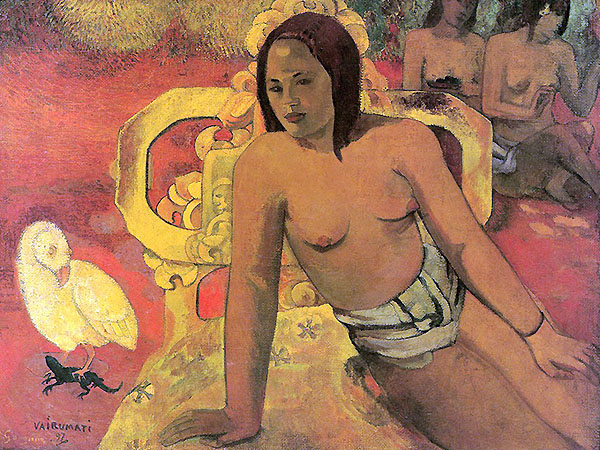
(public domain)
***
It nevertheless is almost certain that a swamphen species once inhabited the island of Tahiti, and that additional species inhabited all of the other Society islands, however, the only true evidence for that assumption are the subfossil remains of McNab’s Swamphen (Porphyrio mcnabi Kirchman & Steadman) found on the island of Huahine.
I only somehow doubt that this Tahiti Swamphen disappeared only around the 1940s … but, who knows.
*********************
References:
[1] Charles Nordhoff: Notes on the birds of Tahiti. The Avicultural Magazine ser. 5. 8(5): 119-120. 1943
*********************
edited: 27.02.2020
Duivenbodes Sechstrahliger Strahlenparadiesvogel
Duivenbodes Sechstrahliger Strahlenparadiesvogel (Parotia duivenbodei Rothschild)
Auf den ersten Blick sieht dieser Vogel wie ein typischer Strahlenparadiesvogel aus, der einen glänzenden Brustschild und längliche, fadenförmige Hinterhaupt’fähnchen’ trägt. Er hatte jedoch nur zwei von ihnen anstelle der üblichen sechs, so dass sein Trivialname eigentlich eher Duivenbodes zweistrahliger Strahlenparadiesvogel sein sollte.
Die Form ist anhand von zwei männlichen Exemplaren bekannt und wurde als Hybrid des Kragenparadiesvogel (Lophorina superba (J. R. Forst.)) und des Arfak-Strahlenparadiesvogel (Parotia sefilata (Pennant)) identifiziert.
*********************
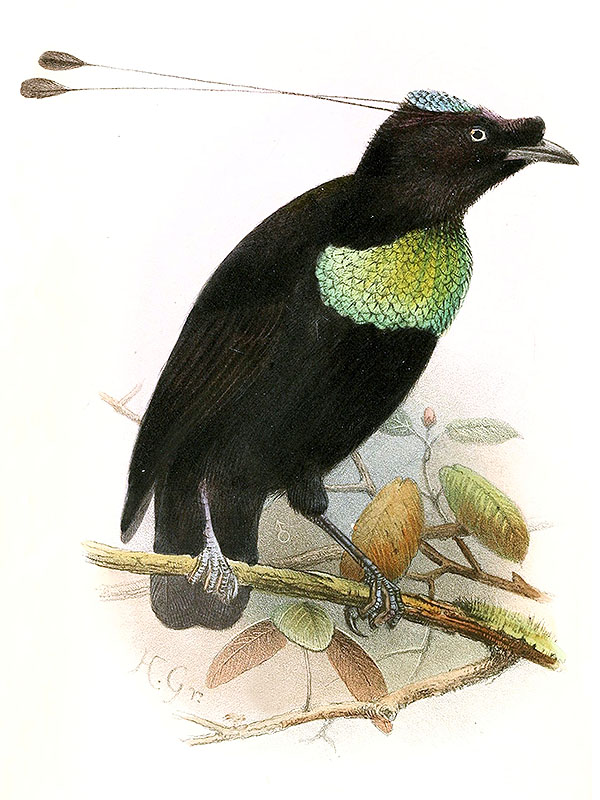
(not in copyright)
*********************
Quelle:
[1] Clifford B. Frith; Bruce M. Beehler: The Birds of Paradise: Paradisaeidae. Oxford University Press 1998
*********************
bearbeitet: 14.03.2021
Le Nébuleux
Le Nébuleux (Nebulöser Fadenhopf)
Dies könnte der erste Teil einer kleinen Serie sein ….
Le Nébuleux oder der Nebulöse ist nur anhand zweier Gemälde von Jacques Barraband in François Le Vaillants “Histoire naturelle des Oiseaux de Paradis et des Rolliers” aus dem Jahr 1806 bekannt, die sehr wahrscheinlich ein einzelnes Exemplar in zwei verschiedenen Positionen zeigen. Es ist bekannt, dass Jacques Barraband absolut genau war, daher muss der von ihm dargestellte Vogel existiert haben und tatsächlich exakt wie in seinen Darstellungen ausgesehen haben.
Das Exemplar ist ganz klar ein Fadenhopf (Seleucidis melanoleuca (Daudin)), jedoch mit nur neun (oder zehn?) Anstelle von zwölf ‘Fäden’ und mit einer schwarz- statt gelb gefärbten Unterseite; seine weibchenähnlich braun gefärbten Flügel weisen darauf hin, dass es sich um einen subadulten Vogel handelte. [2]
Der Nebulöse könnte derselbe gewesen sein wie Bruijns Reifelvogel (Craspedophora bruyni Büttikofer) alias Mantous Reifelvogel (Craspedophora mantoui Oustalet), welche beide Hybriden des Prachtparadiesvogels (Ptiloris magnificus Vieillot) und des Fadenhopfes sind. [2]
Diese Form wurde nie wissenschaftlich beschrieben und trägt daher auch keinen wissenschaftlichen Namen.
*********************
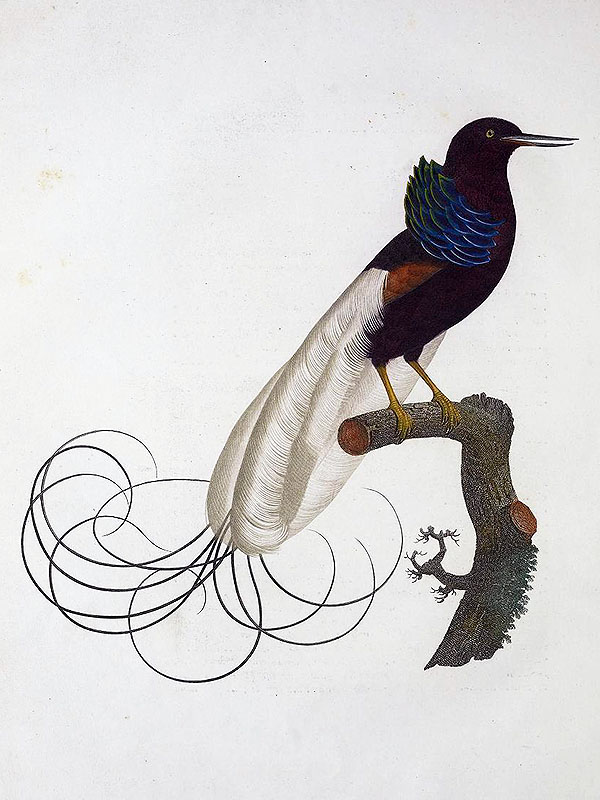
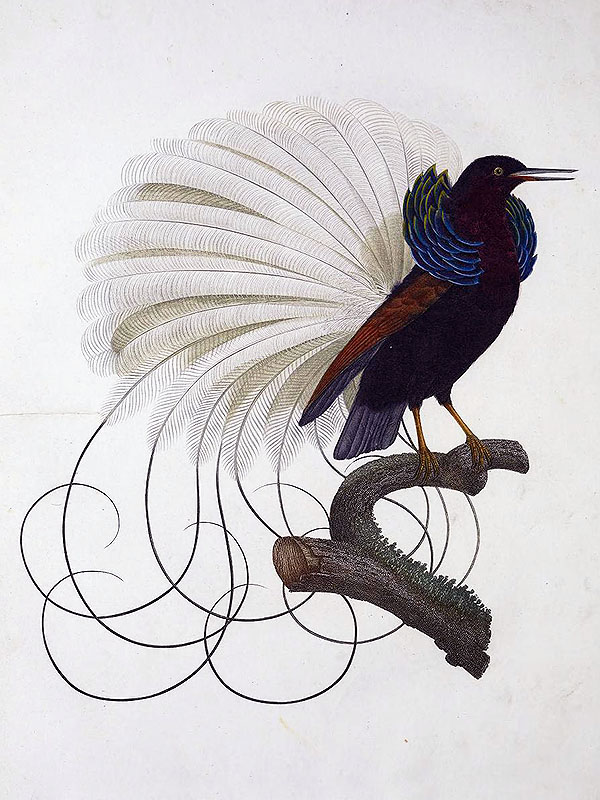
*********************
Quellen:
[1] François Le Vaillant: Histoire naturelle des oiseaux de paradis et des rolliers: suivie de celle des toucans et des barbus. Paris: Chez Denné le jeune, Libraire, rue Vivienne, n°. 10. & Perlet, Libraire, rue de Tournon 1806
[2] Clifford B. Frith; Bruce M. Beehler: The Birds of Paradise: Paradisaeidae. Oxford University Press 1998
*********************
bearbeitet: 14.03.2021
Adanson’s – and Latreille’s Bee-eaters
Here I want to write a bit about two enigmatic birds that allegedly both were collected in Africa at the beginning of the 19th century; these are Adanson’s Bee-eater and Latreille’s Bee-eater.
*********************

Depictions from: „François Le Vaillant: Histoire naturelle des promerops, et des guêpiers: faisant suite à celle des oiseaux de paradis par la même. A Paris, chez denné le jeune, Libraire, Rue Vivienne, N° 10. 1807“
(public domain)
Adanson’s Bee-eater is an enigmatic bird known only from a single specimen which is commonly thought to have been an artificially specimen, assembled from several bird parts, a practice that was rather common in these olden days when collectors were keen to have in their collections the most rare exhibition pieces.
The following French texts are all from François Le Vaillant, they describe this ’species‘ and give us some additional information about its wehereabouts. [1]
„Ce guêpier à queue en flèche ayant été méconnu par Buffon qui l’a, donné comme une simple variété de climat de son guêpier marron et bleu, ou de l’Isle-de-France, espèce que nous avons décrite dans notre précédent n°, sous la dénomination de guêpier Latreille, nous avons dû encore lui donner un nom distinctif, et nous ne pouvions à cet égard mieux faire, je pense, que de choisir celui du célebre voyageur qui l’ayant rapporté du Sénégal, l’a le premier fait connoître en Europe. Il suffira, je pense, de comparer les figures exactes que nous avons publiées de ces deux oiseaux, pour être d’abord et du premier coup-d’œil convaincu de la méprise de Buffon à leur égard, et être persuadé enfin qu’ils forment deux espèces très distinctes, bien loin de n’être l’un qu’une variété de l’autre; on ne conçoit même pas, en voyant les figures qui représentent dans les planches enluminées de Buffon ces deux oiseaux, l’un sous le nom de guêpier de l’Isle-de-France, n° 252, et l’autre, n° 314, sous celui de guêpier à longue queue du Sénégal, comment il a été possible de commettre cette erreur, et encore moins qu’elle ait été perpétuée par tous les ornithologistes qui ont écrit sur les oiseaux depuis Buffon. On conçoit en effet d’autant moins cette méprise, que ces deux figures, d’ailleurs très mauvaises , different bien plus l’une de l’autre encore, que ne différent réellement ces deux oiseaux eux-mêmes entre eux, mais assez cependant pour être bien sûr qu’ils ne peuvent être confondus ensemble comme appartenant à une seule et même espèce.„
translation:
„This spiny-tailed bee-eater was ignored by Buffon who gave it as a simple climate variety of its brown and blue bee-eater, or Isle-de-France [bee-eater], a species that we described in our previous issue. Under the denomination of Latreille, we have had to give it a distinctive name, and we could not, in this respect, have done better, I suppose, than the guide of the traveler who brought it back from Senegal, the first to make it known in Europe. It will suffice, I think, to compare the exact figures which we have published of these two birds, to be first and for the first glance convinced of Buffon’s mistake with regard to them, and to be finally persuaded that they form two very distinct species, far from being one variety of the other; it is not even conceivable, seeing the figures which represent, in the bright plates of Buffon, these two birds, one under the name of the Isle-de-France bee-eater, No. 252, and the other, No. 314, under that of long-tailed bee-eater from Senegal, how it was possible to make this mistake, let alone that it has been perpetuated by all the ornithologists who have written about birds since Buffon. This misunderstanding is all the less so conceived, that these two figures, which are, moreover, very bad, differ much more from one another than the two birds themselves really differ from one another, but enough, however, to be sure that they can not be confused as belonging to one and the same species.„
So, in short, these two birds were originally thought to be specifically identical, what they of course are not.
***
„Le guêpier Adanson est d’un tiers au moins plus fort que le guêpier Latreille, ainsi qu’on peut le voir d’ailleurs, en comparant les portraits de grandeur naturelle que nous en avons donné: il a le front ceint d’un large bandeau bleu qui, se prolongeant au-dessus des yeux, couvre les joues, les côtés et tout le devant du cou, la poitrine, et enfin tout le dessous du corps, en y comprenant les couvertures siqjéricures et inférieures de la queue, et le croupion; mais ce bleu s’affoiblit toujours davantage à mesure qu’il approche du bas-ventre; le dessus de la tête, à partir du bleu du front, ainsi que le derrière du cou, le manteau, les scapulaires, toutes les couvertures des ailes, et même les pennes de ces dernières, ainsi que toutes celles de la queue, sont couleur marron; seulement la partie excédante des deux pennes prolongées de la queue, ainsi que le bout des premières pennes des ailes, sont noirâtres; et les dernières plumes des ailes, proche le dos, sont en partie du même bleu que celui du dessous du corps; le bec est noir; les pieds sont bruns rougeàtres. Nous ignorons la couleur des yeux, n’ayant vu que la dépouille de cet oiseau, que je n’ai rencontré dans aucune des parties de l’Afrique dans laquelle j’ai pénétré; je n’ai même vu de cette espèce que le seul individu qu’en avoit rapporté Adanson du Sénégal, où il l’avoit recueilli durant ses voyages.„
translation:
„The Adanson bee-eater is at least a third stronger than the Latreille bee-eater, as can be seen elsewhere, by comparing the life-size portraits we have given: it has at its forehead a blue band which, extending above the eyes, covers the cheeks, the sides and all the front of the neck, the chest, and finally the whole underbody, including the undertail coverts of the tail, and the rump; but this blue becomes more and more feeble as it approaches the lower abdomen; the top of the head, from the blue of the forehead, as well as the back of the neck, the mantle, the scapulars, all the coverts of the wings, and even the feathers of these, as well as those of the tail, are colored brown; only the exceeding part of the two elongated feathers of the tail, as well as the end of the first primaries of the wings, are blackish; and the last feathers of the wings, near the back, are partly of the same blue as that of the underbody; the bill is black; the feet are reddish brown. We are ignorant of the color of the eyes, having seen only the remains of this bird, which I have not met in any part of Africa into which I have penetrated; I have not even seen of this species the only individual who had been brought back from Adanson of Senegal, where he had collected it during his travels.„
The author clearly states here that he did only see remains of this bird, but also that he did not see it at all, that is somewhat irritating to me.
But what was Adanson’s Bee-eater actually?
Well, the bird’s upper side looks almost exactly like that of the Southern Carmine Bee-eater (Merops nubicoides Des Mus & Pucheran) or the Northern Carmine Bee-eater (Merops nubicus Gmelin), the underside and forepart of the hea, however, come from another bird that, since the original specimen is now lost, will forever be unidentifiable.
*********************

Depictions from: „François Le Vaillant: Histoire naturelle des promerops, et des guêpiers: faisant suite à celle des oiseaux de paradis par la même. A Paris, chez denné le jeune, Libraire, Rue Vivienne, N° 10. 1807“
(public domain)
Latreille’s Bee-eater, of which I won’t give any text because it isn’t really necessary, is said in its description to come from the Isle-de-France, known today as Mauritius but being far more widespread all over Africa. This ’species‘ might actually have been a Rufous-crowned Bee-eater (Merops americanus Statius Müller) or a Blue-throated Bee-eater (Merops viridis L.), both exclusively from Asia by the way. Again, the colors won’t fit completely, so again some parts of other birds might have been added to the depicted specimen. That was apparently a quite common practice in former times, the more rare and unique a specimen was the higher was its price ….
My personal conclusion is that both these ’species‘ never have existed.
*********************
References:
[1] François Le Vaillant: Histoire naturelle des promerops, et des guêpiers: faisant suite à celle des oiseaux de paradis par la même. A Paris, chez denné le jeune, Libraire, Rue Vivienne, N° 10. 1807
*********************
edited: 05.11.2019
Micronesia – (not so) hypothetical species mentioned in accounts
Oh well, I did some research, and actually still do … here are the results I got so far.:
The first account dates from November 30th, 1895 and is given by a Dr. Georg Irmer, who was the Imperial German Government District Administrator in the Marshall Islands, which were a German overseas colony back then.
In his account he gives a bit information of some birds he saw when he inspected the Taongi Atoll (now Bokok) to collect guano samples for analysis and to reaffirm the German claim to the island, he mentions seabirds and a large ground-dwelling bird which he named a ‘Trappe‘, the German term for a bustard. He gives no further description or whatsoever, but it is thought that he might not have seen any of the birds commonly known from the Marshall Islands because neither he nor his Marshallese crew were able to identify that bird.
Given his name for the bird, ‘Trappe‘, it is quite likely that he indeed saw a rail of the genus Gallirallus, very much like the one that once inhabited the Wake Atoll to the north of the Marshall Islands. [4]
***
The second account comes from the natives of the Marshall Islands and was forwarded by them to the German ‘anthropologists’ who explored these islands at the beginning of the 20th century.
It is a bird named as the anang-, annan-, or annang. This is said to have been a very small bird (the size of a butterfly (!)), and to have possessed a pleasant smell, it is said to have lived among the rocks around the shores of the northern Marshall Islands. The bird is known from oral traditions at least from the Jaluit-, and the Wotho Atoll, and it is always said to have been a ground-dwelling singing bird.
This may in fact be a description of a Turnstone (Arenaria interpres (L.)), a species that winters in Micronesia and that was very much appreciated, for example by the inhabitants of Nauru, who cought them not to eat them but to tame them and keep them as pets.
Or it is the description of a small crake or a reed-warbler, mixed with some phantastic components. [4]
***
The third account comes from Paul Hambruch, a German ethnologist that researched the life of the natives of the island of Nauru, his accounts are merely stories that were told him by a native named Auuiyeda, and which he translated into German.
Let’s read them.:
“Es gibt auch Vögel auf Nauru, wie Fregattvogel, schwarze Seeschwalbe, weiße Seeschwalbe, Regenpfeifer, Brachvogel, Möve, Schnepfe, Uferläufer, Ralle, Lachmöve und Rohrdrossel.” [1]
translation:
“There are also birds on Nauru, as frigate bird, black tern, white tern, plover, curlew, gull, snipe, sandpiper, rail, black-headed gull and reed thrush.“
And he goes on.:
“Die Vogelwelt ist nach Zahl und Art reicher. Der Fregattvogel (Tachypetes aquila), itsi, die schwarze Seeschwalbe (Anous), doror, die weiße Seeschwalbe (Gygis), dagiagia, werden als Haustiere gehalten; der erste galt früher als heiliger Vogel, mit den beiden anderen werden Kampfspiele veranstaltet. Am Strande trifft man den Steinwälzer (Strepsilas interpres), dagiduba, den Regenpfeifer (Numenius), den Uferläufer (Tringoides), ibibito, die Schnepfe, ikirer, den Brachvogel ikiuoi, den Strandreiter iuji, die Ralle, earero bauo und zwei Möwenarten (Sterna), igogora und ederakui.
Im Busche beobachtet man an den Blüten der Kokospalme den kleinen Honigsauger raigide, die Rohrdrossel (Calamoherpe syrinx), itirir und den Fliegenschnäpper (Rhipidura), temarubi.” [1]
translation:
“The bird world is richer by number and species, The frigate bird (Tachypetes aquila), itsi, the black tern (Anous), doror, the white tern (Gygis), dagiagia, are kept as pets; the first one was formerly considered a holy bird, with the two others are used for fighting games. At the beach one mets with the turnstone (Strepsilas interpres), dagiduba, the plover (Numenius), the sandpiper (Tringoides), ibibito, the snipe, ikirer, the curlew, ikiuoi, the beach rider [?] iuji, the rail, earero bauo and two gull species (Sterna), igogora and ederakui.
In the bush one observes on the flowers of the coconut palm the small honeyeater raigide, the reed thrush (Calamoherpe syrinx), itirir and the flycatcher (Rhipidura), temarubi.“
The author is usually thought to have misinterpreted the things he was told by Auuiyeda, but I personally doubt that somehow, all the mentioned landbirds make in fact sence for georaphical reasons, so, why not?
Nauru is now almost deserted, the whole island looks like a building site – and it actually is one! There are some sad rests of the forest that once covered the whole island, and indeed some landbirds still manage to survive in small numbers, one of them, the Nauru Reed-Warbler (Acrocephalus rehsei (Finsch)) is even an endemic species, there’s no reason not to accept the former presense of a fantail, a honeyeater, and especially a rail, no reason at all!
These birds, especially the rail, may already have been extirpated by the beginning of the 20th century, leaving only memories and storys told by the islanders.
***
And last but not least, here the fourth account of birds from the Namoluk Atoll, Chuuk, that were enumerated by Max Girschner, another German who had lived in Micronesia at the beginning of the 20th century, he was a colonial offical, a doctor, and an ethnologist.
I have no access to his accounts, but I can give you quotations of them by Mac Marshall from 1971, here they are.:
“Ponape Lory (no Namoluk name)
Trichoglossus rubiginosus
Extinct breeder.
According to Girschner (1912:126), this species was blown to Namoluk in a typhoon in 1905, and apparently it still occurred on the atoll at the time of his visit. there are no lories at present on Namoluk nor can anyone alive on the atoll in 1971 remember seeing them.” [2]
According to Donald W. Buden this whole information is unlikely, and if these parrots have ever occurred on the Namoluk Atoll at all, they must have been brought there by people. [3]
I personally think … why not, typhoons may indeed blow parrots from one island to another, or how did the loris themselves came to end up on the island of Pohnpei in the first place?
But wait, there’s more.:
“A second bird mentioned by Girschner that no longer is found on Namoluk is “a small black and white bird” for which he gives the name lipukepuk.” [2]
The author states that this can only be the description of a New Hanover Mannikin (Lonchura (hunsteini ssp.) nigerrima (Rothschild & E. J. O. Hartert)), which does not occur anywhere in Micronesia and which is not black and white by the way. The bird he is actually referring to is Hunstein’s Mannikin (Lonchura hunsteini ssp. minor (Yamashina)), which again is very well occuring in Micronesia, at least on the island of Pohnpei (yes, again), and which is at least blackish and greyish ….
To me the whole account sounds very much like a nice description of the Truk Monarch (Monarcha rugensis (Hombron & Jacquinot)), and given the fact that most island-dwelling birds in Micronesia also occur on nearby atolls it is quite possible that there once was a native population of this bird here as well.
But we will probably never know for sure.
***
The most interesting things that I found out so far are.:
1: Micronesian bird names are odd (to my ears and eyes), I mean the Palau Ground Dove (Pampusana canifrons (Hartlaub & Finsch)) for example is named omekrengukl, I do not even know how to pronounce that. 🙂
2: Micronesia harbors only 148 native breeding bird species (including the extinct ones!).
3: The Micronesian landbirds do not only occur on the higher islands but also on the atolls, even on those atolls that are quite far away from the next high islands, a situation that is completely different from Polynesia, where the high islands almost entirely harbor a different avifauna than the atolls.
There may have been more species once, especially when we fill some of the illogical gaps between the islands and island groups.
*********************
References:
[1] Paul Hambruch: Nauru. Ergebnisse der Südsee-Expedition 1908-1910. II. Ethnographie: B. Mikronesien, Band 1.1 Halbband. Hamburg, Friedrichsen 1914
[2] Mac Marshall: The natural history of namoluk Atoll, eastern Caroline Islands. Atoll Research Bulletin 189: 1-53. 1975
[3] Donald W. Buden: The birds of Satawan Atoll and the Mortlock Islands, Chuuk, including the first record of Tree Martin Hirundo nigricans in Micronesia. Bulletin on the British Ornithologists’ Club 126(2): 137-152. 2006
[4] Dirk H. R. Spennemann: Extinctions and extirpations in Marshall Islands avifauna since European contact – a review of historic evidence. Micronesia 38(2): 253-266. 2006
*********************
edited: 04.01.2024
The genus Pareudiastes – some thoughts about the Puna’e and its mysterious congeners
The genus Pareudiastes consists of two species that both are known from historical times, meaning ‘having been seen’ by western scientists. We can probably add at least two undescribed extinct forms that are known exclusively from scanty subfossil remains, one from Fiji and one from the Solomon Islands.
The two species of which at least skins remain are very little known, the puna’e (Pareudiastes pacificus Kubary, Hartlaub & Finsch) from Samoa is in fact the best known of them.
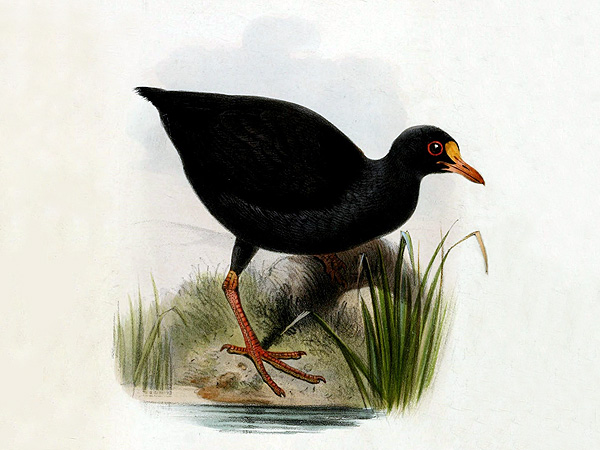
Depiction from: G. Hartlaub; O. Finsch: On a collection of birds from Savai and Rarotonga Islands in the Pacific. Proceedings of the Zoological Society of London 1871: 21-32
(public domain)
***
The puna’e, whose name roughly translates as “springs up“, is known to have inhabited the rainforests of Savai’i, Samoa; it is said by the natives to have lived in burrows, which were longer than a man’s arm and which ended in a sort of chamber in which the bird slept during the day.
The large eyes of the species indeed point to a somewhat nocturnal habit.
When the bird was disturbed it jumped up from its burrow with fluttering wings but being flightless it landed shortly after and run away quickly.
It is furthermore known that it was not a vegetarian species, since it died when it was fed with plant material but was “happy” when fed with insects.
***
There is at least one reliable account that indicates that this species also inhabited the neighboring island of ‘Upolu.:
“The Samoans always speak of the Pareudiastes as the ‘bird which burrows like a rat.’ Again and again when I have put the question to a native, ‘Do you know the Puna’ e?’ the reply has been, ‘No, I have never seen it; but that is the bird of which the old people speak that it used to be very plentiful long ago, and that it burrows like a rat and lives underground.’ It is very rarely that I have met with any one who has seen the bird; but I have met with two persons who have actually taken it in its burrow. The first is a man well known to me, and in whose veracity I have faith. He says that about four years ago [ca. 1870] he was one of a large party hunting feral pigs in the mountains of Upolu, when they came upon a burrow which one of the party pronounced to be the hole of a Puna’e. My informant says that he put his arm into the hole, and at its extremity (which he could barely reach) he found the bird. He drew it out, and, taking it home, tried to tame and feed it; but it would not eat, and soon died.” [1]
Yet, how is this possible? The islands of Savai’i and ‘Upolu are separated by the 13 km wide Apolima strait.

Photo: Teineisavaii; Image Science and Analysis Laboratory, NASA-Johnson Space Center. “The Gateway to Astronaut Photography of Earth.”
(public domain)
***
During the Pleistocene, the sea level was lower and Manono very likely was connected with ‘Upolu, but Apolima was not, and Savai’i and ‘Upolu also weren’t connected.
So, how did a flightless bird manage to get from one island to the other?
The answer might be that the Puna’e wasn’t flightless at the time when the sea level was lower, or that the birds from ‘Upolu represented a distinct (sub)species.
***
What do we know about the second historical known species, the Makira Woodhen (Pareudiastes silvestris (Mayr))?
This species is known from a single specimen that was taken in 1929 on the island of Makira, Solomon Islands in montane forest at an elevation of about 600 m, only its skin was preserved, the bones not, and it apparently was flightless or at least nearly so.
The natives called it kia and hunted it with dogs.
That’s all.
The species was apparently still ‘well-known’ by the natives in 1953, and they also said that it was not rare, nevertheless not a single one was ever seen since (by western scientists).
The Makira Woodhen, or Kia, however, is the sole member of this genus that may in fact still survive, and I personally hope that it might be rediscovered someday.
***
The two additional forms are, as I’ve said before, known only from some scanty subfossil remains found on the island of Buka in the northernmost part of the Solomon Islands as well as on Viti Levu, the largest of the Fijian Islands respectively.
***
The genus Pareudistaes should be merged with the genus Gallinula, by the way.
*********************
References:
[1] Letter from Rev. S. J. Whitmee. In: Proceedings of the Zoological Society of London 1874: 183-186
*********************
edited: 04.07.2023
Levaillant’s Sicrin de l’Imprimerie de Langlois
Levaillant’s Sicrin de l’Imprimerie de Langlois, apparently meaning ‘Sicrin from the print of Langlois’ (?) is a strange bird drawn by Johann Friedrich Leberecht Reinhold that I discovered while flicking through the volumes of François Le Vaillant’s ‘Histoire naturelle des oiseaux d’Afrique’ from 1799.
Here it is.:
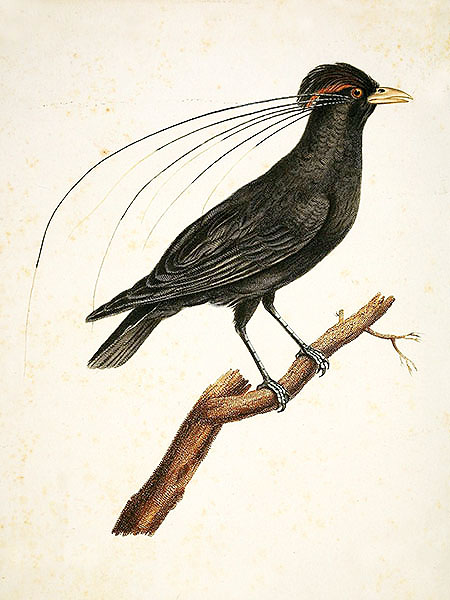
Depiction from: ‘François Le Vaillant: Histoire naturelle des oiseaux d’Afrique. A Paris: Chez J. J. Fuchs, Libraire, Rue des Mathurins, Hótel de Cluny. Vol. 2. 1799’
(not in copyright)
I must confess, first I had absolutely no idea what this astonishing bird is supposed to have been, it looks like some corvid bird, or a starling, possibly one of the strange starling species from the Philippine Islands, but what about the six porcupine spines in its face?
The bird is said to have been found at the Cape of Good Hope, South Africa, what I very much doubt it has, Monsieur Le Vaillant furthermore places it amongst the Jackdaws.
But let’s now just see what else Monsieur Le Vaillant has to tell us about this bird.:
„Le Sicrin est une espèce absolument nouvelle, et dont aucun naturaliste n’a fait mention encore; je fai placé parmi les choucas, parce que ce sont les oiseaux desquels je trouve qu’il se rapproche le plus, pour les formes de son bec, de ses pieds et de son corps. Au reste, si par la suite quelque voyageur nous apprend ses moeurs, que nous ignorons totalement, on lui donnera une autre place, si on juge qu’elle lui convienne mieux. Quant à moi, je le crois un vrai choucas, et cela pour l’avoir comparé attentivement avec tous les oiseaux de ce genre; je trouve même qu’il ressemble tellement au choquart ou choucas des Alpes, que si on lui retranchoit les six crins et la huppe qui le caractérisent si bien, on en feroit absolument le même oiseau; il est aussi de la même taille, mais il m’a paru un peu plus gros de la poitrine: il est vrai que, n’ayant vu cet oiseau qu’empaillé, il pourroit se faire qu’il ne dut sa rotondité quà une plus grande extension de la peau; cependant elle ne ma pas paru excessivement bourrée, puisque la peau n’étoit pas très-tendue. Le bec est absolument semblable aussi à celui du choquart, sinon qu’il est un peu plus pointu et plus épais à sa base. La queue est de même carrément coupée par le bout c’est-à-dire, que toutes ses pennes sont aussi longues les unes que les autres. Les aîles pliées s’étendent aux deux tiers de la longueur de la queue, qui a dix pennes.“ [2]
translation:
“The Sicrin is an absolutely new species, and of which no naturalist has yet reported; I did place them among the jackdaws, because they are the birds to which I find it comes closest, for the shapes of its beak, feet and body. For the rest, if afterwards some traveler informs us of more, which we are totally unaware of, we will give it another place, if we judge that it suits it better. As for me, I believe it to be a real jackdaw [M. Le Vaillant apparently was not that good in taxonomy ….], and that for having compared it attentively with all the birds of this kind; I even think that it resembles so much the cough or jackdaw of the Alps, that if we cut off the six horsehair [… actually real horse hair stucked into the bird?] and the crest that characterize it so well, we would make absolutely the same bird; it is also of the same size, but it seemed to me a little bigger of the breast: it is true that, having seen this bird only tempered [?], it could be done that it had its rotundity only to a greater extension of the skin; however it did not seem to me excessively drunk, since the skin was not very tense. The bill is absolutely similar to that of the cough, except that it is a little more pointed and thicker at its base. The tail is likewise cut off by the end, that is to say, that all its feathers are of equal length. The folded wings extend to two-thirds of the length of the tail, which has ten feathers.”
and
„Cet oiseau est remarquable par les crins ou longues plumes sans barbes qui ornent les côtés de sa tête, (à peu près comme dans l’espèce d’oiseaux de paradis que Buffon a nommée le sifilet), et par une belle huppe flottante qui, se couchant en arrière, ombragela tête. Les pieds sont conformés comme ceux du choquart; le bec est d’un jaune de citron, et prend une teinte d’orange sur son arête supérieure et vers les narines; celles-ci sont couvertes de poils ou plumes déliées, qui se dirigent en avant comme chez tous les oiseaux du genre des corbeaux. Les pieds et les ongles sont noirs.“ [2]
translation:
„This bird is remarkable for the hair or long feathers without barbs, which decorate the sides of its head (almost as in the species of bird of paradise that Buffon named the Sifilet [Western Parotia (Parotia sefilata (J. R. Forster))], and by a beautiful floating crest which, lying backward, shades its head. The feet are shaped like those of the cough; the beak is lemon yellow, and has an orange hue on its upper ridge and towards the nostrils; these are covered with loose hairs and feathers, which go forward as in all the birds of the crow kind. The feet and nails are black.“
and
„Il est plus que probable que ces oiseaux ont la faculté de redresser ces filets, et par conséquent de les resserrer contre le corps dans l’action du vol, dont ils gêneroient les mouvemens s’ils balotoient au gré des vents: je présume du moins cette faculté, d’après la longueur du tuyau qui s’implantoit dans la peau, et qui étoit trop grand pour ne pas faire soupçonner qu’il devoit pénétrer dans un muscle extenseur, propre à le faire mouvoir au gré de l’oiseau: ce qui me le donnoit encore à penser, c’est que dans la partie de la joue où ils entroient, toute la peau étoit plus épaisse et plus dure que par-tout ailleurs, et qu’on y remarquent très-distinctement une cavité profonde oùse logeoit le tuyau du filet que j’avois arraché, comme on le voit sur la métacarpe et le croupion de tous les oiseaux, quand on leur détache une penne soit de l’aîle ou de la queue. Je ne hasarderai point de désigner l’usage dont ces barbes peuvent être à cet oiseau, ni quel but s’est proposé la nature dans cette singulière production, que je regarde, au reste, comme un simple ornement. Combien de fois nos philosophes ne se sontils pas trompés et n’ont-ils pas égaré les autres hommes, lorsqu’ils ont voulu donner raison des causes que la nature avoit sans doute destinées à rester cachées aux foibles humains, d’un côté trop au-dessous de sa puissance pour les concevoir, et d’un autre trop audacieux peut-être pour être initiés, sans danger, dans ses mystères! O nature! il y a longtems, hélas! que les aveugles mortels auroient détruit ton ouvrage, et troublé cette belle harmonie de l’univers s’ils avoient pu te suivre dans ta marche et te deviner un seul instant!“ [2]
translation:
„It is more than probable hat these birds have the faculty of straightening these filaments, and consequently of tightening them against the body in the action of the flight, of which they disturb the movements if they struggle with the winds: I presume at least this faculty, according to the length of the pipe which was implanted in the skin, and which was too large not to make us suspect it had to penetrade into an extensor muscle, capable of causing it to move at the whim of the bird: what gave me still to think is, that in the part of the cheek they entered, the whole skin was thicker and more lasting than anywhere else, and we remark very distingly a deep cavitiy where the tube of the net which I had thorn off, as one sees on the metacarpus and the rump of all the birds, when one detaches a quill either of the ellbow or the tail. I will not venture to designate the use of which these beards can to be to this bird, nor what goal has nature proposed itself in this singular production, which I regard, moreover, as a simple ornament. How many times have our philosophers become unaccustomed to themselves, and have they not treated other men when they wished to give reason to the causes which nature had doubtless intended to remain hidden from the eak human beings, on the one hand too much below its power to to conceive them, and another too audacious perhaps to be initiated, without danger, into his mysteries! O nature! Long ago alas! That the blind mortals would have destroyed your work, and disturbed this beautiful harmony of the universe if they could have followed you in your march and guess you one moment!“ [what the ***, was he drunk here?]
By the way I could not find out what ‚Sicrin‘ is supposed to mean.
For about one day I was quite sure that this bird is nothing but a made-up piece, probably a Parotia species, for example the Western Parotia (Parotia sefilata (J. R. Forster)), with the glossy breast-shield feathers and the spatulate vanes of the six ornamental feathers below the eyes having been removed – even before translating and reading all the stuff above.
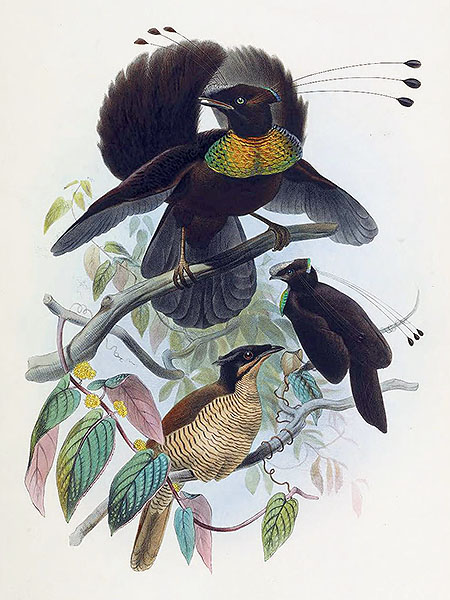
Depiction from: ‘Daniel Giraud Elliot: A monograph of the Paradiseidae or birds of paradise. London: printed for the subscibers, by the author 1873’
(public domain)
Well, well, but reading the original ‚description‘ including another, much older depiction, I am quite convinced that this mysterious bird is something completely different ….
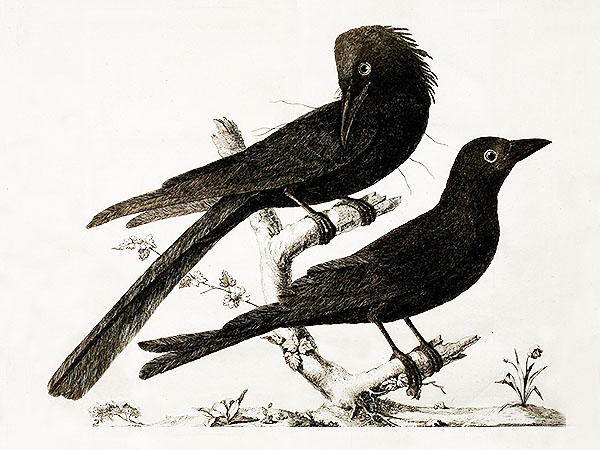
Depiction from: ‘Mathurin-Jacques Brisson: Ornithologie, ou, Méthode contenant la division des oiseaux en ordres, sections, genres, especes & leurs variétés: a laquelle on a joint une description exacte de chaque espece, avec les citations des auteurs qui en ont traité, les noms quils leur ont donnés, ceux que leur ont donnés les différentes nations, & les noms vulgaires. Vol 2. Parisiis: Ad Ripam Augustinorum, Apud Cl. Joannem-Baptistam Bauche, Bibliopolam, ad Insigne S. Genovesae, & S. Joannis in Deserto 1760’
(public domain)
a section of the original ‘description’:
“Il est à peu près de la grosseur du précédent. Sa longueur depuis le bout du bec jusqu’à celui de la queue est d’onze pouces quatre lignes, & jusqu’à celui des ongles de huit pouces dix lignes. Son bec depuis sa pointe jusqu’aux coins de la bouche a un pouce six lignes de long; sa queue cinq pouces; son pied douze lignes; & celui du milieu des trois doigts antérieurs, joint avec l’ongle, douze lignes & demie: les latéraux sont un peu plus courts; & celui de derriere est presque aussi long que celui du milieu de ceux de devant. Il a un pied sept pouces trois lignes de vol, & ses aíles, lorsqu’elles sont pliées, s’étendent jusqu’à la moitié de la longueur de la queue. La tête, la gorge & le col sont couverts de plumes d’un noir-verd très – brillant, celles de la partie supérieure du col font très – étroites & beaucoup plus longues que les autres. Elles glissent sur le dos sélon les différens mouvemens de la tête & du col. Les plumes qui retombent sur les narines sont d’un noir de velour. Audessus de ces plumes partent de l’origine du demi-bec supérieur quelques poils noirs, longs de trois pouces & très-fléxibles: & au-dessous tout le long de la bâse du bec, jusque vers les coins de la bouche, sont d’autres poils noirs, beaucoup plus courts & roides comme des soyes. Le dos, le croupion, la poitrine, le ventre, les côtés, les jambes & les couvertures du dessus & du dessous de la queue sont d’un noir de velours changeant en verd brillant. Celles du dessus & du dessous des aîles sont d’un noir-verd éclatant & changeant en violet. Les plumes des aíles sont de la même couleur endessus du côté extérieur feulement, & noires du côté intérieur; & en-dessous elles sont noirâtres. La première des plumes de l’aíle est plus courte de deux pouces sept lignes que la quatrième & la cinquième, qui sont les plus longues de toutes. Les plumes de la queue, qui sont toutes d’égale longueur, sont d’un noir-verd en-dessus & tout-à-fait noirâtres en-dessous. Le bec, les pieds & les ongles sont noirs. On le trouve au Cap de Bonne Esperance, d’où il a été apporté à M. l’Abbé Aubry, qui le conserve dans son cabinet.“
translation:
“He is about the size of the preceding. Its length from the tip of the beak to that of the tail is eleven inches four lines, & up to that of the nails eight inches ten lines. Its beak from its point to the corners of the mouth is one inch six lines long; his tail five inches; his foot twelve lines; & that of the middle of the three anterior toes, joined with the nail, twelve lines & a half: the lateral ones are a little shorter; & the one behind is almost as long as the one in the middle of the front ones. He has one foot seven inches three flight lines, & his wings, when folded, extend to half the length of the tail. The head, the throat, & the neck are covered with feathers of very brilliant black-green, those of the upper part of the neck are very narrow & much longer than the others. They slide on their backs, according to the different motions of the head & the collar. The feathers that fall on the nostrils are of a black velvet.Above these feathers, from the origin of the upper half-beak, are a few black hairs, three inches long & very flexible; & below all the length of the bill-body, as far as the corners of the mouth, are other black hairs, much shorter & stiff like sores. The back, rump, chest, belly, sides, legs & covers of the top & bottom of the tail are velvet black, shiny green. Those on the top and bottom of the elbows are of a shiny black-green & changing into violet. The feathers of the birds are of the same color, on the outer side, & black on the inner side; & below, they are blackish. The first of the feathers of the ale is shorter by two inches seven lines than the fourth & the fifth, which are the longest of all. The feathers of the tail, which are all of equal length, are of a black-green above & quite blackish below. The beak, the feet & the nails are black. It is found at the Cape of Good Hope from where it was brought to the Abbé Aubry, who keeps it in his cabinet.” [1]
… a Hair-crested Drongo (Dicrurus hottentottus ssp. hottentottus (L.)) originally described in 1766, also as being from the Cape of Good Hope, South Africa, by the way.

Photo: Stanzinnamgail
(under creative commons license (4.0))
http://creativecommons.org/licenses/by-nc/4.0
This bird actually comes from Southeast Asia, where it has a quite wide distribution, doesn’t it fit well with the description? 🙂
*********************
[1] Mathurin-Jacques Brisson: Ornithologie, ou, Méthode contenant la division des oiseaux en ordres, sections, genres, especes & leurs variétés: a laquelle on a joint une description exacte de chaque espece, avec les citations des auteurs qui en ont traité, les noms quils leur ont donnés, ceux que leur ont donnés les différentes nations, & les noms vulgaires. Vol 2. Parisiis: Ad Ripam Augustinorum, Apud Cl. Joannem-Baptistam Bauche, Bibliopolam, ad Insigne S. Genovesae, & S. Joannis in Deserto 1760
[2] François Le Vaillant: Histoire naturelle des oiseaux d’Afrique. A Paris: Chez J. J. Fuchs, Libraire, Rue des Mathurins, Hótel de Cluny. Vol. 2. 1799
*********************
edited: 15.05.2019
Rapa Nui – was there an endemic goose?
When James Richard Hill MacFarlane [unfortunately I could not find out who that actually was] stayed on Easter Island in February 1884, he made the following statement, which, however, appears to be very reliable after all.:
„The only birds I saw in the crater [Rano Kao] were three ruddy-coloured Geese, but I was unable to get anywhere near them.“ [1]
There were at least three geese on the island, straying around in the crater of the extinct Rano Kao volcano, but what can we make of this observation?
***
Well, given the date of this observation, 1884, these geese certainly were not an endemic species now lost, but given the recorded color they may also not have been feral geese, which are always either gray or white or mottled gray and white.
The authors of the most recent listing of native and introduced birds found on Rapa Nui, Manuel Marin and Pablo Caceres, think that what Mr. McFarlane saw may have been female Upland Geese (Chloephaga picta (Gmelin)), a species that inhabits southern South America and that either may have stranded on the island after they lost their route during a flight or, probably more likely, were imported to the island by humans. [2]
***
I will possibly post more interesting [I hope it is] stuff about this very, very isolated island in 2019.
*********************
References:
[1] J. R. H. MacFarlane: Notes on birds in the western Pacific, made in H. M. S. ‚Constance‘, 1883-5. Ibis 5(5): 201-215. 1887
[2] Manuel Marin; Pablo Caceres: Sobre las aves de Isla de Pascua. Boletín del Museo Nacional de Historia Natural, Chile 59: 75-95. 2010
*********************
edited: 08.12.2018
Bevere’s Rail
This is my blog and so I will now talk about myself right now!
Attention: I made a discovery, yesterday evening I found a drawing of a bird that I did not know.
Because it was supposed to be a rail I could just say that this is a species that does not exist (either any longer or at all), because I simply know every rail species (they are amongst my closest favorite birds, so I indeed know all of them quite well), may it be extant or extinct.
I had also never ever heard of the artist before, so probably haven’t you, who ever is reading this article right now. 🙂
Enough about me ….
***
Pieter Cornelius de Bevere (1721-1781) is an almost unknown artist who lived on the island of Sri Lanka and who produced many drawings of birds (and other stuff), several of them in a distinct way of being dead and lying belly-up on a tree trunk.
The artist created the drawings for the likewise almost unknwon “Loten collection of coloured drawings of birds, mammals, insects & plants” from the years 1754 to 1757. This work apparently contains almost exclusively drawings of species from Sri Lanka
There is a single drawing that shows a bird that appears to be completely unknown, a rail, apparently from the island of Sri Lanka as all the other species in the work.
The bird appears to have a rather fluffy plumage, typical of rails, the typical rail-like long and strong legs and feet, a typical beak and so on, it has no visible wings, so may even have been flightless – it is clearly a rail, yet, which one?
Even if we take all the known rail species worldwide into account there is none that looks like this one.
Now one could easily think that Pieter Cornelius de Bevere was just a bad artist, who drew unrecognizable things, but this is just not the case here – he was a rather well-skilled artist, and all his bird drawings can very easily be recognized and assigned to certain species.
With this one exception! And that leads me to the conclution that he painted some rail species that obviously once inhabited the island of Sri Lanka, at least until the middle of the 18th century.
The bird was identified as Eastern Water Rail (Rallus aquaticus ssp. indicus Blyth), now recognized as a full species, however bears absolutely no similarities with that species, and the bird depicted does definitely not belong in that genus at all. [1]
Bevere’s Rail is now either extinct or just has never been recognized as being something somewhat distinct (actually very distinct) from all known rail species, and thus may even be still alive and hiding somewhere on Sri Lanka, awaiting its discovery and description.
*********************
[1] Alexander J. P. Raat: The Life of Governor Joan Gideon Loten (1710-1789): A personal history of a Dutch virtuoso. Hilversum Verloren 2010
*********************

(public domain)
*********************
A little update here.:
It appears that this enigmatic bird isn’t that enigmatic after all, it may in fact turn out to be an immature White-breasted Waterhen (Amaurornis phoenicurus Pennant), and look what I just found, a depiction of an adult one that looks very familiar, doesn’t it?
*********************

(public domain)
*********************
edited: 24.11.2018
Levaillant’s Black Coucal
This is another of the enigmatic birds that were described and depicted by François Le Vaillant at the very beginning of the 19th century.
The bird is supposed to originate from South Africa, and it appears to be known from at least five actual specimens, three males and two females, that were collected (hunted and killed) by François Le Vaillant himself.
„Cjet oiseau qu’on reconnoîtra facilement à tous ses caractères pour appartenir au genre coucal, habite le pays des Caffres et ne fréquente que les grandes forêts. Il se perche sur les branches basses des arbres, d’où le mâle fait entendre d’une voix plaintive les deux syllabes côoo-ro répétées jusqu’à dix fois de suite, et toujours sur le même ton. On le trouve presque toujours avec sa femelle. Celle-ci, comme toutes les femelles d’oiseaux chanteurs, ne chante pas non plus; mais elle a un cri précipité cri-cri-cri-cri’, qui a beaucoup de rapport avec celui que fait notre émérillon lorsqu’il plane dans les airs , et qui paroît être le cri d’appel, car le mâle le faisoit aussi lorsqu’il vouloit avoir sa femelle auprès de lui, comme lorsqu’il paroissoit craindre de se trouver dans quelque danger: toutes les fois du moins qu’il s’appercevoit que j’essayois de l’ap- procher, il se tenoit sur ses gardes, et il répétoit ce même cri jusqu’à ce que j’eusse disparu à ses yeux, et que sa fe- melle l’eût rejoint. C’est aussi dans un creux d’arbre que le Coucal nègre fait sa nichée. La femelle pond quatre œufs d’un blanc de craie, et que le mâle et elle couvent tour-à-tour.“
Translation:
„This bird, which is easily recognized by all its characters to belong to the coucal genus [Centropus], inhabits the country of the Caffres and frequents only the great forests. It perches on the lower branches of the trees, whence the male utters in a plaintive voice the two syllables of the same color, repeated ten times afterwards, and always on the head. One finds himself almost always with his female. The latter, like all the females of birds of prey, do not excite more; but that is a precipitate cree-cree-cree-cree, which has much to do with that which our merlin [Falco columbarius] does when it hovers in the air, and which appears to be the cry of appeal, for the male also did it when he wished to have his female near him, as when he appeared to be afraid of finding himself in some danger: whenever he perceived that I was trying to approach him, he was on his guard, and he repeated the same cry until I had disappeared from his eyes, and his wife had rejoined him. It is also in a hollow of tree that the Negro Coucal makes its brood. The female lays four eggs in a chalk white, and the male and she hatch in turn.“
***
The description tells us that this bird was completely black.:
„Le Coucal nègre a le corps de la grosseur de celui de notre grive draine. Sa queue légèrement étagée, est de la longueur de tout son corps, y compris la tête et le cou. Le bec, les pieds et tout le plumage de cet oiseau sont d’un noir mat, sans teinte d’aucune autre couleur absolument. Les yeux sont marron foncé. La femelle est un peu plus petite que le mâle, et son noir brunit un peu sur le ventre.“
Translation:
„The Negro Coucal has the body of the size of that of our mistle thrush [Turdus viscivorus]. His slightly stepped tail, is the length of his whole body, including the head and neck. The beak, the feet and all the plumage of this bird are of a matt black, without shade of any other color absolutely. The eyes are dark brown. The female is a little smaller than the male, and her black browns a little on the belly.“
There are indeed some all-black or more or less completely black coucal species known to exist, these are the Black-billed Coucal (Centropus bernsteini), the Biak Coucal (Centropus chalybeus), the Green-billed Coucal (Centropus chlororhynchus), the Ivory-billed Coucal (Centropus menbecki), the Kei Coucal (Centropus spilopterus), the Black-hooded Coucal (Centropus steerii), the Violaceous Coucal (Centropus violaceus), and a subspecies of the Philippine Coucal (Centropus viridis ssp. mindorensis), yet none of them inhabits Africa.
***
The last part oft he original text tells us a bit about the habits and the food oft hat birds.:
„Je n’ai tué que cinq individus de l’espèce, trois mâles et deux femelles: je n’en ai pas vu les jeunes, les petits n’étant pas encore éclos lorsque je quittai le canton où j’ai trouvé l’espèce. A la dissection, je n’ai trouvé que des débris d’insectes dans le corps de ces oiseaux.“
Translation:
„I killed only five individuals of the species, three males and two females: I did not see the young, the young ones not having hatched yet when I left the canton where I found the species. At the dissection, I found only debris of insects in the bodies of these birds.“
So, obviously the author found the birds by himself in the named place, at least five specimens were taken (where are they today?), so this Black Coucal very likely actually existed, but what is/was it? A now extinct species, a subspecies of another species, a color morph?
We may never find out.
*********************
[1] François Le Vaillant: Histoire naturelle des oiseaux d’Afrique. Paris, Delachaussée, Rue du temple, N°. 40. Vol. 5. 1806
*********************
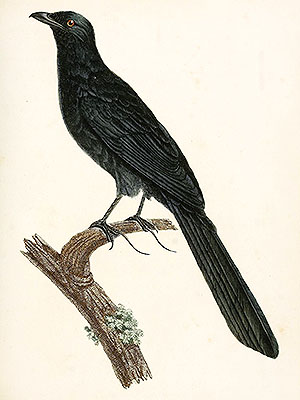
(not in copyright)
*********************
edited: 11.11.2018
Amsterdam Island Rail – gone with the wind
When C. Jouanin and P. Paulian surveyed beds of subfossil bones on Île Amsterdam in the subantarctic Indian Ocean in 1960, they found almost only bones of seabirds, but also some bones of what later was described as the Amsterdam Island Duck (Anas marecula Olson & Jouventin) – and – the mummified body of a middle-sized rail.
The two just wrote some kind of short note [1], that later, in 1977, was translated by Storrs L. Olson.:
„A mummy of a small rail was discovered in a tunnel in a lava flow, under a block that had no doubt protected it from moisture. A sketch was made in situ, as well as taking measurements of the beak (22 mm), the tarsus (40) and the middle toe without claw (34), but the mummy fell to dust when an attempt was made to pick it up. In this case one cannot infer the former existence of a rail peculiar to New Amsterdam, although it would be perfectly likely (endemic species of this order exist on most isolated islands), for the measurements cited coincide with those of a skin of a Corncrake (Crex crex Linnaeus) in the British Museum collected 100 miles to the south of Madagascar. Still, this identification is not wholly satisfactory: the mummy did not have the bulk nor the heavy bill of a Corncrake, and it is most regrettable not to have been able to remove it.“ [2]
The Amsterdam Island Rail very, very, very likely, if not absolutely definitely, was an endemic species, that indeed may have descended from the trampy Corncrake, a species that inhabits parts of western Asia and Europe, but on its migrations, pops up almost everywhere on Earth!
***
Imagine how many such endemic rails may have existed before mankind spread all over the planet, it must have been thousands …!
*********************
References:
[1] C. Jouanin; P. Paulian: Recherche das ossements d’oiseaux provenant de l’île Nouvelle-Amsterdam (Océan Indien). Proceedings of the XIIth International Ornithological Congress, Helsinki: 368-372. 1960
[2] Storrs L. Olson: A synopsis of the fossil Rallidae. In: Sidney Dillon Ripley: Rails of the World – A Monograph of the family Rallidae. Codline. Boston 1977
*********************
edited: 15.10.2018
Did the Cook Islands sandpiper survive into the 19th century?
I just found an interesting little side note in ‘Aves polynesiae: a catalog of the birds of the Polynesian subregion (not including the Sandwich Islands)’ from the 19th century in which the South Sea Sandpiper (Prosobonia cancellata Peale / parvirostris J. F. Gmelin) under the name Phegornis cancellatus is listed for an island called Hervey Island (now the Manuae Atoll in the north of the Cook Islands). [1]
Is that just a mistake or does this little side note refer to a last surviving population of the unnamed Prosobonia species known only from subfossil remains, the remains of which have been found on Mangaia Island in the south of the Cook Islands?
***
I wish I had more time for all this research, but unfortunately, I have to work to live (… actually more work than life at the moment …).
*********************
References:
[1] Lionel K. Wiglesworth: Aves polynesiae: a catalogue of the birds of the Polynesian subregion (not including the Sandwich Islands). Berlin: R. Friedlaender & Sohn 1891 In: Abhandlungen und Berichte des Königl. Zoologischen und Anthropologisch-Etnographischen Museums zu Dresden Bd. 3: 1-84. 1890/91. herausgegeben von Hofrath Dr. A. B. Meyer, Director des Museums
*********************
edited: 10.10.2018
Saint Paul Duck … an ‘extinct’ species that never was?
Saint Paul Duck (Anas sp. ‚Île Saint-Paul‘)
While describing a new extinct bird, the Amsterdam Island Wigeon (Anas marecula) in 1996, the two authors Storrs L. Olson and Pierre Jouventin mentioned an account from the middle of the 18th century, and quoted another author, W. R. P. Bourne.:
„Of far greater interest, however, is the report of the explorer John Barrow, who was on St. Paul Island on 2 February 1793, where he mentioned the presence of „a small brown duck, not much larger than a thrush“ that was „the favorite food of the five sealers living on the island“ (quotes brom Bourne et al. 1983).“ [2][3]
To me, it seems, the two authors did not actually check the original source, John Barrow, here.
Well, but I did …! 😉
***
By the way; another well-known author of bird/extinction-related books, Julian P. Hume (in Extinct Birds; in the 2012 – or in the 2017 edition), even gives a completely wrong source.:
„John Barrow: Some Account of the Public Life, and a Selection from the Unpublished Writings, of the Earl of Macartney. Amsterdam London: T. Cadell and W. Davies. 1806“
I checked that source too! 😉
***
But back to the actual source, what does it really say?
Page 140:
„On the 1st of February we discovered the two islands of St. Paul and Amsterdam, and on the evening of the same day anchored on the eastern side of the latter, at the distance of about a mile from the shore. …“ [1]
The latter one is Amsterdam Island, right?
What follows are several descriptions of the island, of its geology, and some quite interesting philosophical reflections about the fact that some parts of the planet appear to be older/younger than others, and that islands apparently can just appear out of nothing or disappear into nothing, obviously without aid of an unearthly higher being (remember; Darwin’s ‚On the Origin of Species‘ first appeared 66 years after).
… oh, and a list of birds of course.:
Page 147/148:
„The number of birds was likewise astonishing, and the two causeways were strewed with teir eggs. During our short stay on shore we obtained the following birds:
…
Anas, A small brown Duck, not much larger than a thrush, and apparently not described by naturalists.“ [1]
The author still speaks about Amsterdam Island here, so this is the Amsterdam Island Duck (Anas marecula Olson & Jouventin)!
Its this little passage – „A small brown Duck, not much larger than a thrush“ – that apparently was copied again and again by several authors without checking the original source.
***
On page 155 resp. 156, the author reports about five seal hunters, that „all lived in a small miserable hut, as dirty and offensive as that of an Hottentot; and it was surrounded on every side by the dead carcasses of seals and sea-lions.“ [1]
Page 155:
„If the smoke and the fires of Amsterdam Island had excited our curiosity, the discovery of two or three human being running along the shore, as our ships approached it, on so miserable a spot, and so distant from any other land except the little neighboring island of St. Paul, caused a still greater degree of astonishment. …“ [1]
This passage clearly still refers to Amsterdam Island!
***
Page 156:
„The birds, they observed, had a strong fishy taste, to which, however, long habit had reconciled them: those that were the least so were the blue petrel and the little brown duck.“ [1]
There again, the small duck from Amsterdam Island!
***
The Amsterdam Island Wigeon clearly survived into the 18th century, since it is clearly that bird that is mentioned in the so often (incorrectly) cited quotes. There may a duck have existed on the Île Saint-Paul, however, up to now there is no proof for that assumption!
*********************
References:
[1] John Barrow: A voyage to Cochinchina, in the years 1792 and 1793. To which is annexed an account of a journey made in the years 1801 and 1802, to the residence of the chief of the Booshuana nation. London: printed for T. Cadell and W. Davies 1806
[2] W. R. P. Bourne; A. C. F. David; C. Jouanin: Probable Garganey on St. Paul and Amsterdam Islands, Indian Ocean. Wildfowl 34: 127-129. 1983
[3] Storrs L. Olson; Pierre Jouventin: A new species of small flightless duck from Amsterdam Island, southern Indian Ocean (Anatidae: Anas). The Condor 98(1): 1-9. 1996
*********************
edited: 08.10.2018
Leybold’s Firecrown
Leybold’s Firecrown was described in 1870 as a full species, but was later downgraded to subspecific level under the Juan Fernández Firecrown and is now known as Alejandro Selkirk Firecrown (Sephanoides fernandensis ssp. leyboldi (Gould)).
***
Let’s just start with something completely different to make all of this even more complicated!
The Juan Fernández Archipelago consists of three islands, which were originally named in 1574 as Más a Fuera, Más a Tierra, and Santa Clara.
The archipelago is primarily known for having been the home to the marooned sailor Alexander Selkirk in the very early 18th century, which again was the template for Daniel Defoe’s Robinson Crusoe. The islands are now named Isla Alejandro Selkirk, Isla Robinson Crusoe, and, well, Santa Clara respectively. Robinson Crusoe Island is the largest of the three, while Santa Clara, about 1 km southwest is merely a snipped crumb of it. Alejandro Selkirk, however, is located 180 km further west.
The islands contain many endemic animals and plants, and, among the birds are home for at least two species of hummingbirds, the endemic Juan Fernández Firecrown (Sephanoides fernandensis (King)) and the Green-backed Firecrown (Sephanoides sephaniodes (Lesson, RP & Garnot)), which inhabits Argentina and Chile and comes to the Juan Fernández archipelago only during the warmer parts of the year (… perhaps only to annoy the endemic species!).

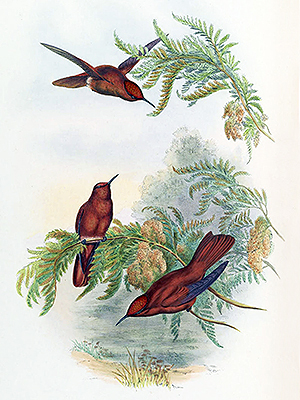
Depictions from: ‘John Gould: A Monography of the Trochilidae, or family of humming-birds. London: Printed by Taylor and Francis 1861’
(public domain)
***
Let’s now move the Juan Fernández Firecrown itself, which for some time was also somewhat a mysterious bird.
The species was described in 1831, yet both sexes are so dissimilar that they immediately were described as two distinct species, the male as Trochilus fernandensis and the female as Trochilus stokesii (both by Capt. Philip P. King in „Proceedings of the Committee of Science and Correspondence of the Zoological Society of London 1: 30. 1831“).
John Gould in his hummingbird monograph [1] followed that by naming them es Eustephanos fernandensis and Eustephanos stokesii respectively, and, somewhat funny, wondered if he would ever get to see a female E. stokesii.
„Some of them are more richely coloured than others, but all have the metallic green crown; the question then arises, has the female this character as well as the male, or did Mr. Bridges procure males only?“ [1]
Well, no, they all were females!
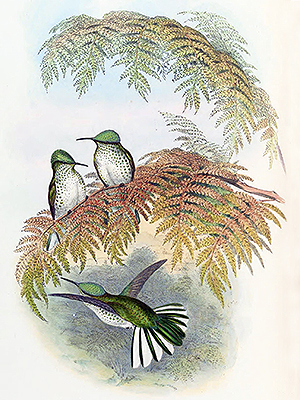
Depictions from: ‘John Gould: A Monography of the Trochilidae, or family of humming-birds. London: Printed by Taylor and Francis 1861’
(public domain)
***
He corrected himself later in the supplement of his monograph [2], and by the way also introduced the second (sub)species.:
„… such a case is the present, in which, from lack of the requisite knowledge, I figured the two sexes of the Cinnamon Firecrown as distinct species, under the names of E. fernandensis and E. stokesii; and now that I am giving for the first time a Plate of the more recently discovered E. leyboldi, I have seized the opportunity to refigure the two sexes of E. fernandensis.“ [2]
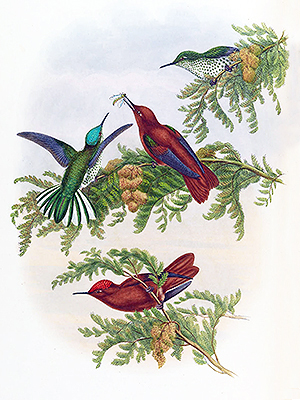
Depictions from: ‘John Gould: A Monograph of the Trochilidae, or family of humming-birds. Supplement. London: Henry Sothern & Co. 1887’
(public domain)
***
Let‘s talk about the differences between the two forms.:
S. f. ssp. leyboldi:
male: the glowing golden feathers on the crown stretch onto the neck
female: the back is more yellowish green instead of bluish green to green; the tail feathers with a far less amount of white.
The nominate race is endemic to Más a Tierra (Robinson Crusoe), while the ssp. leyboldi is supposed to have been endemic to Más a Fuera (Alejandro Selkirk).
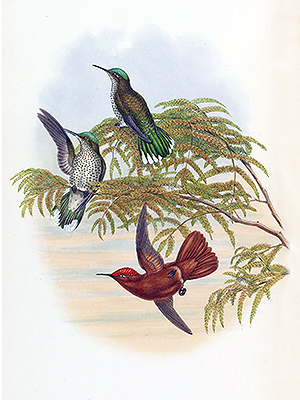
Depictions from: ‘John Gould: A Monograph of the Trochilidae, or family of humming-birds. Supplement. London: Henry Sothern & Co. 1887’
(public domain)
***
Let’s now take a look at the archipelago’s wonderful flora …! [5][6]
These are the plant species that are native (mostly endemic) to Isla Robinson Crusoe and that are known to be utilised by the Juan Fernández Firecrown.:
Centaurodendron dracaenoides Johow
Cuminia fernandeziana Colla
Dendroseris litoralis Skottsb.
Dendroseris macrantha (Bertero ex Decne.) Skottsb.
Eryngium bupleuroides Hook. & Arn.
Escallonia callcottiae Hook. & Arn.
Nicotiana cordifolia Phil.
Notanthera heterophyllus G. Don.
Ochagavia elegans Phil.
Raphithamnus venustus (Phil.) Rob.
Sophora fernandeziana (Phil.) Skottsb.
The most important endemic plant for the hummingbirds is Raphithamnus venustus (Phil.) Rob., a beautiful shrub with violet flowers, because it is the only native plant that flowers during the winter, thus is extremely important for the survival of the Juan Fernández Firecrown. The males often build their territory around such a shrub, and vigorously chase away other birds, including females except in the breeding season.
And these are the native plant species that occur (native or endemic) on Isla Alejandro Selkirk..:
Dendroseris regia Skottsb.
Eryngium sarcophyllum Hook. & Arn.
Nicotiana cordifolia Phil.
Raphithamnus venustus (Phil.) Rob.
Sophora masafuerana (Phil.) Skottsb.
They are not always conspecific, but at least congeneric, and Raphithamnus venustus does occur on this island as well, so …?
By the way, the first real inventure of Masafuera’s flora was made by Carl Skottsberg at the beginning of the 20th century [5], the island was already nearly completely denuded at that time by introduced goats, and there were only traces left of the former forests. It is thus no wonder that no hummingbird has survived there.
***
What do others think?:
Federico Johow, either Friedrich Richard Adalbert Johow, the German-Chilean botanist and biologist born 1959 and now (in 2018) 159 years old, or, more likely, someone with just the same name, has done some research on the same matter in 2007, and has found only four persons who have claimed to have seen hummingbirds on Isla Alejandro Selkirk.:
Augustín Guajardo, a botanist that has worked in the archipelago in 1869, Friedrich Johow (named as Federico Johow), the one mentioned above, Carl Skottsberg, and finally R. A. Philippi Bañados, a zoologist that has worked on the islands in 1928.
I could only find two of the abovementioned accounts, and I will generously share them with you here. 😉
Friedrich Johow:
„Eustephanus galeritus Mol. – Masatierra. En chile solamente durante el invierno. – Nombre vulgar en Juan Fernandez: Picaflor chico.
Eustephaus fernandensis King. – Endémico en Masatierra. – Nombre vulgar: Picaflor grande.
Eustephanus leyboldi Gould. – Endémico en Masafuera (*)
…
(*) Opinamos que esta especie, fundada en ejemplares mal conservados, es idéntica con el E. fernandensis de Masatierra. A lo ménos, no nos fué posible descubrir diferencia alguna entre los ejemplares que cazamos en una i en otra isla.“
Translation:
„Eustephanus galeritus Mol. – Masatierra. In Chile only during the winter. – Common name in Juan Fernandez: Picaflor chico.
Eustephaus fernandensis King. – Endemic in Masatierra. – Common name: Picaflor grande.
Eustephanus leyboldi Gould. – Endemic in Masafuera (*)
…
(*) We believe that this species, founded on poorly preserved specimens, is identical with E. fernandensis of Masatierra. At least, it was not possible for us to discover any difference between the specimens we hunted on one island and another island.“[3]
Carl Skottsberg:
„Die Kolibris gehören auf Masatierra zu den bedeutungsvollen Bestäuber[n]. Früher kam E. fernandensis – denn E. Leyboldii ist höchstwahrscheinlich mit ihm identisch – ebenfalls auf Masafuera vor, wo ich im August 1908 mehrere beobachtete. Im [Jahr] 1917 bekamen wir keinen einzigen zu sehen; er scheint hier ausgestorben, was übrigens keinen, der das Schicksal Masafueras kennt, überraschen wird.“
Translation:
„The hummingbirds belong on Masatierra to the significant pollinators. Formerly, E. fernandensis – because E. Leyboldii is most likely identical with it – also occurred on Masafuera, where I observed several in August 1908. In 1917 we did not get to see a single one; it seems to be extinct here, which by the way, will not surprise anyone who knows the fate of Masafuera.”[4]
***
The Juan Fernández Firecrown is said to be quite variable, especially the females, I personally have no access to any specimens nor do I know of any scientific assay that deals with that matter; and of course, the specimens used for the description of Leybold’s Firecrown are lost now, so my last words in this case are: Leybold’s Firecrown very likely should not be treated as a full species but indeed as a subspecies, it has in fact existed, and it is now extinct.
… uff, that was quite an amount of letters …. 😛
*********************
source:
[1] John Gould: A Monograph of the Trochilidae, or family of humming-birds. London: Printed by Taylor and Francis 1861
[2] John Gould: A Monograph of the Trochilidae, or family of humming-birds. Supplement. London: Henry Sothern & Co. 1887
[3] Friedrich Johow: Estudios sobre la flora de las islas de Juan Fernandez. Santiago de Chile, Imprenta Cervantes 1896
[4] Carl Skottsberg: Pollinationsbiologie und Samenverbreitung auf den Juan Fernandez-Inseln. 503-547. 1928. In: The Natural history of Juan Fernandez and Easter Island, edited by Carl Skottsberg. Vol. 2., Botany. Uppsala: Almqvist & Wiksells Boktryckeri, 1920-1953
[5] C. Skottsberg: Derivation of the Flora and Fauna of Juan Fernandez and Easter Island, Part 1. The Juan Fernandez Islands. 193-438.In: The Natural history of Juan Fernandez and Easter Island, edited by Carl Skottsberg. Vol.1., Geography, Geology, Origin of island life. Uppsala: Almqvist & Wiksells Boktryckeri, 1920-1956
[6] Michael S. Roy, Juan Carlos Torres-Mura, Fritz Hertel, Marina Lemus and Renate Sponer: Conservation of the Juan Fernandez firecrown and its island habitat. Oryx 33(3): 223-232. 1999
[7] Federico Johow: El picaflor de la Isla de Masafuera: ¿Subespecie extinta, nunca existió o Mistery Bird?. Boletín Chileno de Ornitología 13: 28-41. 2007
*********************
edited: 02.10.2018
Levaillant’s Blue-tailed Lory
Levaillant’s Blue-tailed Lory is another mysterious lory ‚described‘ at the very beginning of the 19th century by François Le Vaillant on the basis of a single specimen (alive or dead?).
The bird is very similar in many aspects to the Red Lory (Eos bornea (L.)), a species that does not occur on the island of Borneo, Indonesia, but on several small islands within the Maluku island group, Indonesia, namely Ambon, Buru, Saparua, Seram, Haruku, and the Kai Islands.
The mysterious lory differs from the Red Lory actually only in its name-giving blue tail.
The bird was never scientifically described, and since F. Le Vaillant wasn’t a fan of C. von Linné‘s binominal nomenclature system, it was only ever named as ‚Le Perroquet Lori a queue bleue‘, as ‚The Lori Parrot with a blue tail‘.
Here is the important part of Levaillant’s ‚description‘.:
„…
Le plumage général, c‘est-à-dire, celui de la tête, du cou, du dos, du croupion; les plumes des jambes du Lori à queue bleue, sont d’un rouge foncé, tirant au cramoisi. Toutes les couvertures des ailes sont du rouge cramoisi du corps, à l’exception de trois ou quatre de celles du millieu, qui sont bleu-foncé; queles autres de celles du millieu et les plus grandes sont lisérées de bleu. Les scapulaires, les deux dernières plumes des ailes près du dos, le bas-ventre et la queue entière, sont aussi bleus. Les grandes pennes alaires sont d’un noir brun. Le bec est d’un jaune d’ocre, et les pieds sont noirs.
L’espèce du Lori à queue bleue se trouve plus communément à l’île Bornéo. L’individu que nous en avons figuré de grandeur naturelle, fait partie de la belle collection de M. Raye de Breukelervaert, à Amsterdam.“
Translation:
„…
The general plumage, that is to say, that of the head, neck, back, rump; the feathers of the blue-tailed Lori’s legs are dark red, scarlet-crimson. All the wing coverts are crimson red, with the exception of three or four of the middle ones, which are dark blue; the others from the middle and the larger ones are marked with blue. The scapulars, the last two feathers of the wings near the back, the lower abdomen and the whole tail, are also blue. The large wing tips are black-brown. The beak is ochre yellow, and the feet are black.
The Blue-tailed Lori is more commonly found on Borneo Island. The individual that we have figured in natural size, is part of the beautiful collection of Mr. Raye de Breukelervaert, from Amsterdam.“ [1]
***
What or who is this Blue-tailed Lori?
Well, if F. Le Vaillant did only see a dead, a stuffed bird, this may in fact just have been a Red Lory lacking its actual tail, which had been replaced by the blue tail of any other parrot species – this method was actually quite common in these days, either to complete a incomplete specimen or even to make a complete new species, a fake species if you want, something unique that could earn high prizes other collectors in search for something unique for their collection were often willing to pay.
There existed many such collections in the 18th and early 19th century, containing real natural treasures but also things like unicorn horns, dried mermaids, and, of course fake bird species, especially birds of paradise and parrots.
It is also interesting that the island of Borneo is given as the place of origin. The bird may very well have been bought on a bird market on that island to end up as a corpse in a collection in the Netherlands, but, being definetely a member of the genus Eos, it clearly was not native to that island.
My last words here: Levaillant’s Blue-tailed Lory very likely is just a Red Lory with a fake tail.
*********************
source:
[1] François Le Vaillant: Histoire naturelle des perroquets, Paris Levrault, Schoell & Cie, An IX-XII. 1801–1805
*********************
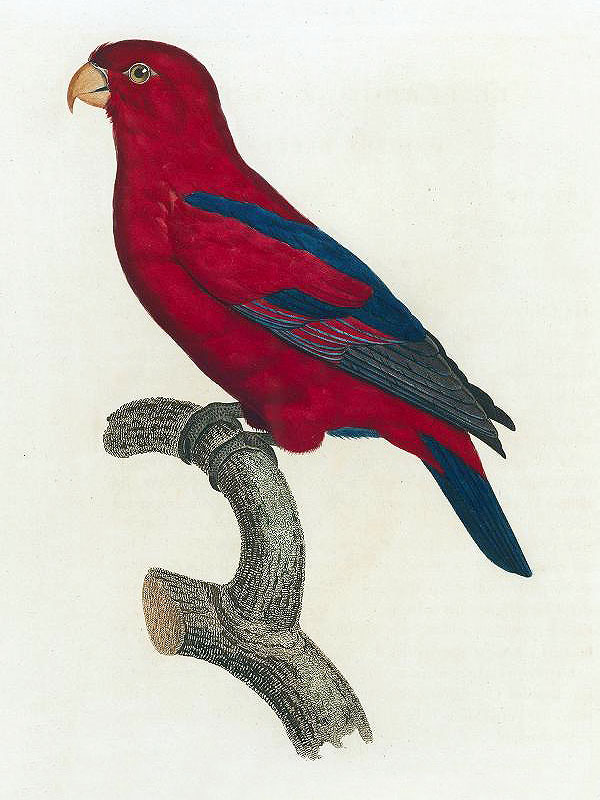
(public domain)
*********************
edited: 02.10.2018
Unicolored Lory
The Unicolored Lory (Eos unicolor (Shaw)) is a bright red colored parrot, that is known from a single drawing and the annotated description in François Le Vaillant‘s ‚Histoire naturelle des perroquets‘ from the very early 19th century.
There were two individuals known at that time, kept in captivity in the Netherlands, from which one was depicted.:
„L’uniformité de la coleur du plumage de ce Lori nous a déterminé à lui donner le surnom d’unicolore; et cette coleur est d’un rouge pâle sur la tête, le cou, la poitrine, l’estomac, le ventre et les couvertures du dessous de la queue. Le manteau et le croupion, les couvertures des ailes et celles de la queue, lla queue elle-même, sont aussi rouges, mais d‘un noir brun vers leur pointe. Le bec est rouge, et les pieds sont d‘un brun terreux.
L’espèce de ce Lori se trouve aux Moluques. M. Temminck, d’Amsterdam, qui avoit deux de ces oiseaux dans sa belle collection, eut la bonté de m’en donner un. Ces deux individus sont les seuls de l’espéce que j’aie jamais vus.“
translation:
„The uniformity of the color of the plumage of this Lori has determined us to give him the moniker nickname; and this color is pale red on the head, neck, chest, stomach, belly, and undertail coverts. The mantle and the rump, the coverts of the wings and those of the tail, the tail itself, are also red, but of a dark brown towards their point. The beak is red, and the feet are of an earthy brown.
The species of this Lori is found in Maluku. M. Temminck from Amsterdam, who had two of these birds in his fine collection, was kind enough to give me one. These two individuals are the only ones of the species I have ever seen.“ [1]
***
The Maluku Islands were a Dutch colony (at least in parts), so it’s no wonder that birds cought there were transported to Amsterdam.
***
Since the Unicolored Lory is now known exclusively from the single drawing in ‚Histoire naturelle des perroquets‘, some zoologists think that this depiction may in fact simply show a Cardinal Lory (Chalcopsitta cardinalis (G. R. Gray)) from the Solomon Islands. This species, however, is not that unicolored but has a bright red underside and a rather dull cherry-red upper side, a longer tail, as well as a patch of bare skin around its beak.
The drawings made by Jacques Barraband are not just only very good, they are in fact scientifically correct, even for modern standards, so the Unicolored Lory can indeed be identified as a member of the genus Eos. This genus contains at least six species, that all are confined to the islands in the Banda Sea (the Maluku Islands and some islands off western New Guinea), Indonesia. All of these species are mainly bright red colored, with more or less amounts of bright blue areas.
There is a slight possibility that the two birds kept in captivity, were of hybrid origin, but this leads to the question for the parent species, since all other known congeneric species bear at least some blue in their plumage, while the Unicolored Lory was completely red.
The Maluku Islands, especially the smaller islands, are heavily deforested and the original forest has been replaced by plantations, this has probably already begun in the 14th century, when the islands were discovered by Arab merchants. Most of the endemic lory species are now heavily threatened with extinction, and at least two taxa (the Red-and-blue Lory (Eos histrio ssp. histrio (Statius Müller)), and the Talaud Red-and-blue Lory (Eos histrio ssp. talautensis Meyer & Wiglesworth)) are already completely extinct.
The Unicolored Lory may have been restricted to a single, small island within the region, and its population may already have been very low due to deforestation and hunting, when the two individuals were caught and brought to the netherlands
There is no obvious reason why the Unicolored Lory should not have existed!
*********************
References:
[1] François Le Vaillant: Histoire naturelle des perroquets, Paris Levrault, Schoell & Cie, An IX-XII 1801–1805
*********************
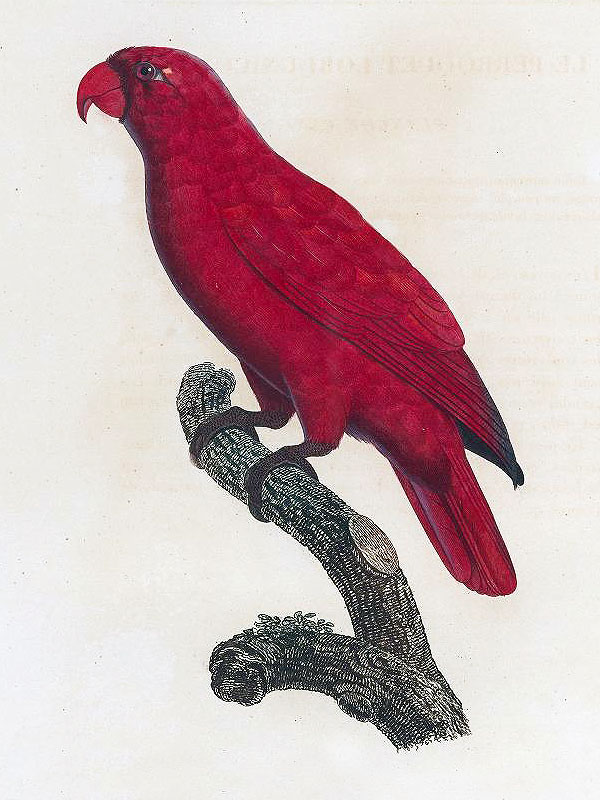
(public domain)
*********************
edited: 30.09.2018
Bruner’s Rail
Bruner’s Rail (Cacroenis inornatus Bruner) is a very enigmatic species of rail supposed to have been endemic to the Tuamotu Archipelago, whose name repeatedly appears in listings of extinct birds and other publications. [4]
***
Yet, this species has never existed, but see for yourself.:
The name first appears in the “Field guide to the birds of French Polynesia” from 1972, obviously the first book about the birds of French Polynesia, and full of errors, some of them bad, others worst. [3]
The story begins right with the discovery of the Cocos Finch in 1843.: [1][2]
“This bird, which is in all probability a female, is from Bow Island, and is, I believe, the only insessorial form that has been brought from thence. Only a single example was procured, and its principal interest consists in its forming an additional species of a small group of birds inhabiting the Galapagos, to which islands they had hitherto appeared to be peculiar. …
Bow Island has truly little to boast of in its ornithology, since the only birds seen by us during a residence of six weeks at this Atol coral island were doves, the above new species of Cactornis, plover, a few black and white tern which appear attached to these situations, and herons; and none of these were at all numerous. The Cactornis inornatus was usually noticed about the lowly bushes of Petesia carnea, the succulent fruit of which most probably constitutes its chief food.”
***
Bow- or La Harpe Island, both are old names for the Hao atoll in the middle of the Tuamotu Archipelago, French Polynesia, and the plant mentioned in the text, Petesia carnea, is now known as Psychotria carnea (G. Forst.) A. C. Sm., a species that is native to Fiji and Tonga, and that has never existed in the Tuamotu Archipelago.
***
The bird is mentioned in the “Field guide to the birds of French Polynesia” [as Cacroenis inornatus] as being confusing and obscure but also as being small, speckled and generally brownish in appearance; it appears in a checklist at the end of the book [this time as Cactornis inornatus] as having been introduced to the Archipelago, which is complete bullsh**!
***
The Cocos Finch is now named as Pinaroloxias inornata (Gould), however, how this finch-like tanager finally ended up as a extinct rail species is still not known to me.
*******************
[1] John Gould: On nine new birds collected during the voyage of H.M.S. Sulphur. Proceedings of the Zoological Society of London 11. 103-107. 1843
[2] John Edward Gray; John Gould; John Richardson; Richard Brinsley Hinds and others: The zoology of the voyage of H.M.S. Sulphur: under the command of Captain Sir Edward Belcher, during the years 1836-42. London: Smith, Elder 1843-1846
[3] Phillip L. Bruner; O. G. Dykes: Field guide to the birds of French Polynesia. Bishop Museum Press 1972
[4] Greg Sherley; Rod Hay: Review of avifauna conservation needs in Polynesia. Bird Conservation Priorities and a Draft Avifauna Conservation Strategy for the Pacific Islands Region 10-17. 1999
********************

Depiction from: ‘John Edward Gray; John Gould; John Richardson; Richard Brinsley Hinds and others: The zoology of the voyage of H.M.S. Sulphur: under the command of Captain Sir Edward Belcher, during the years 1836-42‘
(public domain)
*******************
edited: 26.09.2018
The Tahitian Mountain ‚Goose‘
There exists an almost unknown contemporaneous account from the 18th century, made by James Morrison, boatswain’s mate aboard the famous or infamous ‚Bounty‘, who made mention of a mysterious bird [… and how I love mysterious birds …!].:
“… the mountains produce birds of different kinds unknown to us, among which are a large bird nearly the size of a goose, which is good food; they are never observed near the sea nor in the low lands.” [1]
***
So, usually called the Tahiti Goose, Tahitian Goose, or Tahitian Mountain Goose – what are we talking about here actually?
We very probably do not talk about a goose, but why?
First we have to take into account who made the report:
A boatswain’s mate from the 18th century very likely was not a zoologist, but may in fact have known at least several European birds, especially poultry, so very likely knew chickens, doves, ducks, and geese, and very likely also quails, partridges and other so called game birds.
As a seafarer he perhaps may have had some good knowledge about seabirds, and probably could very well tell several species of them apart from each other.
These are the birds that we can just sort out, but what may it have been then?
Well, the Tahitian Mountain ‚Goose‘ apparently was a somewhat large, terrestrial bird, more or less the size of a feral goose, it was ‚good food‘ so it must have been easy to catch, it probably [actually very likely to almost certainly] was flightless, and it was unlike any bird known to ‚us‘, to the sailors of the ‚Bounty‘.
In my opinion, and in that of many others, the Tahitian Mountain ‚Goose‘ almost certainly was a kind of rail, a large, flightless rail, maybe a species from the widespread genus Porphyrio, somewhat like a Tahitian version of the New Zealand Takahe (Porphyrio mantelli (Owen)).
However, there is of course the chance that the Tahitian Mountain ‚Goose‘ was something completey different, we probably will never know for sure.
… mysterious ….
*********************
References:
[1] J. M. Derscheid: An unknown species – the Tahitian Goose. Ibis 81: 756-760. 1939
*********************
edited: 22.09.2018
Mysteriöse Papageien aus Polynesien
Ich hatte hier bereits über eine hypothetische Papageienart geschrieben, die einst auf der Insel Bora Bora im Gesellschaftsarchipel vorgekommen sein mag.
***
Ich möchte nun über ein paar sehr interessante Überlieferungen schreiben, die von Teuira Henry (1847-1915), einer tahitianischen Pädagogin, Ethnologin, Folkloristin, Historikerin, Linguistin und Gelehrten, in einem Manuskript hinterlassen wurden, das sie zu Lebzeiten aus den Stücken eines verlorenen Manuskripts rekonstruierte, das in den Jahren zwischen 1817 und 1856 ursprünglich von ihrem Großvater verfasst wurde. Es enthielt bedeutende Beiträge an mündlicher Folklore, Genealogie, Geschichte, Mythen und traditionellem Wissen wie Astronomie und Navigation. Ihr Manuskript wurde 1928 posthum vom Bernice Pauahi Bishop Museum als “Ancient Tahiti” veröffentlicht. [1]
***
Im Jahr 2006 schrieb Philippe Raust einen kleinen Artikel [2] über neu entdeckte und beschriebene Papageienarten, deren subfossile Überreste in Französisch Polynesien gefunden worden waren, er erwähnte hierbei auch die alten tahitianischen Namen einiger dieser Papageien, von denen einige jedoch immer noch keiner bekannten Art zugeordnet werden können.:
“… Peut être étaient-ce le vini-pa-tea perroquet de couleur pourpre à gorge blanche commun à toutes les îles de la Société et le vini-pa-uri de Pora Pora entièrement rouge décrit par T. Henry dans Tahiti au temps anciens? Il est connu que les plumes rouges étaient recherchées dans les sociétés polynésiennes préeuropéennes où elle symbolisaient le pouvoir des chefs; c’est peut être à cause de cela que ces espèces, trop chassées, ont disparu. T. Henry cite aussi le vini- rehu (perroquet sifleur gris), le tētē (perroquet noir de la Société), le ‘ura (perroquet rouge des montagnes) et le ‘a’a taevao (‘a’a sauvage des îles-sous-le-vent), le tavae (au plumage brillant et multicolore de Motu Iti, Tupai et Maupiha’a): cela fait au moins six espèces de perroquets, perruches et loris qui sont rapportés par la tradition.”
Übersetzung:
“… Vielleicht waren es der vini-pa-tea Papagei von purpurner Farbe mit weißem Hals, der allen Inseln der Gesellschaft gemein war, und der völlig rote vini-pa-uri von Pora Pora [Bora Bora], die von T. Henry in ‘Ancient Tahiti’ beschrieben wurden? Es ist bekannt, dass rote Federn in voreuropäischen polynesischen Gesellschaften begehrt waren, da sie die Macht der Häuptlinge symbolisierten; dies könnte der Grund sein, warum diese überjagten Arten verschwunden sind. T. Henry benennt auch den vini-rehu (grauer pfeifender Papagei), den tētē (schwarzer Papagei der Gesellschaftsinseln), den ‘ura (roter Bergpapagei) und den ‘a’a taevao (wilder ‘a’a der Inseln unter dem Winde), der tavae (mit strahlendem und buntem Gefieder von Motu Iti, Tupai und Maupiha’a): dies macht mindestens sechs [sieben!] Arten von Papageien, Sittichen und Loris, über die Überlieferungen existieren.“
***
Nun haben wir hier also offenbar sieben Papageienarten, aber welche davon ist welche?
‘a’a taevao – Raiatea-Sittich (Cyanoramphus ulietanus (Gmelin))
tavae – Rubinlori (Vini kuhlii (Vigors) ssp. ‘Bora Bora’) ?
tētē – Schwarzstirnsittich (Cyanoramphus zealandicus (Latham))
‘ura – ein mehr oder weniger komplett rot gefärbter Papagei, der offenbar nach seiner Farbe benannt wurde
vini-pa-tea – Saphirlori (Vini peruviana (Statius Müller))
vini-pa-uri – Rubinlori (Vini kuhlii (Vigors) ssp. ‘Bora Bora’) ?
vini-rehu – ein grauer Papagei [?] der pfeifende Geräusche macht, wie dem auch sei, rehu bedeutet jedenfalls nur grau; eventuell ein juveniler Saphirlori?
***
Die Gesellschaftsinseln waren die Heimat von mindestens fünf wissenschaftlich beschriebenen Papageienarten, die entweder anhand alter Überlieferungen bekannt sind oder anhand von subfossilen Überresten, außerdem gab es eine weitere Art, die heute auf eine einzige Population auf nur einer Insel im Australarchipel reduziert ist, früher aber viel weiter verbreitet war.
Nur ganze zwei davon existieren auch heute noch und nur eine davon bewohnt zumindest noch winzige Reste ihrer einstigen Heimat – der unfassbar schöne Saphir- oder Tahiti-Lori (Vini peruviana).
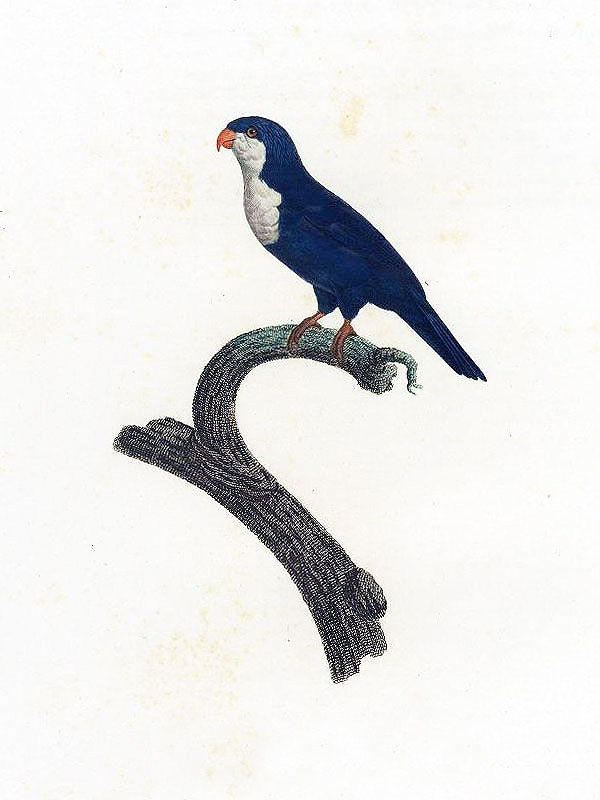
Darstellung aus: ‘François Le Vaillant: Histoire naturelle des perroquets. Paris: Levrault, Schoell & Cie. An IX-XII. 1801–1805’
(public domain)
*********************
Quellen:
[1] Teuira Henry: Ancient Tahiti. Bishop Museum Bulletins 48: 1-651. 1928
[2] Philippe Raust: Les Psittacidés disparus de Polynésie Francaise. Te Manu: Bulletin de la Société d’Ornithologie de Polynésie 56. Septembre 2006
*********************
bearbeitet: 17.09.2018
04.05.2018
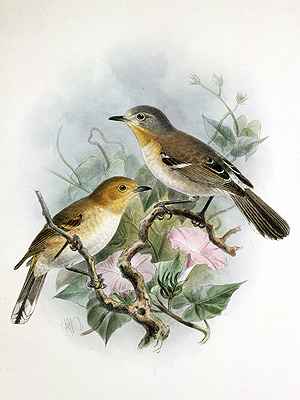
***
Die Elepaios, bis vor kurzem als eine Art mit fünf Unterarten betrachtet, sind auf den Hawai’i-Inseln endemisch verbreitet, wo sie aber auf die Inseln Hawai’i, Kaua’i und O’ahu beschränkt sind.
Die Vögel erreichen eine Größe von etwa 14 cm.
Die Elepaios kommen nicht auf den Inseln vor die vormals Maui Nui formten, Kaho’olawe, Lana’i, Maui und Moloka’i, ein Verbreitungsmuster, das im biogeografischen Sinn recht unlogisch ist.
Es gibt jedoch mindestens einen zeitgenössischen Bericht, der darauf hindeutet, dass dies nicht immer so gewesen ist.:
„It seems worth while recording that an old native who accompanied me on my Moanui trip said that he had heard from his father “that a long time ago there was on Molokai a small brown bird that ran on the ground but could not fly,” but that they had all been dead for a long time. He gave its name as Moho (Pennula). He also said that his father had told him of the Elepaio (Chasiempis) being on Molokai in the olden time. Mr. Theodore Meyer substantiated this report by saying that when he was a boy it was generally known to the old natives that both the Moho and Elepaio had been plentiful, but that they had long ago died out.“
Übersetzung:
„Es scheint lohnend zu erwähnen, dass ein alter Einheimischer, der mich auf meinem Moanui-Trip begleitete sagte, dass er von seinem Vater hörte, “dass vor langer Zeit auf Molokai ein kleiner brauner Vogel lebte, der am Boden rannte aber nicht fliegen konnte”, aber dass sie alle längst tot seien. Er nannte ihn Moho (Pennula). Er sagte auch, dass sein Vater ihm erzählte, dass es den Elepaio (Chasiempis) in alten Zeiten auf Molokai gab. Mr. Theodore Meyer bestätigte diesen Bericht indem er sagte, als er ein Junge war, wussten die alten Einheimischen sehr wohl vom Moho und vom Elepaio, dass sie aber vor langer Zeit ausgestorben sind.“
[W. A. Bryan: Some Birds of Molokai. Bishop Museum Occasional Papers 4(2): 43-86. 1908
***
Das Vorkommen lokaler Elepaio-Formen auf diesen Inseln muss trotz oben aufgeführtem zeitgenössischen Bericht immer noch als hypothetisch gelten, da die archäologischen Fundstätten auf diesen Inseln, trotz der vielen dort gefundenen Knochen kleiner passeriner Vögel nie Reste von Elepaios hervorbrachten.
***
Die heutigen Elepaios werden als drei Arten betrachtet, eine auf der Insel Hawai’i, eine auf Kaua’i, eine auf O’ahu.
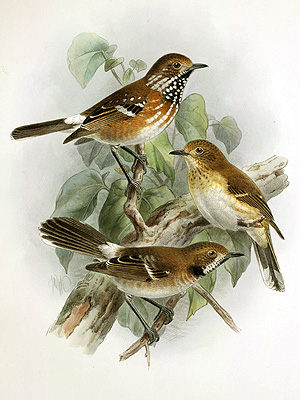
***
Die Art der Insel Hawai’i wiederum umfasst drei geografisch voneinander getrennte und verschieden gefärbte Formen, die vormals als eigenständige Unterarten betrachtet wurden, heute aber als Farbmorphen gelten, die in ihrer Färbung an ihren jeweiligen Lebensraum angepasst sind (… dunkler in feuchteren Regionen, heller in trockeneren …). Eine dieser drei Formen jedoch unterscheidet sich genetisch bereits so weit von den beiden anderen, dass man von einer sich entwickelnden neuen Unterart sprechen könnte.
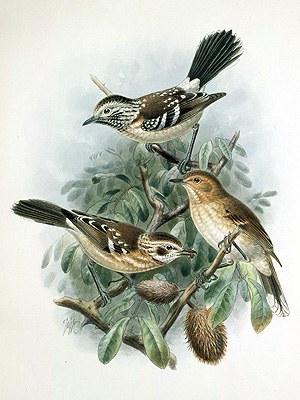
alle Darstellungen aus: ‘Walter Rothschild: The Avifauna of Laysan and the neighbouring islands with a complete history to date of the birds of the Hawaiian possession. 1893-1900’
(in public domain)
***
Die Elepaios gehören zu den Monarchschnäppern (Monarchidae), im Gegensatz zu nahezu sämtlichen anderen endemischen Vogelformen der Hawai’i-Inseln stammt der Urahn der Elepaios also nicht aus Nordamerika sondern aus Australasien.
Außerdem haben es die Elepaios geschafft, sich den veränderten Umweltbedingungen anzupassen, die die Inbesitznahme der Inseln durch den Menschen mit sich brachten, vor allem scheinen die Vögel gegen eingeschleppte Vogelkrankheiten immun geworden zu sein.
*********************
geändert 04.05.2018
